LGBTQ History
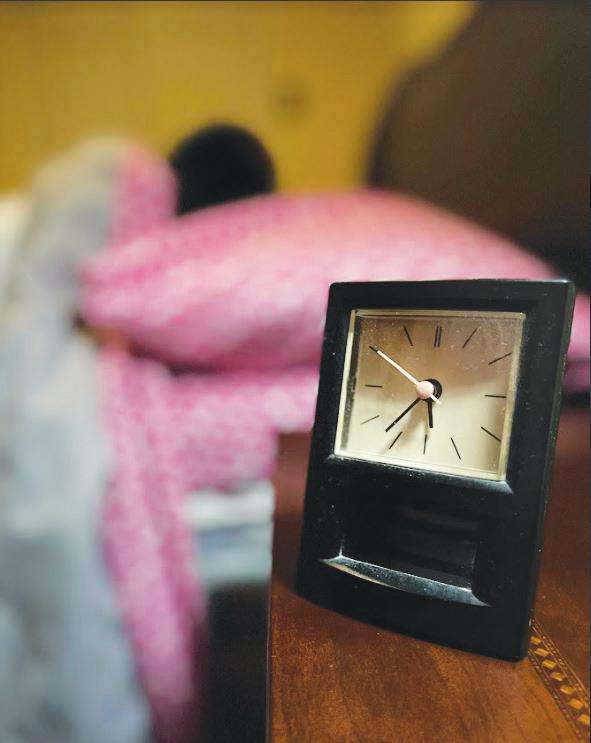
December 14, 2022 Volume 58, Issue 3
4141
75001
Informing Greenhill since 1966
Spring Valley Road, Addison, TX
Students react to the new LGBTQ history elective which will be o ered in the Upper School 2023-2024 course curriculum. Page 9 Open Mic e Arts Board has organized several Open Mic events for students to showcase their talents and support their friends. Page 16 Ever green the Everything Greenhill
Sacrificing Sleep How reaching for success has cost students a good night’s rest. Page 12 Holiday Giving
Photo Illustration by Khushi Chhaya
Junior Quinn Graves and three friends run Jingle Bell Mistletoe, an organization that sells mistletoe to raise money for local food banks. Page 6
Middle and Upper School admission events are becoming more personalized as the school implements a new “choose your own adventure” style of introducing prospective students to Greenhill.
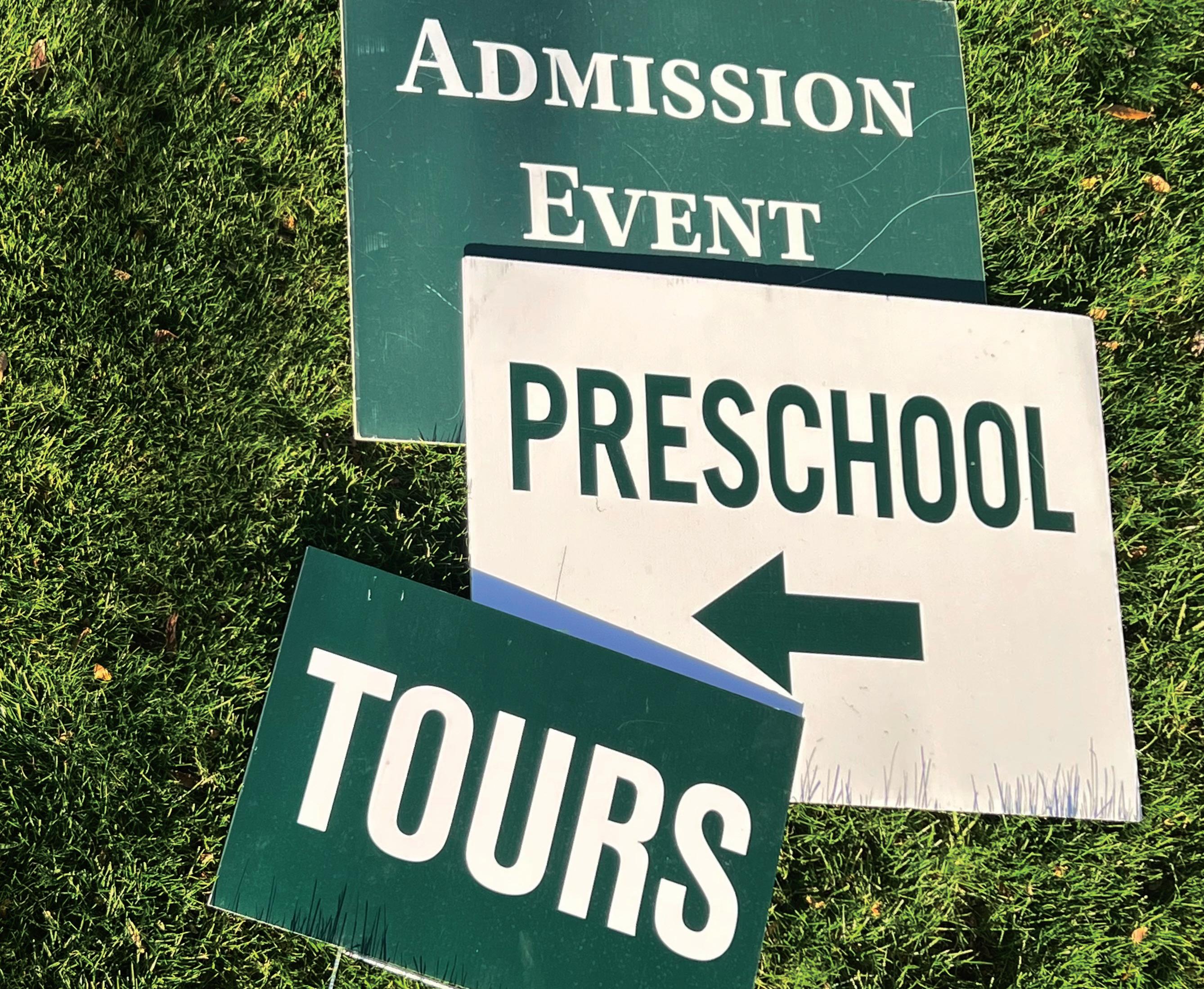
At an Admission Preview held at the end of October, changes included three breakout sessions, during which attendees chose between several short meetings held by members of di erent departments.
Director of Admission and Enrollment Maryanna Phipps says she hopes the events will allow families to get a fuller perspective on the school.
“Anyone can show a curriculum guide of their courses,” said Phipps. “But giving people the opportunity to really see and feel what it is like in our classrooms and how we deliver our program is what shows o our teaching and learning and allows the faculty and [students] to shine.”
is year, the O ce of Admission held conversations about how autonomy may be more bene cial for families.
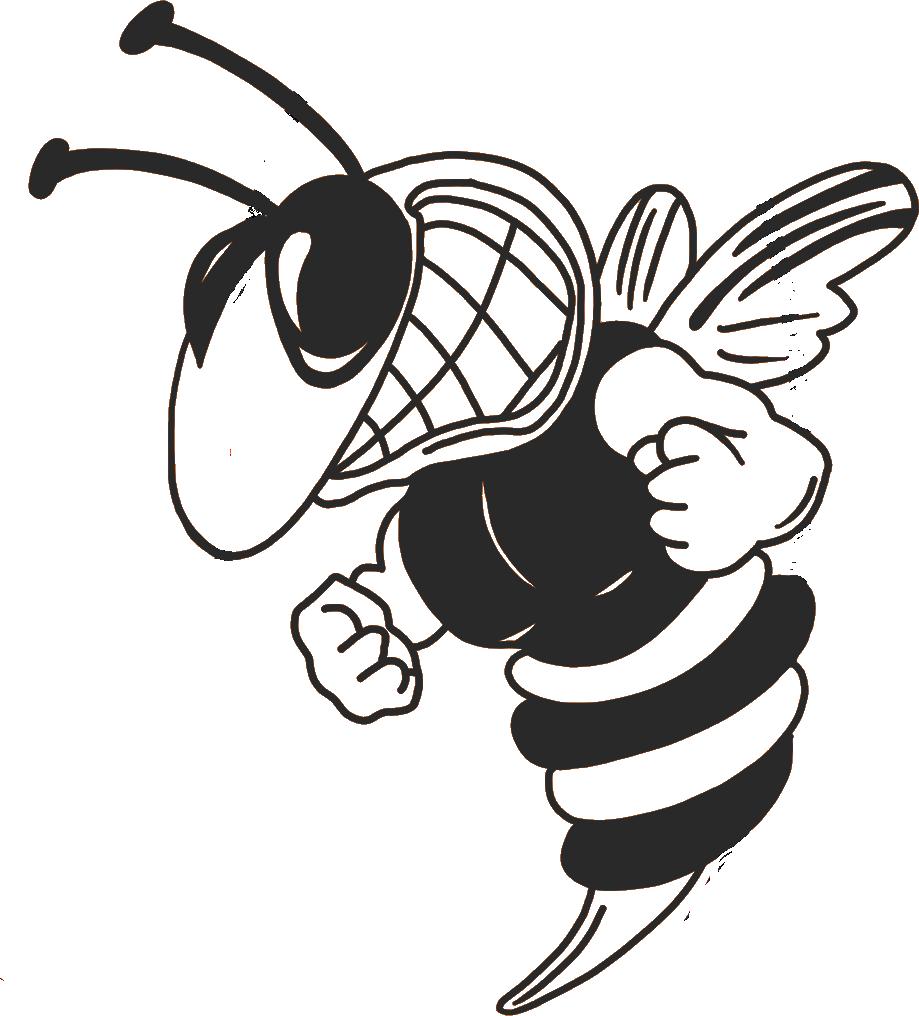
“In this process there are so many things we dictate to families about what they need to do,” said Phipps. “What we want to o er them instead is to say, ‘we don’t know exactly what you need to know, so we want you to have the opportunity to nd out what’s important [to] you.’”
Phipps, a new hire for the 2022-2023 school year, joins Greenhill with decades of experience in re ning admission events.
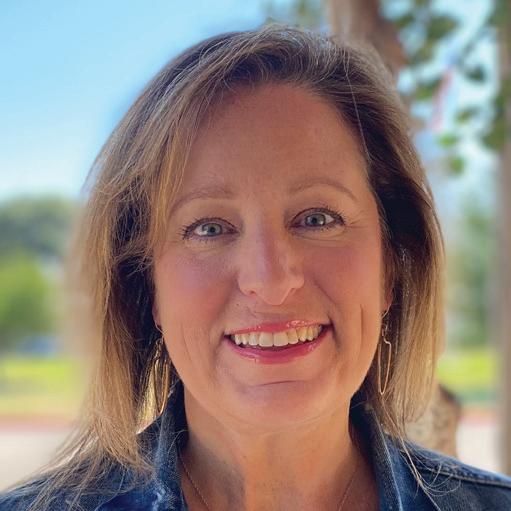
A student- and family-driven system allows families to tailor their own experiences, Phipps said.
“Research also tells us that when you’re in Middle and Upper School, and especially looking at the Upper School, the students are largely making or at least heavily in uencing the decision of where they’re going to go to school,” said Phipps. “ ese events need to be events that also appeal to students.”
Authentic Picture
roughout the fall, there have been several Admission events, with the nal one for prospective parents taking place in January.
e Middle and Upper School Admission Preview Day included three 15-minute breakout sessions, during which visitors could choose to learn about the parts of the school that most interested them.
ere have also been several daytime Parent and Guardian Visits for the Preschool and Lower School divisions since September, which have followed the newer format.
“It allows families and prospective students to seek out the speci c areas of our school that they might be interested in attending,” said Department Chair of Upper School Modern and Classical Languages Luis Gallegos, who led a class. “I think that the new format is great in just the diversity of programming to which prospective families can be exposed.”
e sessions included talks with coaches, administrators and teachers. Many of the events were styled as mini-lessons, where instructors had attendees participate in typical in-class activities.
Middle and Upper School Computer Science and Innovation teacher Joseph Meagher was one of the faculty who held a class at the preview. Meagher’s activity was a point-based competition where families were challenged to hit targets to gain points.
“But the score for hitting the target is the same as the score for hitting three, or even one foot away,” Meagher said. “So every foot you go away from the target, you got
more points than actually hitting your target.
at’s intentionally misleading, but the idea is you’re supposed to really understand what the problem is that you’re trying to solve, emulating critical thinking and how we operate in the Innovation Lab.”
Gallegos also thought the new format allowed him to better showcase what being a language student at Greenhill is like.
“I did try to combine both a general overview quickly and then give the families an idea of what a typical opening activity in class might look like,” Gallegos said.
Upper School math teacher Melissa Battis says she was able to give attendees a more authentic picture of the Math Department’s teaching style.
“I liked that it was really built to be like, ‘do an activity that mimics what you would be doing in class and that sells the school’ rather than ‘talk about the Math Department,’” said Battis. “Because it meant that we’re not sitting there talking about all of the di erent plans and how you can do di erent tracks in math, and it was more about showcasing who we are.”
It allows families and prospective students to seek out the specific areas of our school that they might be interested in attending.”
Another change is that the schedule no longer grouped together math and science disciplines in one presentation, and English, History and Modern and Classical Languages departments in another.
“ ose are two di erent disciplines, and we don’t actually spend a lot of time coteaching,” Battis said. “So, it always felt like we were kind of each doing speaking to the audience, but it felt fake. And so, this was nice to have a change.”
A er the last breakout session, visitors were invited to chat with faculty members in the Foote Quadrangle.
“ e open chat in the courtyard gave people who wanted more information the chance to come up and talk,” said Battis. “You could go and talk to math or you could go and talk to theater, and it gave them the exibility to hear about the parts of the school that they wanted to hear about.”
Also in attendance were about 150 Hill Guides, the Upper School students who give campus tours to prospective families.
“It was great to see the upcoming diversity in the new classes,” said senior Hill Guide Sophia Mohamed. “ e families
are so inquisitive, and I love answering questions about my school. In the process of giving tours, I found new ways to fall in love with Greenhill.”
Looking Forward
In e orts to continue improving admission events, Phipps says faculty have begun o ering their feedback on the scheduling.
For example, faculty had no way of knowing how many people would be attending each of their breakout sessions during the Admission Preview events. Additionally, Battis says some sessions could be placed more strategically in the future.
e Math Department held two sessions. Battis’ activity had parents collaborate to solve a problem, while AP Statistics teacher Jason Zu ranieri went through statisticsrelated information.
“But [Zu raneieri’s] ended up being on top of the whole Upper School experience, the one that [Head of Upper School Trevor] Worcester was doing,” Battis said. “And so there was really low turnout, because of course, everyone wanted to hear the Head of the Upper School talk about the Upper School experience.”
Phipps notes that changes are already being made based on input from faculty and families.
“We changed so much for some of these events,” said Phipps, “We really want real feedback, and so there’s some good little tweaks that we noticed already but that people are helping us see, too.”
To give families the opportunity to further customize their schedule, the timing of campus tours is now less tied to bigger admission events.
“We’ve added regular tours into our calendar,” said Phipps, “So you can go to these bigger events and not go on a tour, and then sign up and come back for a tour another time, which frees up time to do some other things.”
e response from prospective parents has been positive so far, Phipps said.
“I think that an admission process should really be re ective of the school,” Phipps said. “I know that I’m new here, so I know I have a lot to learn about us, but I also know that this is a dynamic place with incredible people. Hopefully in this process we can re ect a little bit more of who the school is too, so that we’re being authentic on the front just like we want people to be authentic with us.”
2 News For the Hornets This Week Dec. 14
Dec. 16 Holiday Concert Early Dismissal This Month Dec. 19-31 December Break No Classes Next Month Jan. 1-2 December Break No Classes Jan. 3 Classes Resume Jan. 16 Dr. Martin Luther King Jr. Day No Classes Jan. 23 MS Conferences No MS Classes Jan. 24 Winter Band Concert Jan. 25 Improv Performance Jan. 27 Winter Hornet Night
‘Choose Your Own Adventure’
Kindergarten “Nutcracker”
Admission Events
Emma Rikalo, Ivy Stitt
Maryanna Phipps
Photo Illustration by Ivy Stitt
SELF-GUIDED EXPERIENCE: Prospective Greenhill applicants and families were able to choose between teacher-led sessions in the October Admissions Preview.
Evergreen the
English Students Seek Competitive Outlets
Emily Hu
In the past few years, the freshman English curriculum has incorporated more opportunities for students to submit their writing and receive accolades.
Teachers wanted to provide their students with a chance at creating an impact through their writing in ways that extend beyond campus.
“For years, I’ve been proud that our entire campus community as well as peer schools know how good a student is at volleyball or lmmaking,” Upper School English Department Chair Joel Garza said. “Inspired by colleagues in arts and athletics, I wondered how we could create and announce opportunities for our campus and our peer schools to see that our students make artful, thoughtful meaning through their writing.”
Competitions
rough di erent means of outreach and discovery, the English Department has provided a number of opportunities for its students. Many Greenhill students have entered their writing in the Dallas Poet Laureate competition and the New York Times Learning Network’s contests, with notable success.

In addition to contests, Greenhill has also collaborated with local independent schools such as the Episcopal School of Dallas, Fort Worth Country Day, Hockaday School, Oakridge School and St. Mark’s School of Texas on a college-style colloquium
focused on a single text or that submit essays have them read and judged by faculty o campus to see if they would make good springboards for discussion.
Garza says that although these colloquia are not contests, they provide a wonderful chance for interested students to test their writing skills against those of students in peer schools.
“I’m grateful that the English teachers have found so many ways we can share our writing,” said sophomore Sherry Zhang. “Especially as a freshman who was still guring things out, I appreciated this guidance.”
ough faculty members have increased competitive writing opportunities for students, motivation to expand them was not sudden.
“It’s been a gradual and organic increase,” said Garza. “Submitting work to outside organizations has always been an opportunity. It has just recently become more known.”
Preparation
Many of the exercises and assignments students complete in class are materials that can be submitted to competitions.
“Most of my classes begin with notebook time, so students very early in the semester have dozens of dra s of personal re ections that can be adjusted and expanded upon for competition,” Garza said.
Freshman Chloe LaGrone, a er expanding upon an in-class writing prompt, submitted her work to the Bennington College contest.


She wrote a short story about a girl’s idealistic world that is later shattered, leaving that girl surrounded by the knowledge of a utopia she has not yet achieved.
“Writing is something I’m interested in, so participating in the contests is a way to pursue the topic without taking any extra classes or di erent electives,” LaGrone said.

In addition, the parameters of many class assignments are tailored that once students complete their writing, they don’t have to do extra work to prepare the piece for a competition.
“We’re currently working on an assignment where we have to write a review,” freshman Nora Ahearn said. “We have to submit it for class and will be graded on it anyway, so there’s little reason not to submit it to these competitions as well.”
Other competitions are entirely separate from class projects and assignments. When opportunities arise, Garza sends contest information to the freshman class, and anyone interested can receive guidance.
Ahearn was the one who took note of Garza’s email and participated in a 100-word New York Times narrative contest. She says that the prompt was broad, asking students to write a story about a meaningful occurrence in their life.
“I wrote about something really
personal,” Ahearn said. “It was a re ection of the relationship I had with my grandpa.”
Aspirations
ough there has been a surge in submissions by Upper School students, these contests are not mandatory.
“ e English Department doesn’t require students to share their writing,” said Garza. “For those that want to, me, among other faculty, nd ourselves reviewing work that students are eager to polish for submission.”
LaGrone says Garza, her English teacher, was a big help.
“A er I had a dra written, we sat down several times to revise and edit the story,” she said.
ough Garza was not Ahearn’s English teacher, he also helped her through the editing and submission process. She echoes LaGrone’s view that Garza was incredibly helpful as a mentor.
Many upperclassmen say that they would encourage younger students to participate in these opportunities.
“ e teachers have done all the work to nd competitions and are more than willing to help guide their students through revision processes,” junior McKenna Higgins said. “Everyone should take advantage of that.”
As the school year progresses, students continue to submit their work and await news on the outcome.
“Getting a chance to be creative and shape a narrative with my writing while having a lot of wiggle room is a really cool experience,” LaGrone said. “Even if I don’t win, just entering a piece and letting my imagination run wild is freeing.”
Retooled Robotics Program Poised for Growth
Khushi Chhaya
Senior Azal Amer remembers his reaction when his Upper School robotics team began work on their competitive objective for the year’s competitions: is is going to be interesting. e instructions called for building a robot that picks up cones and places them in speci c positions – a challenge that would require some innovating thinking from the team.
Amer and his teammates got to work, and a er much brainstorming and trial-anderror, they created a functional model. e idea changed hands many times, with each iteration improving on the last.
“If you model something and it’s not working, you’re going to change it, not throw it away and start over,” said Director of Design and Innovation Matt Abbondanzio. “ e nice thing is that you can sort of see
this progress of prototyping from cardboard. I think this is a phenomenal example of a success of what that can what process can do.”
A er several rounds of rudimentary prototypes, team members begin to create digital models of their work using computeraided programming.
e biggest challenge in the building process is things not coming together as you planned,” said sophomore Pranav Joshi. “We design everything on a computer and then a lot of times what happens is you think it’s perfect, right? But real life is not perfect. Sometimes pieces don’t t together as anticipated.”

e Upper School robotics team
competes in FIRST Tech Challenge competitions. Teams are ranked in three events early in the season. Based on their performance, they may advance to larger regional and state-wide tournaments.
e team is supervised by Abbondanzio, Middle and Upper School Computer Science and Innovation teacher Joseph Meagher and Upper School Math teacher Charlie Janicki. e three coaches provide guidance and oversight in a largely student-driven process, Meagher said.
e robotics team competes in tournaments as three separate groups: Viridian, Code Red and Motorheads. Although the teams compete against one another, they all work together and contribute to a strong community culture in practices, Amer said.
“We want to work toward everyone having a lot of knowledge and excitement about robotics,” junior Shreya Ram said. “It’s not just making like we do everything exactly how we see t, but rather how we are inclusive in executing the team’s vision of the robot is and the team’s vision of what we want to accomplish together.”
is year’s team consists of two seniors and four juniors. Since the program lost several seniors last year, current members are focused on mentoring and recruiting younger students.
“ ere was a bunch of seniors leaving the team a er they started to get into college [last year] and it felt like they le us on our own,” Joshi said. “It was a lot of stu to like gure out towards the end of last year, especially preparing to lead a team and making sure we are thinking about the future and what’s to come next.”
Having participated in robotics since Middle School, Amer believes fostering a fun and inclusive environment is crucial to ensuring a successful future for the program.
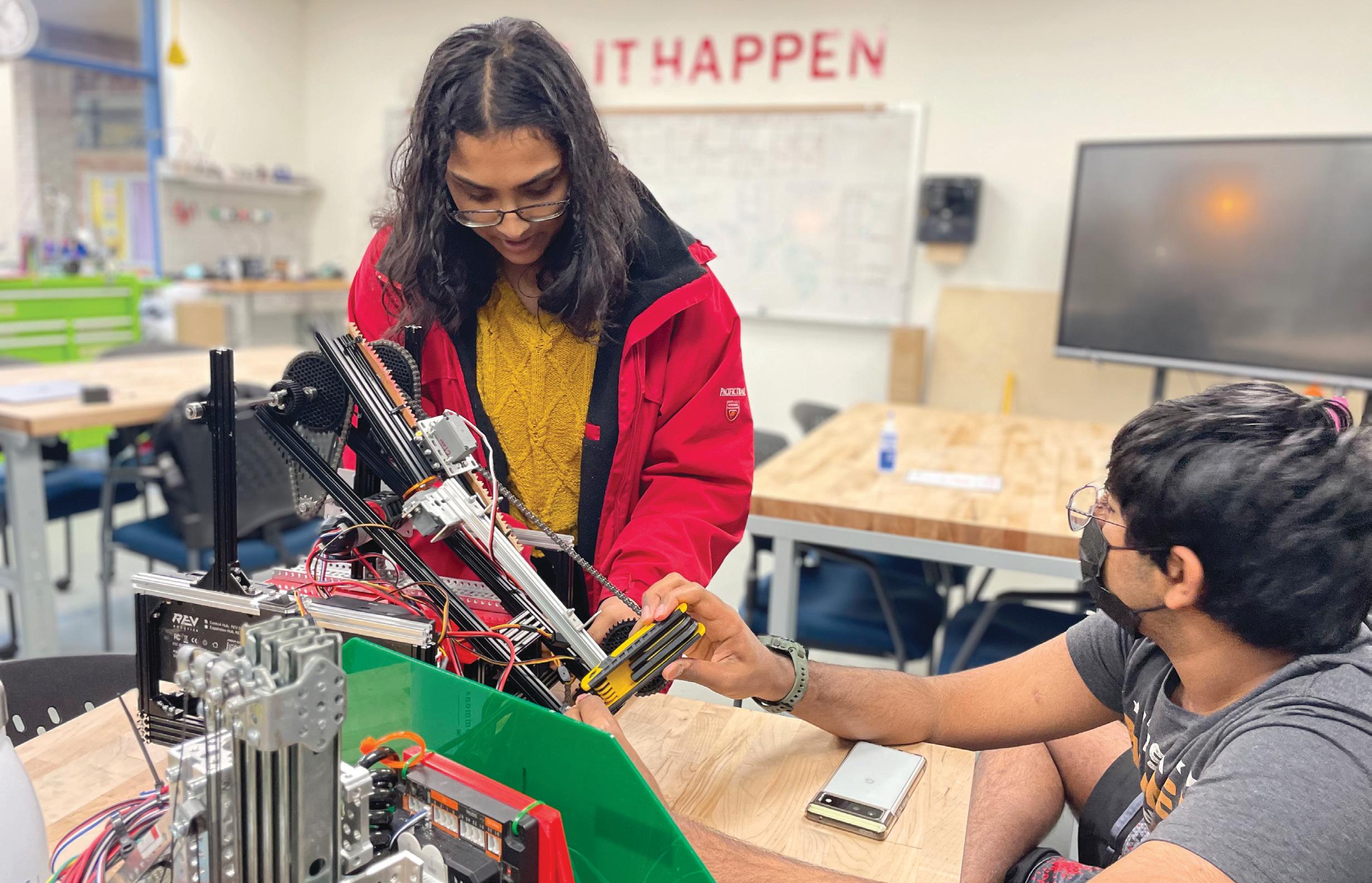
“I hope I’ve made the room a place that people want to be in,” Amer said. “And
I hope I’ve made the underclassmen more comfortable approaching me with their ideas.”
Participating in robotics o ers students the chance to develop both tangible and intangible skills, Meagher said.
On one hand, students learn how to code and model, which are useful for engineering careers. At the same time, they also re ne their leadership, teamwork, problem solving and critical thinking skills, Abbondanzio said.
e robotics coaches consider this year to be one of transition. With construction of the STEM + Innovation Center well underway, they plan to expand the program to more members. e coaches are also striving to place more emphasis on product development and other practical applications.
“What we intend to o er is the rst few weeks of class we’ll have our robotics meetings will actually be learning how to do the programming of building modelling so that everybody has a baseline of basic understanding of all [of the] aspects,” Meagher said.
“We are also looking at doing corporate robotics projects, and industrial robotics projects where we might self-create ideas.”
For many students, robotics is not just about technical design and construction; the activity can be a form of art.
“Being able to just have means of expression for expressing my own forms of creativity is something that I have really appreciated,” Amer said. “I didn’t consider myself a very artistic person. I still don’t, but it’s really nice to see something that I have made, that I wanted to put some passion into come to life.”
News
3 Wednesday, December 14,
2022
Azal Amer
Shreya Ram
Photo by Evie Kwei
ROBOTICS PRACTICE: Through the robotics program, students have the opportunity to design, build and program their own unique robots to be entered in competition.
Graphics by Evie Kwei
Evergreen the Senior Spotlight: Ian Bock
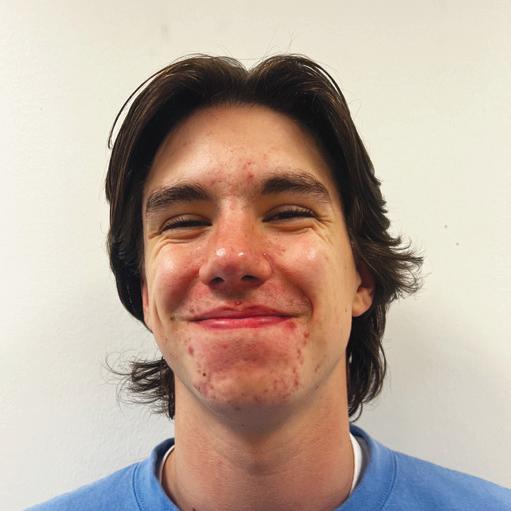
Learning to Lead in the Eagle Scout Quest
As senior Ian Bock thinks about his nal days in Upper School, he re ects on his achievements during his 14 years as a Greenhill student.
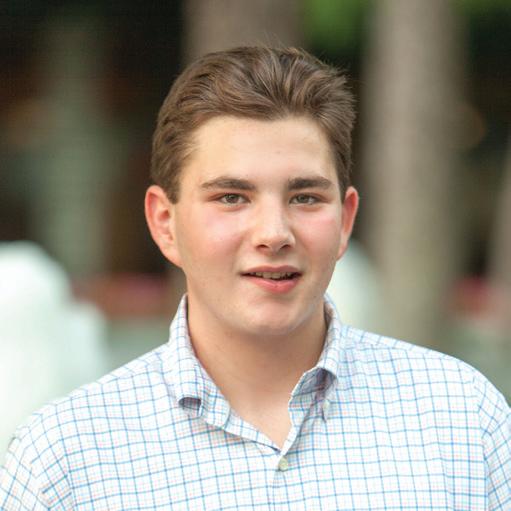
Perhaps the most important of all his accomplishments was the one achieved this June, when Bock became an Eagle Scout. It’s the highest rank in Scouts BSA (known as Boy Scouts until 2019), the agship program of Boy Scouts of America.
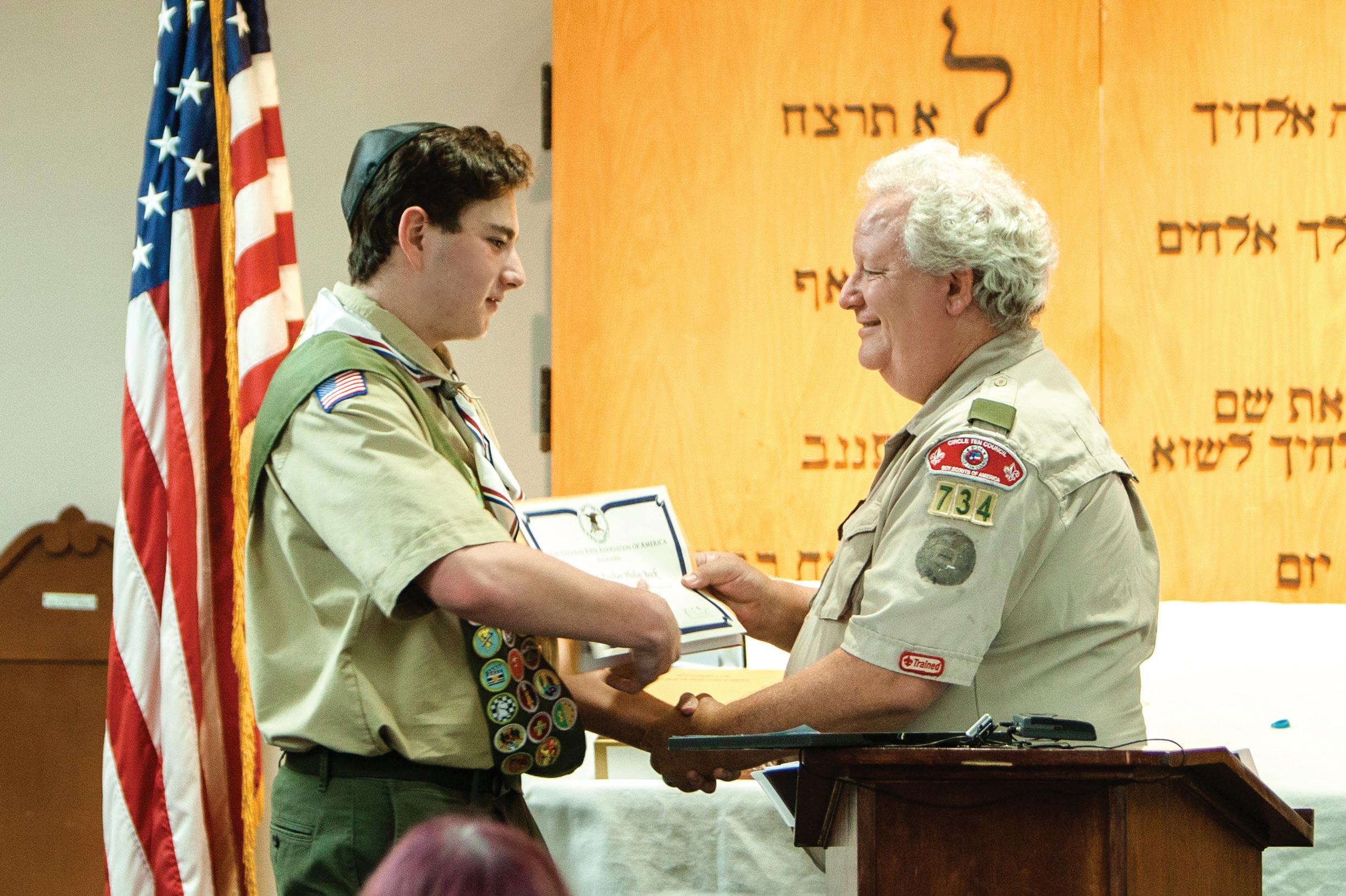
To receive this honor, Bock had to earn 21 merit badges, demonstrate exemplary leadership in his Scout troop, and develop a service project for his community. For Bock, becoming an Eagle Scout is the culmination of 12 years of work he has dedicated to being a Boy Scout.
Years of E ort
Bock recalls being in rst grade when his father encouraged him to join Cub Scouts, the elementary-school division of Scouting.
“My family was really good friends with [senior] Jack Reed’s family, and his dad, who is an Eagle Scout, was trying to get more kids from my grade to join Cub Scouts,” said Bock. “My dad told me that I was joining, and I just stuck through with it [since then].”
When he was in h grade, Bock became eligible to become a Boy Scout. He joined Troop 734, based out of Christ United Methodist Church in Farmers Branch.
Since then, Bock has become an integral part of his troop, said Reed, who was a Scout in Bock’s troop for several years.
Bock served as senior patrol leader, the highest youth-leadership position in a troop, from January 2020-2022.
Bock’s tenure as senior patrol leader lasted throughout the pandemic. He faced challenges such as social distancing during campouts and missing out on BSA summer camps, which is a major opportunity for Scouts to earn merit badges.
Reed has seen Bock’s progression throughout the years and his willingness to take on a challenge.
“I really think [Boy Scouts] helped Ian develop his leadership skills and nd his voice,” said Reed. “Before, he was a quiet kid, but I think it helped him realize that he could be a really good leader.”
Upper School English teacher Andrew Mercurio is proud of Bock’s accomplishments in the Boy Scouts.
“It’s not surprising that Ian followed through to get that achievement as an Eagle Scout,” Mercurio said. “ at’s just the kind of person he is. I think it’s going to serve him really well in adulthood.”
Other than serving in troop-level leadership, Bock also had to execute a service project in order to attain the Eagle Scout rank.
I really think [Boy Scouts] helped Ian develop his leadership skills and nd his voice. Before, he was a quiet kid, but I think it helped him realize that he could be a really good leader.”
“ e Eagle Project is a service project that you have to plan, organize, and lead,” Bock said. “You can’t do the actual project all by yourself – you have to be the team leader, but
once it’s o the ground and running smoothly, you have to take a step back and realize that you are not the one doing the project. And that was one of the biggest challenges for me during my project.”
Service Project
In order for a service project to be approved by BSA, one must seek to help a non-commercial cause, like a community, school or religious institution. Originally, Bock wanted his project to bene t his synagogue in some way, since his faith is very important to him.
“I really wanted to help my synagogue, but the projects they needed help with were mostly maintenance and Boy Scouts of America will not approve any project that’s just maintenance,” said Bock. “So, I had to look to another community that I was in.”
Bock decided on a project to bene t the city of Farmers Branch, where his troop is based.
First, he reached out to the city’s Parks and Recreation Department.
“I asked if there were any projects I could do to help the community,” said Bock. “ e representative recommended [a] project that seemed interesting to me and told me I had to do the research and plan it all out, but that Farmers Branch would fund the whole thing, which I thought was pretty great.”
Bock was given a project to help ood-proof a creek in Rawhide Park. His plan called for the creation of a riparian bu er, a piece of vegetative land next to water that enhances and protects aquatic resources from erosion and agricultural runo
“ is [project] would help the residents of Farmers Branch right on the creek because if it does ood, we don’t want their homes destroyed,” said Bock.
ough the project would only take a day to implement, Bock had to prepare extensively to make sure everything would go according to plan. He kept track of research, including steps required to complete the project, and he noted hours spent in a logbook.
This [project] would help the residents of Farmers Branch right on the creek because if it does ood, we don’t want their homes destroyed.”
Bock also made an announcement to the Upper School during a Community Time assembly, requesting students to come and join him.
On March 26, Bock executed the project. His family, fellow troop members, teachers, other Boy Scouts and Greenhill students were on hand as Bock oversaw his project by planting 50 pink muhly grass plants on one of the banks of the creek.
“One of the biggest struggles [was] that I couldn’t do it myself,” said Bock. “But when my Eagle Project adviser Steve Darrah came over and said, ‘you’re doing too much, take a step back,’ it helped me realize a bunch of people came out to support me and help me accomplish this.”
Among those who came out to support Bock on his project was sophomore Oliver Burke. As a fellow Boy Scout, Burke wanted to experience an Eagle Scout project as he hopes to get his own project done soon. By observing Bock, he got a glimpse of how he e ciently and diligently completed his project.
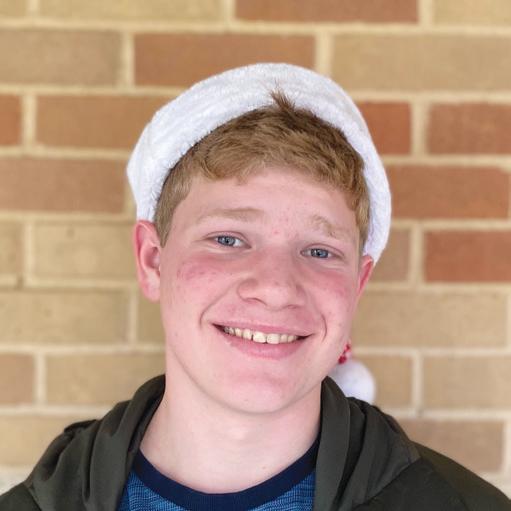
“Ian’s very good at focusing and getting things done,” Burke said. “He has a tendency to go at something and get it done in a very quick manner.”
Leadership
Bock says his years as a Boy Scout and as a student at Greenhill have taught him how to be independent and an adept leader.
“My Eagle Project taught me that I can be the leader [at the beginning] but once it’s running smoothly, I don’t need to be there anymore,” said Bock.
When Bock stepped out of his role as senior patrol leader last January, he wanted to make sure the transition went smoothly, so he gave advice to the new leader. A er he turns 18, Bock hopes to act as an adult leader in his troop. He has already signed up to participate in a campout in the upcoming year.
“He has a willingness to help the younger kids in our troop,” Reed said. “And he was able to lead people through hard times and help them progress, just as he did.”
SDLC
Six Greenhill students recently traveled to the NAIS Student Diversity Leadership Conference in San Antonio. ey were chaperoned by 10 Upper School teachers. At the conference they joined a nity groups, learned about culture, and met new people.

World Cup
Upper School Dean of Students Jack Oros organized watch parties for the Nov. 29 USA vs. Iran World Cup game. e game was shown in the Lecture Hall, Crossman Dining Hall and various classrooms across campus. Students lled the rooms in support of the USA Men’s National Team during lunch and Hornet Block.
Improv Show
e Greenhill Improv Troupe put on a show in the Marshall Family Performing Arts Center at 7 p.m. on Dec. 1. e show lasted an hour, and the 11 members of the troupe performed various improv games for the audience.
Open Mic
e Arts Board co-hosted the second open mic event of the year with the cast of the musical “Big Fish.” e show took place Dec. 13.
Choir Concert
e Upper School Greenhill Singers performed alongside the Middle School Choir on Dec. 9. Deemed the “Winter Choir Concert,” they performed songs to ring in the holiday season. e Greenhill Dance Company also performed.
Boys Basketball Success
e varsity boys basketball team won a Dec. 1-3 tournament in Tyler. e tournament was held at All Saints Episcopal School in the East Texas city.
Holiday Cheer
Highlights of the nal week of school before the December break will include the Kindergarten performance of “ e Nutcracker” at 9 a.m. on Dec. 14 in Rose Hall and the Holiday Concert at 10:15 a.m. on Dec. 16 in Rose Hall.
Riya Kommineni, Christan Park
Photo Courtesy of Ian Bock
4 News
EAGLE SCOUT: On Sept. 18, Senior Ian Bock received his Eagle Scout Award. This award is presented to Boy Scouts who earn 21 merit badges and complete a service project.
Jack Reed
Oliver Burke
Ian Bock
Middle School
“ e Nutcracker” Tradition
Holiday Cheer: Faculty and Students Seek Family Time and Travel
The holidays are just around the corner and people have di erent views on having a good time.
Students and faculty are making plans to see family or travel around the world. For some, winter break is a chance to sit back, relax and take it slow.
However, some see it as an opportunity to travel around the United States.
Seventh-grader Max Robins says his family is traveling to one of the most di cult skiing mountains in the U.S.: Corbet’s Couloir in Jackson Hole, Wyoming.
“I think I need a little break from school,” Robins said.
For others, the holidays will be a time to travel internationally and see the world. Seventh-grader Ozzie Young says his family is taking a tour of several countries in Africa.
Some Greenhill students and faculty prefer to spend time with family over the holidays.

Seventh-grade advisor Parker Ainsworth celebrates both Hanukkah and Christmas with his wife and family.
Ainsworth says he will be celebrating Christmas and the rst night of Hanukkah in Austin. A er that he and his family will travel to Illinois to celebrate the New Year with his wife’s friends and family.
e break goes by fast for many students and faculty.
“It’s not a long enough time to miss school,” Ainsworth said.
The annual production of “ e Nutcracker” is Greenhill’s longest running tradition. And like every year, the Dec. 14 performance is the result of hard work by Kindergarten students that began in October.
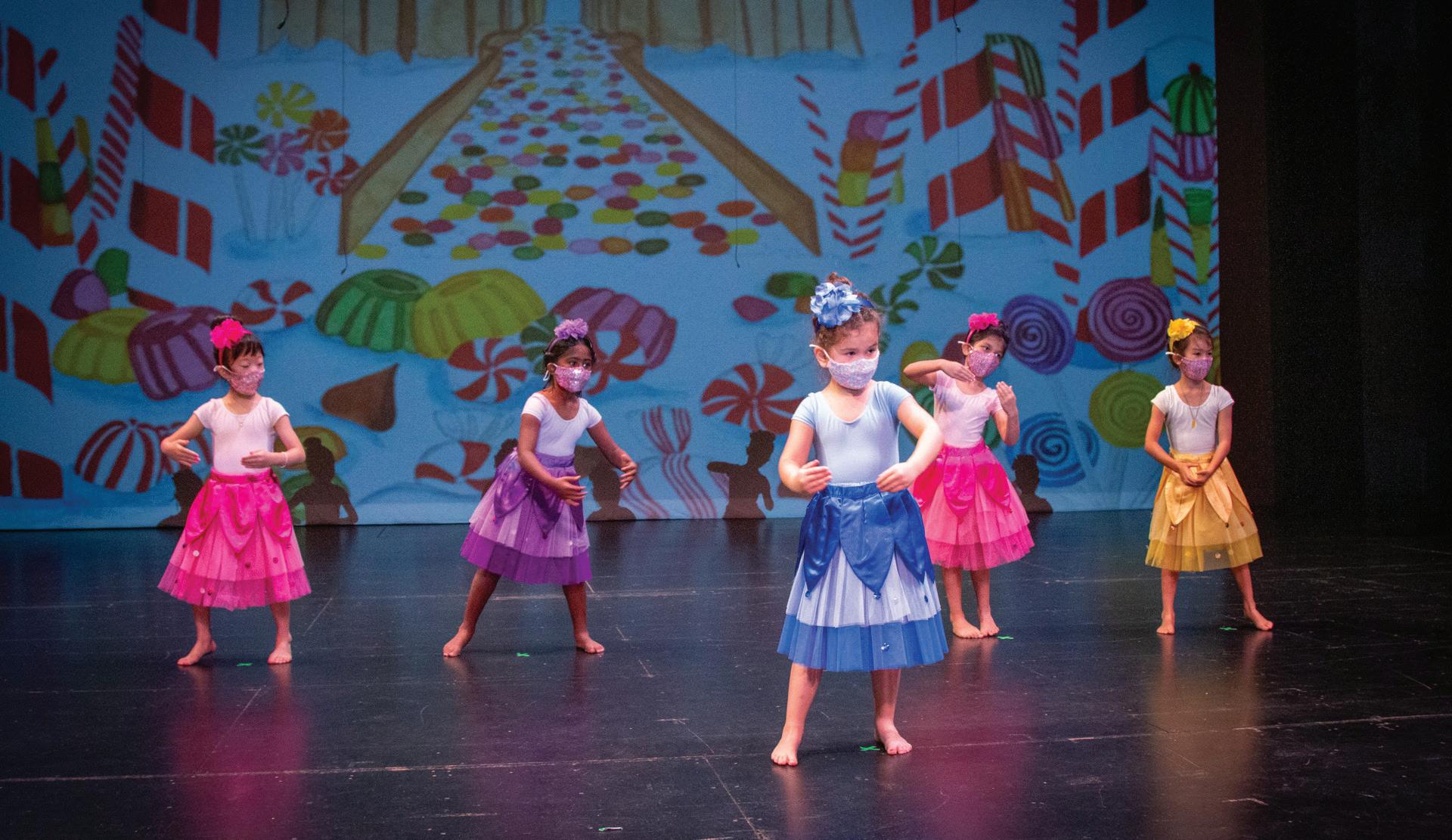
Overseeing the work was Misty Quinn, who teaches music to Prekindergarten through rst grade students.
Quinn says it’s a process to teach the Kindergarten students their roles. It’s more about students self-expressing what they are feeling with the music and the movements, she said.
In the end, Quinn said, they put all their di erent ideas together to create one dance tailored to each student.
In their work on “ e Nutcracker,” Kindergarten students discover how to use their own creativity and movement.
“Just being present on stage in front of many people really helps them with their self-con dence,” Quinn said.
It was Quinn who began the tradition of having the Head of School narrate the performance.
“It’s an opportunity to spend time with the preschool students, which I don’t get to do as o en as I’d like,” said Head of School Lee Hark.
Hark says “ e Nutcracker” is one of the school’s “core memories,” and these “are the things that make Greenhill, Greenhill.”
He added, “I like participating in our oldest traditions.”
Head of Preschool Rhema StradfordDai says “ e Nutcracker” is a cherished tradition that dates back 72 years, to the year of Greenhill’s founding.
“I get to continue that tradition and it’s something that the entire school and the community gets to enjoy,” Stradford-Dai said.
Stradford-Dai says alumni love coming back to watch the Kindergarteners perform.
While
procurement of costumes.
e Kindergarteners perform their roles twice. Prekindergarten students get to attend the dress rehearsal and see what it will be like for the next year.
Audience members at the actual performance include parents, siblings and grandparents of the performers and alumni.
Middle School Field Trips Are Back
Most Middle School eld trips have resumed this year a er cancellations because of COVID-19.
D.C., last April marked a big step forward in student life. is year’s eighth-graders repeated the trip in November. “ e best part of the eld trip [to Washington] was that I got to get closer with friends through workshop groups, and overall, the grade got closer as a whole,” said eighth-grader Lylah Pouratian. h-grade students resumed another Middle School experience disrupted by the pandemic by visiting nearby Vitruvian Park. e trip was fun because we got to do activities with our friends, and we had lots of free time,” h-grader Hudson Brandenberger.
Sixth-grade advisor Sharon Charlebois, who also teaches science, says the eld trips help students learn.
Seventh-grade advisor Jack Fisher, who also teaches English, says the eld trip that students just took to Group Dynamix positively impacted student learning.
At Group Dynamix seventh-graders learned how to work together in their advisory groups. An upcoming seventhgrade trip to the Dallas Holocaust Museum will t into the seventh-grade English curriculum.
Eighth-grade team leader Susan Bauman says she witnessed the impact of eld trips last April when her students visited Washington, D.C., for the rst time since COVID-19 restrictions began.
“It was a di erent way of learning,” Bauman said, “because you are in a di erent place, you see lots of new things that amaze you, and you have new experiences that are outside of the classroom.”
Eighth-Graders Visit Nation’s Capital
Capitol building followed by the Library of Congress. A erward, students walked to the U.S. Botanic Garden.
In an annual Middle School tradition, eighth-grade students visited Washington, D.C., in November.
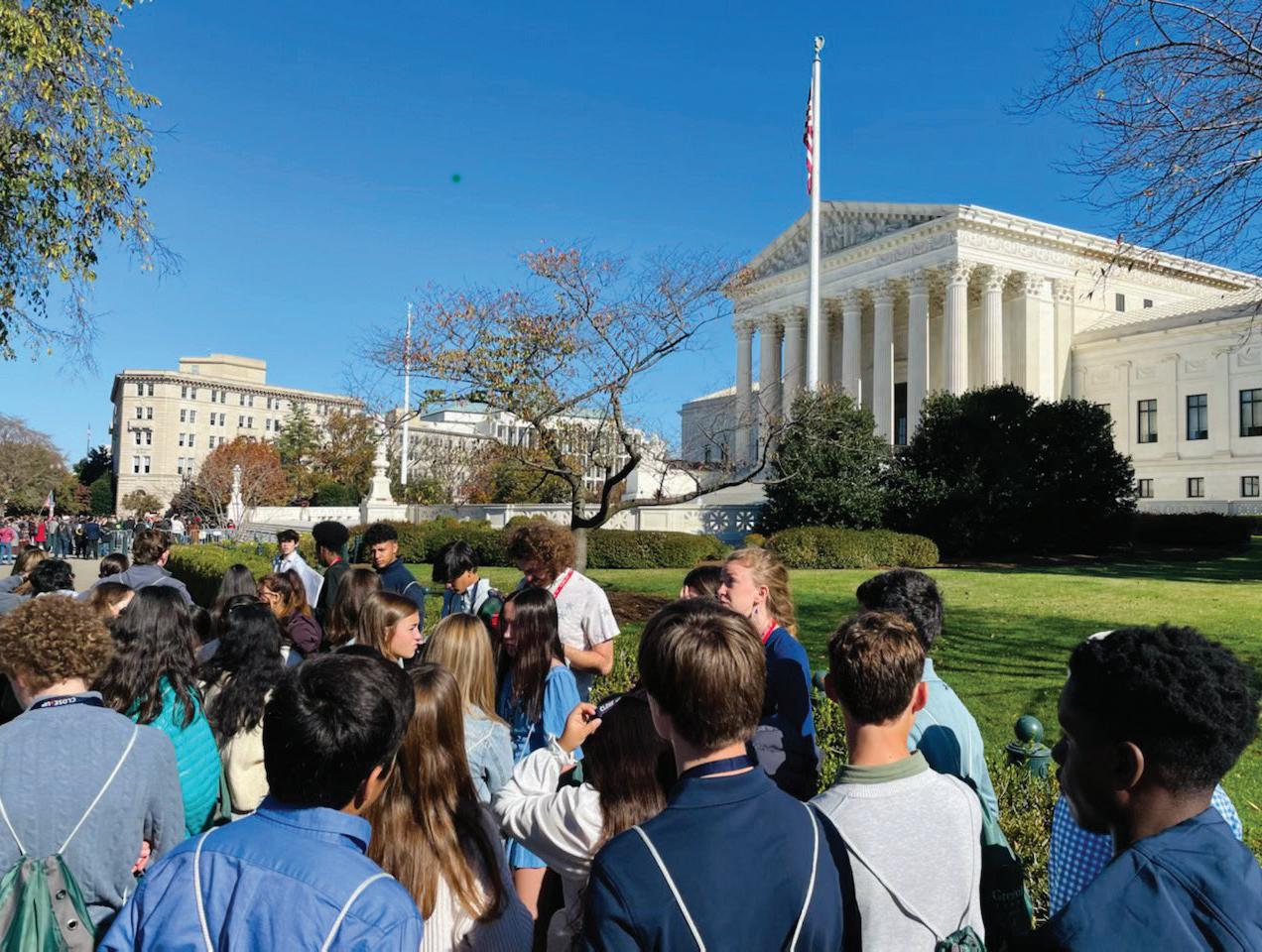
During the Nov. 7-10 trip, students visited important government buildings, memorials and museums.
On day one, the 98 students and chaperones visited the White House and Black Lives Matter Plaza. Students also spoke with a member of the White House Peace Vigil, a small protest group, outside the White House gates.
at evening, students attended advisory dinners at e Hard Rock Café and the Yard House.
“I have to say to say that the part of the trip that I always look forward to is the advisory dinner,” said eighth-grade history teacher Kara Smith.
On Nov. 8, students visited the omas Je erson Memorial, followed by the Martin Luther King Jr. Memorial and the Franklin Delano Roosevelt Memorial. Later that day, students crossed into Virginia to visit the 9/11 Memorial at the Pentagon.
Students began Nov. 9 by visiting the
Next, the students went to the National Archives to see the original nished dra of the Declaration of Independence, along with the Constitution and Bill of Rights. A er that, students visited the Smithsonian Museum of African American History and Culture. To nish the day, students toured the Lincoln Memorial, Vietnam War Memorial, Korean War Memorial and World War II Memorial.
I have to say to say that the part of the trip that I always look forward to is the advisory dinner.”
On the nal day, students visited Arlington National Cemetery and then spent time at one of three museums: the Natural History Museum, American History Museum or the National Gallery.
“I went to the Natural History Museum, and I thought that museum was pretty fun,” said eighth-grader Vikram Sampath.
Collin Chon, Lucas Zhu
Leo Schnabel
5
WASHINGTON D.C.: Eighth-graders gather outside the Supreme Court during their trip to Washington D.C., where they visited important landmarks and museums.
Photo courtesy of Greenhill School
Quinn is primarily responsible for overseeing everything, Kindergarten parents also have an important role in planning and
Lucia Tellini, Natalie Davido , Harley Silberman
Marleigh Massoud
Photo courtesy of Greenhill Communications “THE NUTCRACKER:” Every year, Kindergarten students perform “The Nutcracker” for family members and alumni. This year’s performance is on Dec. 14 in Rose Hall.
Graphic by Christan Park
Mistletoe Money
Community Service Group Gives Back During the Holidays
Ava Iwasko
Every year during the holiday season, junior Quinn Graves has one thing on his mind: selling mistletoe. Sometimes he even stands in the back of a truck singing o -key Christmas carols with some friends in Highland Park Village, hoping that people will walk by and be inspired to buy an arrangement.
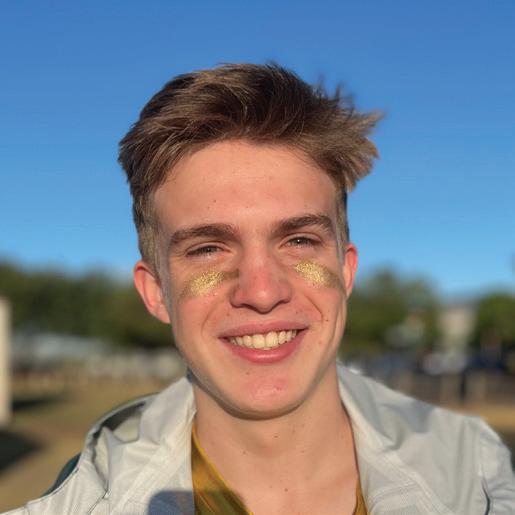
Graves can raise several thousand dollars in just a couple of hours. But instead of using the money to buy gi s for family or himself, Graves donates it all to the North Texas Food Bank through the service organization he runs with three friends, Jingle Bell Mistletoe.
Jingle Bell Mistletoe started in 2012 when one of Graves’ friends, Stella Wrubel, decided she wanted to raise money for the victims of Hurricane Sandy.
Wrubel’s family owns a ranch where mistletoe grows wild in trees, so she decided she could sell the popular holiday plant with ribbons and bells to donate to the American Red Cross. at year, Wrubel raised more than $2,000.
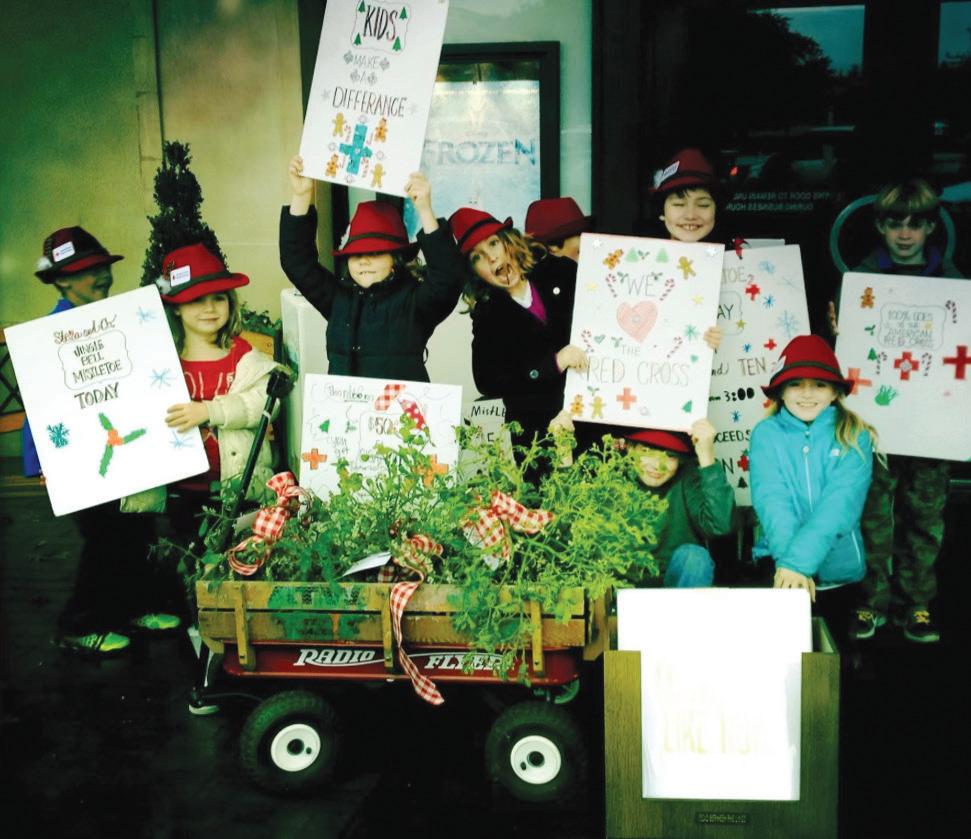

“I had a little idea that snowballed, and the community service thing became apparent a er,” said Wrubel, now a junior at e Hockaday School. “It just felt kind of natural to me. I saw people struggling and knew I was in a position to help.”
Making an Impact
Graves became a co-leader of Jingle Bell Mistletoe in second grade a er he met Wrubel and the two other leaders at e Lamplighter School.
Since then, Graves and the other Mistlecrew members, as they call themselves, have donated $388,411 to the North Texas Food Bank—enough to provide more than 1 million meals to people in need.
is year, the Mistlecrew’s goal is to raise $45,000 and provide 135,000 meals for the North Texas Food Bank, according to their website.
ey will sell mistletoe at three locations: on Knox Street in Dallas on Dec. 16 from 4 p.m.-8 p.m. and Dec. 17-19 from 1 p.m.-5 p.m.; in the Highland Park Village on Dec. 18 from 1 p.m.-5 p.m.; and on Dartmouth Avenue on Dec. 21 from 11 a.m.-3 p.m.
Wrubel says that working with Graves is always fun because their personalities balance each other out.
“It’s hard to nd people who will indulge my crazed ideas with as much zeal, if not more, as me,” said Wrubel. “Quinn does that. I joked one year that we should try and break some world record and he had crunched the numbers on it within the hour.”
In fact, Jingle Bell Mistletoe ended up breaking that very world record later that year. On top of their 2018 Guinness World Record win for “most couples kissing under mistletoe for a charity event,” Jingle Bell Mistletoe won a Golden Fork Award in 2016 and an Association of Fundraising Professionals Outstanding Youth in Philanthropy Award in 2018.
e friendship Graves has with the other Mistlecrew members has made the experience more memorable, he said.
“We’re just really tight-knit and so it’s a ton of fun to work with them and to get to spend that time with them,” said Graves. “It’s just extremely fun, which is why people continue to want to come back and volunteer. All of those di erent things we do together don’t really feel like work. It feels like fun. But then it also is helping people who can’t
[necessarily] help themselves.”
Graves is grateful to see the direct impact that Jingle Bell Mistletoe has made on others’ lives.
“Stella and I, for instance, we’ve gone to one of the schools that the food bank serves and handed out food and we see how much that means,” Graves said. “So it really impacts on a fundamental human level of wanting to help people. It’s also just a really fun thing for us to do as a group because we’ve been friends [for a long time].”
For Wrubel, seeing the faces behind food insecurity has a ected her perception of community service.
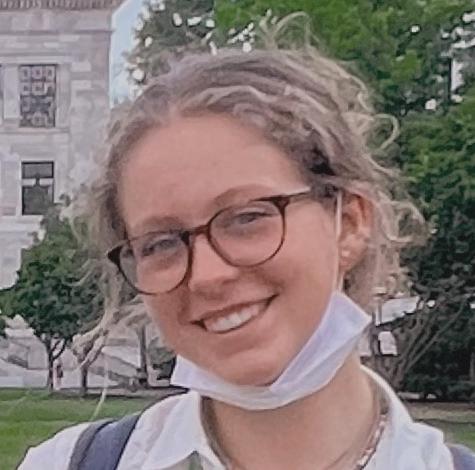
“It’s so much easier to commit time and planning to something when you know there’s an impact that can come from it,” Wrubel said. “Seeing each of their faces makes the issue of youth food insecurity that much more real. A er visits like those, it hardly seems like a ‘time commitment’ and more like a duty to our community.”
Increasing Service
In addition to his work with Jingle Bell Mistletoe, Graves also serves as an Upper School Community Service Board representative. Graves has noticed a shi in the board’s goals since Director of Service Learning and Community Engagement Jessica Chu took over leadership this year.
“[Chu] wants to really put the emphasis less on [winning] competition stu ,” Graves said. “She wants it to be service for the sake of service.”
Chu appreciates Graves’ enthusiasm and love for community service.
“What I have learned about Quinn is that he does so much for the Dallas community,” said Chu. “ at’s why I’m glad that he’s part of the Community Service Board because he has so many ideas and he wants to spread that passion around service to everyone.”
Graves and the other Board Representatives plan to visit the Lower and Middle School to get younger students interested in community service before it becomes an Upper School graduation requirement.
“High school people do [community service] because they need the hours, and then if they go above and beyond then that’s awesome,” Graves said. “But the more that we can get those younger kids involved in service, the more they’re going to realize how fun it is and what it means to them before it’s being pushed onto them.”
Graves says that the reason he began participating in community service is di erent from the reason he has continued with it.
“Originally why I did it was the idea that there are people out there just like me who don’t have nearly as fortunate a life as me,” said Graves. “But then over time, if you do it consistently enough, you get to realize that it’s something way bigger than yourself. Because to someone else, that
small gesture may be the di erence between staying hungry, losing a job, whatever it may be.”
Wrubel says running Jingle Bell Mistletoe every winter has transformed the way she views the holidays and gi giving.
“Instead of stressing about what money I’m going to [spend] on whose gi s or what I want to ask for from my parents, I’m focusing on our e orts for the community as a whole,” said Wrubel.
Graves hopes people are generous year-round, but nevertheless recognizes the great impact holiday season spirit can have on service.
“I wish that feeling would extend around the year but that’s not something that the holidays take away from, that’s just something that would happen with or without them,” Graves said. “So I think saying if people didn’t have that giving spirit during a holiday, it doesn’t mean it would be spread throughout the year, it would just mean less giving.”
Looking Ahead
Graves says he hopes the Community Service Board can continue to increase year-round service from the Greenhill community. e Board is currently setting up a page on MyGreenhill to help students connect with service opportunities.
“I think a lot of that is really focused on getting people to feel what it feels like to give back and not just doing it because they have to,” said Graves. “We need to make it so that it’s more of a choice so that there’s more variety.”
Chu says she hopes to empower the members of the Community Service Board to spread service throughout the school and become more visible to the greater community.
“It’s not just only either me or only the Board or only a few students. It can be something that is just ingrained in our culture,” said Chu. “If I can get people to stop thinking about [service] as a requirement and just [be] excited about service, I’m going to feel like I did my job correctly.”
Wrubel says that it is important for someone to follow their impulses when participating in community service.
Recently, she thought about how there are many people in the Dallas area who are unable to stay warm during the winter. So, she ordered 30 hand warmers online and hands them out whenever she sees someone in need.
“I try to remind myself to contemplate what small impact I could have,” Wrubel said. “It doesn’t have to be a big thing, but impulses can lead to great places. An impulse landed hand warmers in my passenger seat, and an impulse started [Jingle Bell Mistletoe] 11 years ago. You never know.”
6
Features
LONGSTANDING TRADITION: This year marks a decade of Jingle Bell Mistletoe work for junior Quinn Graves.
SEASON OF GIVING: Junior Quinn Graves, far right, Stella Wrubel, second from left, and two friends run Jingle Bell Mistletoe, which raises money for the North Texas Food Bank every winter by selling mistletoe in Dallas.
Quinn Graves
Stella Wrubel
Photo courtesy of Quinn Graves
Photo courtesy of Quinn Graves
Evergreen the
Multicultural Poetry Inspires Conversations
When junior Sarah Fradkin signed up to take Multicultural Poetry, she didn’t know what to expect.
“I’m not the biggest fan of poetry,” Fradkin said. “But it’s interesting how we analyze the poems. I like how it’s a very conversational-based class. We move from poets quickly, so you’re not focusing on one poet for too long.”
In particular, Fradkin has enjoyed the class’s Zoom calls with the poets that students read and discuss.
“I think [it’s] pretty cool to be able to talk to the person whose work you’re reading, and hear how they came to write it, what inspired them,” she said.
As one of the English electives o ered to juniors and seniors, Multicultural Poetry focuses on a wide range of authors and poems, said Upper School English Department Chair Joel Garza.
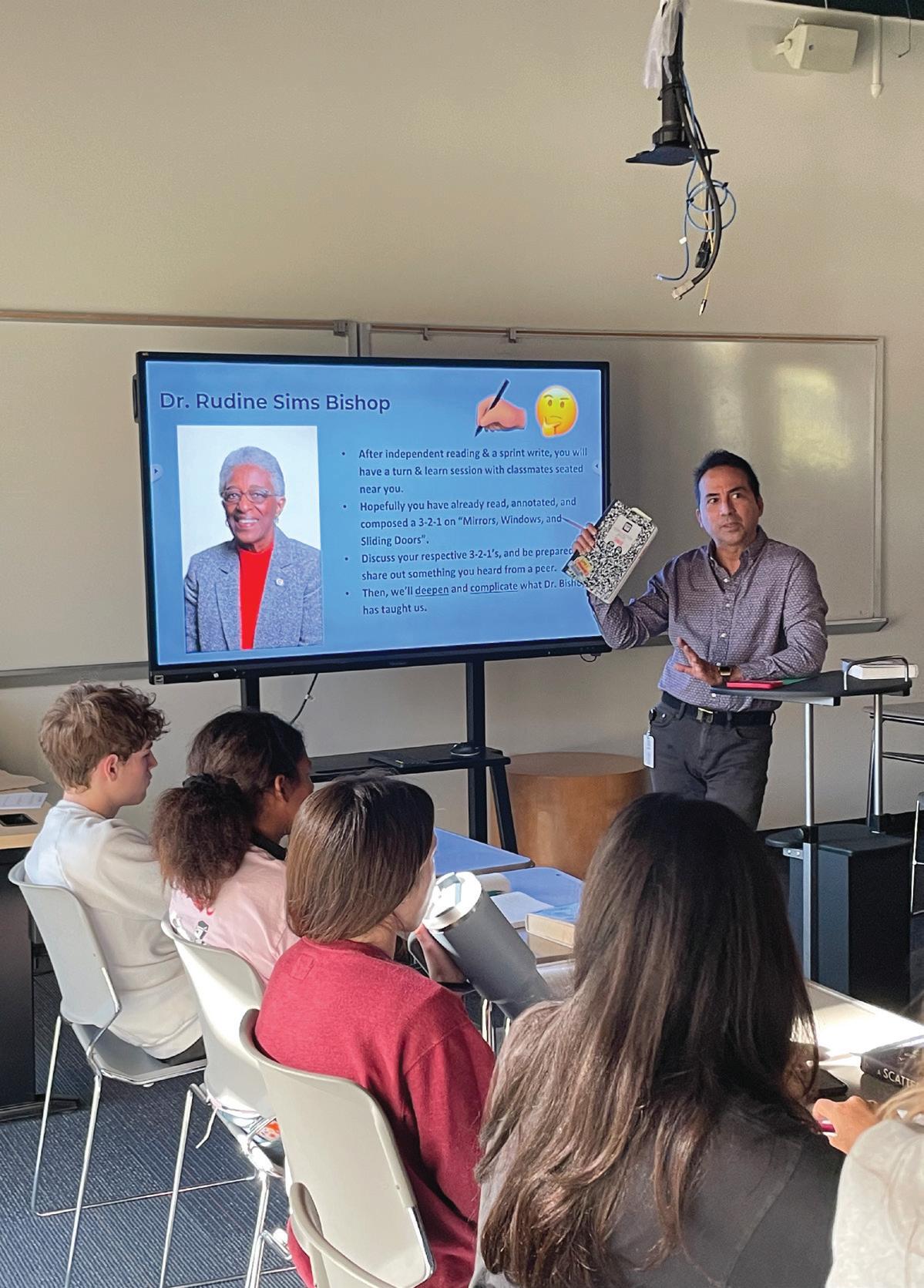
“At some point when this course was designed, the department recognized we needed to have a kind of lane for students who wanted to understand their own heritage, as well as for students who were interested in learning about poets that did not look like them or live like them,” Garza said.
e Zoom calls, however, only started a couple of years ago when Garza emailed poet Mark Doty to ask if he would mind chatting with Upper School English students.
“To my surprise, within minutes he responded ‘yes,’” Garza said. “So during that rst Zoom call, I recognized, if you ask a poet for a short amount of time, you let them
know, ‘we would love to hear your voice. And we would love to ask you three questions.’ at is the best way to get a poet to say yes – to let them know that the students are interested and that the task will not be di cult.”
Di erent Voices
Even before Multicultural Poetry began connecting with poets via Zoom, Garza wanted his students to listen to di erent people read poetry.
“ ere are a lot of poets that do experimental things with stanza breaks, or typography, or alignment, or metallics, or capitalization,” Garza said. “And until that poem lands on the ear, I’m not certain that a rst time read of the poem is enough.”
Garza says he used to solicit di erent faculty members around campus to read poetry to his students “so that every poem had a di erent voice.”
“ ere’s really something that lets the material take root for students, when they can see the person that created the work, when they can interact even in a small way with the person that created the work,” Garza said.
Before Zooming with a poet, the students come up with three questions to ask. Every meeting is about 15 minutes long and ends with the featured poet giving students a writing challenge that they work on for the remainder of class.
“[ e calls have] helped students recognize the creative process for a poet is sometimes not as deliberate as I the instructor might be forcing them to think,” Garza said.
Personal Meaning
For junior Natalie Stachowiak, being able to meet with the authors has helped her interpret poetry in di erent ways.
“When you’re speaking with the author, you get to talk about your own experiences and sort of contrast them to what the author was thinking when they wrote the poem, which helps our interpretation as readers to also understand more about the world around us,” she said.
In particular, being able to see and talk to the authors has helped Stachowiak broaden her perspective of the poems the class reads.
“It kind of puts you in that headspace to what the author was thinking and not just what the reader is thinking,” Stachowiak said. “It gives a di erent perspective or a di erent spin on what was happening, which is something that you wouldn’t get with an author that you can’t communicate with.”
Fradkin agrees. She says that speaking with the authors gives her the chance to review and challenge any assumptions she made about the poem when initially reading through the work.
“You read through your own lens,” Fradkin said. “But then, when you talk to the actual poet, you see it through their lens and how they meant to write it. And o en they just say that you’re supposed to interpret it however you interpret it, but it’s really interesting to see how the person who actually wrote it interpreted it and the reason they wrote it.”
For Garza, the goal of these Zoom conversations is to give students more agency
in interpreting a poet’s work.
“ e Zoom calls have just reinforced for the students one challenge of reading, namely that the reader has a lot of agency, the reader has a lot of responsibility, in making the meaning of the poem,” Garza said. “ ose Zoom calls have been really disarming, having students recognize, ‘Oh, I have a role here. It’s not nding ‘the answer.’ It’s in nding what this poem might mean, in my own personal here and now.’”
Solving Equations, Serving Students
From Math Club to Math Lab, three student leaders are spending signi cant amounts of time helping members of the Greenhill community hone their math skills.
Seniors Nikitha oduguli and Kevin Han and junior Aditya Pulipaka have created interactive activities to involve students of all di erent levels of math ability.
Math Club and Math Lab are two di erent groups that are both led by oduguli, Han and Pulipaka. Math Club meets during Club Rotation 3, like every other club, although it also participates in competitions such as Math
Madness, American Scholastic Mathematics Association, Harvard-MIT Mathematics Competition and American Mathematics Competition.
e group sent six of the club’s 30 or so members to the Harvard-MIT Mathematics Competition in Boston on Nov. 11. e students were oduguli, Han, Pulipaka, junior Dibyadeep Saha and sophomores Justin Wu and Aaron Kuang.
“I applied for Greenhill to bring one team and we kind of did early decision,” said Upper School math teacher Jessica Chu, who is the Math Club faculty sponsor. “For lack of better words, they have like an early decision version and a regular decision version, just
like colleges, because it’s very competitive to get in.”
e Harvard-MIT competition is a college student-led program that occurs once in the fall and once in the spring. Getting accepted to the program is a di cult process that requires a certain level of dedication from the team, said Chu.
A er the online application opens, schools are able to select how many teams of six students each they want to bring. To choose which students will go to selective competitions such as HMMT, Math Club hosts tryouts to determine the top scorers in the group.
is year marked the rst time a Greenhill team has participated in the Harvard-MIT competition.
“I felt like it was an opportunity to kind of go and see how other schools were doing,” Pulipaka said. “Of course, I actually saw a few familiar names from Texas, so it was interesting seeing how people end up congregating in these places.”
oduguli says Math Club operates in a very similar way to other clubs with faculty sponsors. Students typically practice answering questions for competitions and play math games in their spare time.
“I think we place a huge emphasis on explaining how problems are done so that even if you don’t feel like you know a whole lot about math, competitions or otherwise, there’s plenty of background and the sort of vibe of Math Club is such that if you ask the question, no one will judge you,” said Han. “And in that regard, it’s open to everyone.”
Unlike most other Greenhill clubs, however, Math Club has created a rewards system where students can earn “math-tips”
or “m-tips” if they attend and participate in a certain number of meetings. “Participation” can be de ned as doing the competitions that Math Club has available, as well as answering questions correctly during a meeting.
A er receiving a certain number of m-tips, a student’s math grade can be bumped up.
“ e m-tip system is a little bit of an incentive to put your time toward Math Club and to attract people who might have maybe skimmed over an email,” said oduguli.
Math Lab was created by oduguli, Upper School math teacher Melissa Battis and former Upper School math teacher Ahmed Najm. e goal of the initiative is to assist students with their math homework through peer-to-peer connections. It meets every Green Day a er lunch.
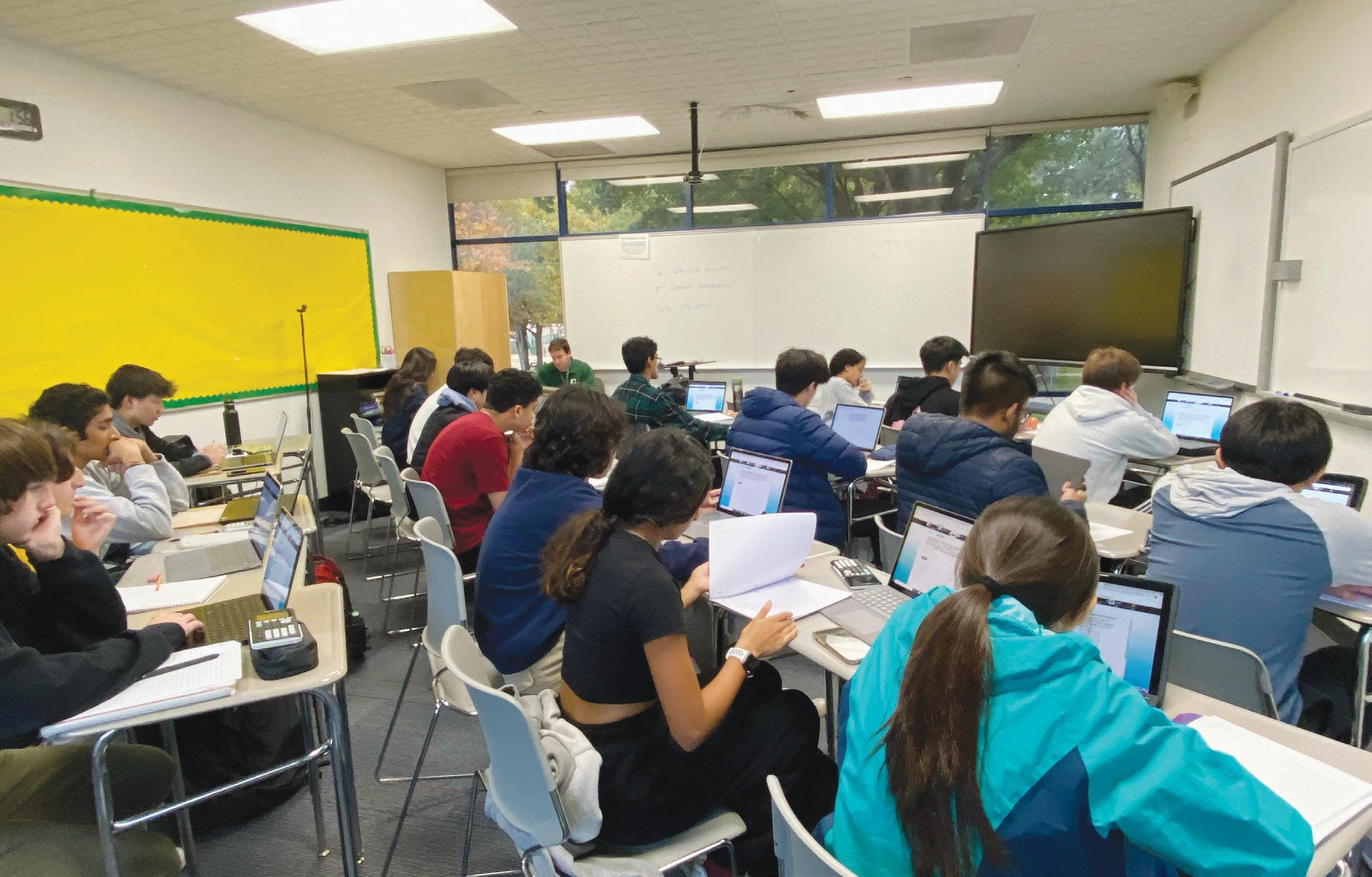
Student tutors are properly assessed on their teaching ability through a tryout that mimics a mock tutoring session.
As a team of student leaders, oduguli, Han and Pulipaka say they have found that helping students understand di erent math problems leads to a deeper connection with math and makes math fun.
e m-tip system is a little bit of an incentive to put your time toward Math Club and to attract people who might have maybe skimmed over an email.”
“We want to encourage interest in math as a whole as part of math club, instead of just attracting people for the purpose of m-tips,” said Pulipaka. “We want to foster an actual interest in the subject.”
Features
7 Wednesday, December 14, 2022
Emma Nguyen Helina Tedros
LIVE POETS: Students connect with the poets they study in class via Zoom calls.
Photo by Jacquelyn Dishman
Photo by Christan Park
MATH PASSION: Math Club members solve complex problems to prepare for national competitions. The Math Lab assists students with homework assignments.
the
Emma DeVine: Science in Action
Evie Kwei
From observing live zebra sh and fruit ies to separating strands of DNA and RNA using electrophoresis, Middle School science teacher Emma DeVine continues to push the envelope of what is possible in a middle school-level science course.
Live organisms and high-tech lab equipment are rarely a part of a typical middle school curriculum. However, for DeVine, this introduction to professional research drives her push for a more scienti cally literate world, which starts with students.
For her incorporation of real-world science techniques in her classroom, DeVine was awarded the 2022 Outstanding Rookie Teacher of the Year award by the Science Teachers Association of Texas. is award is presented annually to a teacher who has displayed excellence and creativity with less than three years of teaching experience. DeVine was the only teacher from an independent school recognized with an award.
DeVine received the award at STAT’s annual Conference for the Advancement of Science Teaching, which she attended with Upper School science teacher Hennah Abubaker and Middle School science teacher Sharon Charlebois ’97.

“It was really nice seeing her be recognized for skills that maybe she doesn’t recognize herself,” Abubaker said. “We were super excited to support her.”
Although many teachers could not be at the event due to con icts, both Abubaker and Charlebois tried their best to represent Greenhill and cheer DeVine on.
“We could not scream loud enough because it’s so cool to watch a colleague win something really special,” Charlebois said. “It feels amazing to see a colleague be acknowledged and to know that we have such a quality educator at this school.”
Lab Experience
DeVine credits her award to her experience at the eight-week-long Science Teacher Access to Resources at Southwestern Summer Research Program.
At the STARS program, hosted by the University of Texas Southwestern Medical, DeVine focused on studying genes in drosophilae, more commonly known as fruit ies, and their correlation to metabolism and energy consumption. She also found ways to adapt this process for a middle school classroom.
She wanted to bring a real lab experience to middle schoolers, which was di cult to do at her previous job. Coming to Greenhill has been a freeing experience a er teaching at Frisco ISD for two years, DeVine said.
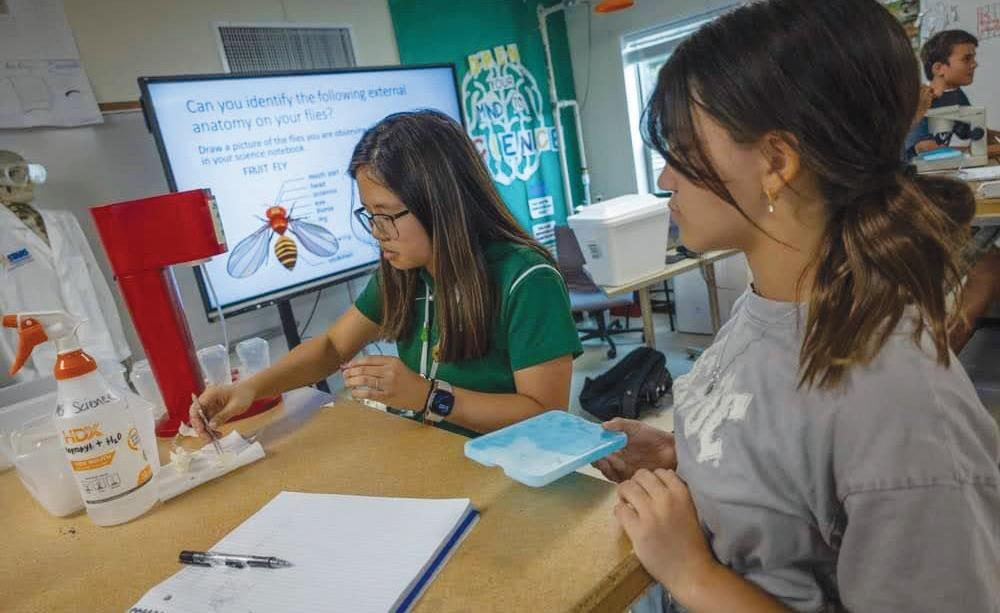
“When you see things in your textbook, you don’t really get to interact with them, but now, these students get to work with organisms that real scientists use,” DeVine said. “I just think it’s important that they get exposure.”
According to multiple colleagues, DeVine has a gi for collaboration and teaching. Charlebois says DeVine brings energy and a fresh perspective to the Middle School science team.
“Since she’s joined, I think we have incorporated more interactive, real-life science experiences,” Charlebois said. “Her creativity and style have been able to soar with the freedom she’s been given.”
Middle School science teacher Gretchen Pollom says DeVine is a reason she loves going to work every day.
“Anyone will be lucky to work with her, to have her as a teacher, to have her as an advisor, or to have her in uence,” Pollom said.
Teaching Journey
Growing up, DeVine never thought she would be a teacher. She had an interest in the sciences, but she didn’t fully understand all the roles that come with being a teacher.
“I was a very quiet and studious student when I was in school,” DeVine said. “I honestly didn’t really know what I wanted to be when I grew up.”
DeVine didn’t get into teaching until she transferred from Collin College to University of Texas at Dallas, where she met a representative for UTD’s specialty course for aspiring STEM teachers, UTeach Dallas.
“[ e representative] told me that I was welcome to exit the program at any time, but as you can tell, I think I liked it,” DeVine said.
As a teacher, DeVine hopes to empower her students and push them to take risks.
“I want them to be con dent enough to take risks and pursue their interests,” DeVine said. “I want them to be able to question the world and try to advance our understanding and discovery of it.”
Her choice to teach science in particular stems from her belief that everyone should be more scienti cally literate. DeVine says that science touches all aspects of life, from mathematics to the humanities.
“Obviously, not everyone has to be a scientist, but everyone has to have a scienti c view so they can critically think and analyze,” DeVine said. “I want my kids to be able to really think about what’s going on around them.”
Despite initially wanting to teach high school, DeVine has found her niche in teaching middle schoolers. Since middle school is generally a time of discovering one’s passions and interests, DeVine hopes to strike a nerve within her students in the eld of science.
“For me, I can still remember back in sixth grade, my science teacher brought in a pig’s heart and lungs for us to experiment on, even though I can’t recall anything else from that year,” DeVine said. “I like to think that in some way, that started a cascade of events that has brought me to where I am now.”
Unfortunately, shortly a er DeVine began her teaching career, the pandemic hit. Even through a tumultuous time of virtual learning, DeVine was able to nd the silver lining.
“It just taught me how exible I could be,” DeVine said. “If anything, this was just another one of those challenges that we had to rise to and gure out the best we could.”
roughout her teaching journey, DeVine’s end goal has always been to push the boundaries and meet any challenge presented to her. is goal has been a core tenet of Greenhill’s teaching philosophy for many years, according to Head of Middle School Susan Palmer.
Palmer says that this was one of the many reasons Greenhill decided to hire DeVine.
“She’s so enthusiastic about learning and facing challenges,” Palmer said. “She really does epitomize the lifelong learner at Greenhill.”
Since DeVine joined Greenhill during the pandemic, her interviews were all conducted through Zoom. Palmer says DeVine’s personality and energy could still be felt.
“Her excitement for working with kids and working in a collaborative environment shined through the screen,” Palmer said. “Her personality just felt so real and so human, even though we weren’t in person.”
DeVine was hired as a replacement for Abubaker as she moved to teach in the Upper School. Abubaker says she spent a lot of time meeting with DeVine virtually to
discuss life at Greenhill.
“One of the things I noticed and loved about her was how inquisitive and excited she was,” Abubaker said. “It’s really nice having more women of color in science, especially someone who is so kind and easy to be around.”
Looking Forward
Although DeVine is already accomplished in her own right, she and her colleagues have big dreams for her future.
DeVine hopes to continue to learn and experiment with di erent teaching styles. At the CAST conference she attended, she learned about new strategies and plans to integrate into her classroom.
“I love all of their ideas and I’m looking forward to trying them out,” DeVine said. “I still have so much to learn just in the middle school realm.”
She also expressed interest in going back to school and getting a doctorate degree or attending a foreign exchange program through Fulbright Scholars.
DeVine’s colleagues say she has a bright future still ahead of her.
“ e sky is limitless for her,” Charlebois said. “I think that she will help make this department one of the best in the country.”
Pollom supports DeVine’s desire to continue her education and believes that she could go on to show others how to successfully teach students about research.
“I see a lot of areas for her to explore, but I would never want to take her away from her true love, which is being a scientist,” Palmer said. “She’s a working scientist who just happens to be a middle school teacher.”
Abubaker says she hopes to work with DeVine to align the Middle and Upper School science curriculums more closely. Additionally, she hopes DeVine’s passion for teaching never dims.
“I hope she continues to go on and do what she loves and doesn’t become jaded by the fast pace of Greenhill,” Abubaker said. “She has such a bright spark and I hope it continues to brighten and never goes out.”
Following her win as the 2022 Outstanding Rookie Teacher of the Year, DeVine thanked every person that helped her get to this point.
“ is award would not be without Greenhill, without UTeach, without UTSW,” DeVine said. “I really share in this honor with everyone that has supported me and helped me get here.”
roughout all of this, DeVine’s favorite quote, from renowned astrophysicist Neil deGrasse Tyson, has been essential to her approach: “If you’re scienti cally literate, the world looks very di erent to you, and that understanding empowers you.”
Features Evergreen
8
SCIENCE STAR: Middle School science teacher Emma DeVine was recently honored by the Science Teachers Association of Texas for her classroom work.
IN THE CLASSROOM: DeVine’s teaching style incorporates real-world applications through interactive labs. This approach allows students to see science in action.
Photo courtesy of Greenhill Communications
Photo courtesy of Emma DeVine
Reclaiming the Rainbow
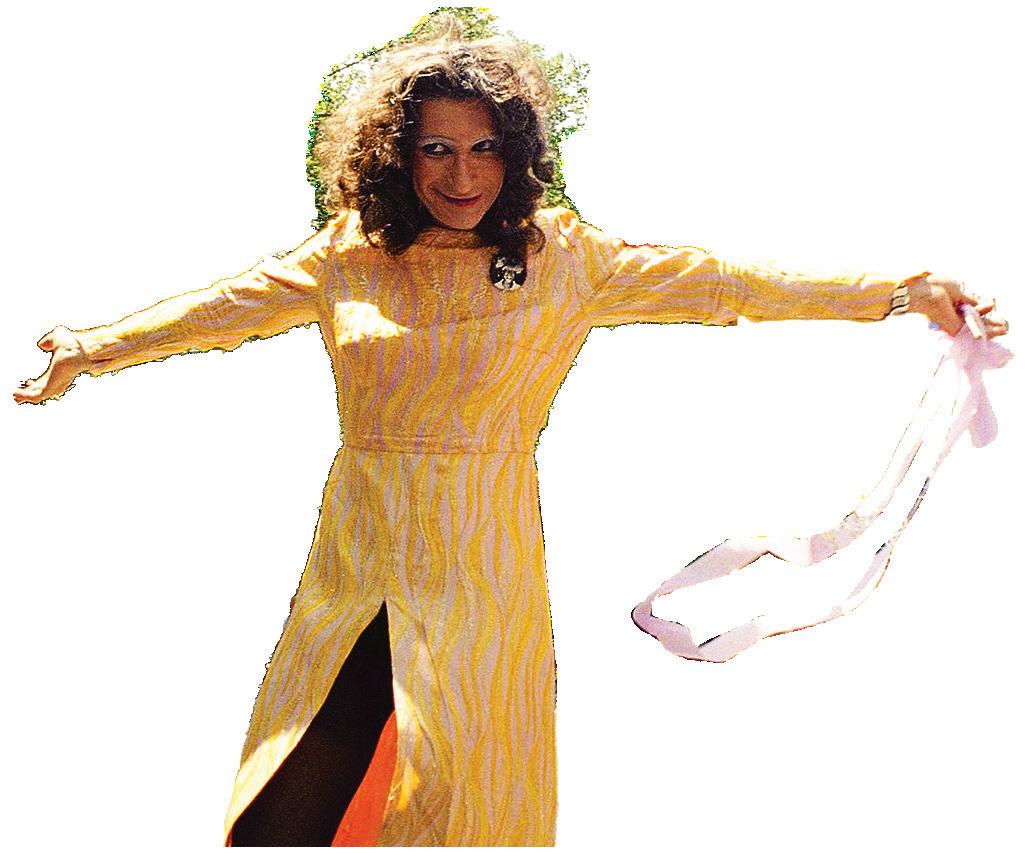

New LGBTQ History Course to Be O ered in Upper School

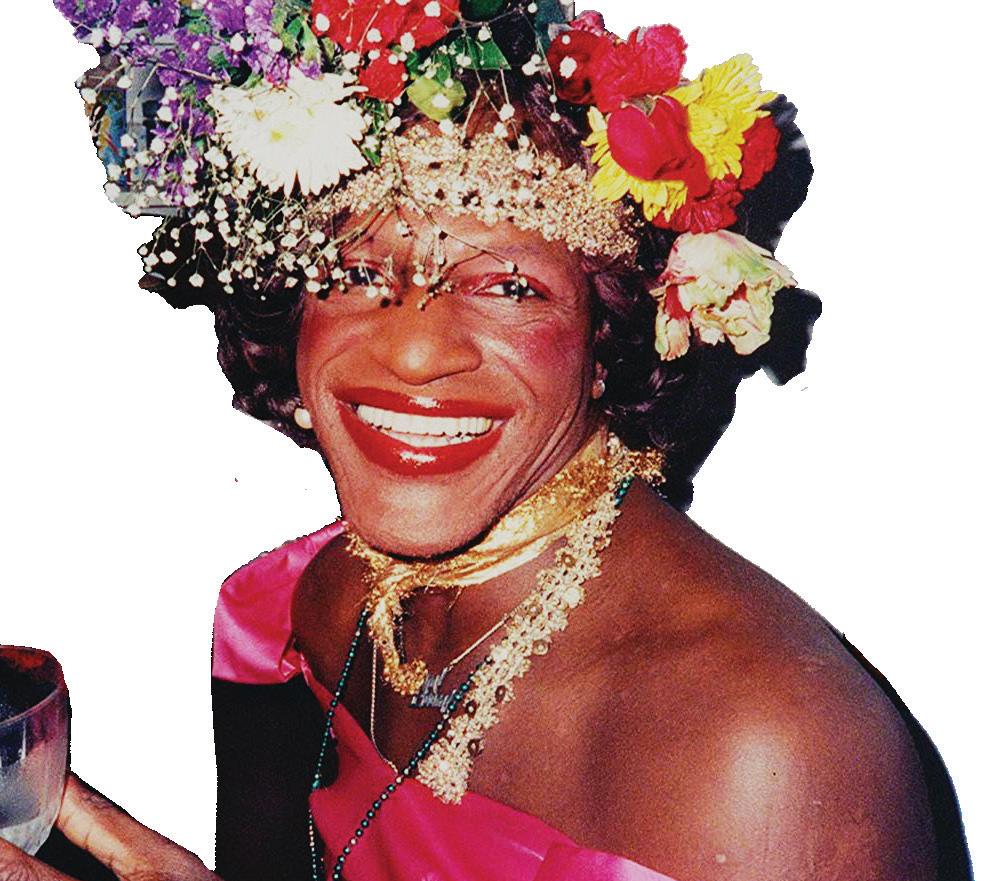 Khushi Chhaya, Ava Iwasko, Emma Nguyen, Ivy Stitt
Khushi Chhaya, Ava Iwasko, Emma Nguyen, Ivy Stitt
In response to recent increases in demand, the Upper School History Department is developing a new LGBTQ history course that will dive into the signi cance of the gay rights movement and the impact of LGBTQ activists and icons in society, culture and politics.


Upper School history teacher Ron Frankland will teach the semester-long, junior-senior elective in the 2023-2024 school year.
“As a queer person myself, I’ve thought a lot about how queer people are erased from history,” Frankland said. “I’m very happy that Greenhill is providing the opportunity for this course, as it is important work, especially whenever we’re thinking about how we can empower queer students and educate allies. Ultimately, all students should see themselves re ected in the history that they’re learning.”
Upper School History Department Chair Amy Bresie ’96 says she believes student response to the new course will be positive and enthusiastic. While she sees the class as extremely important to LGBTQ students, Bresie also hopes other students consider taking the course as well.
“No matter how you identify, I would hope that this would be a class that would be of interest and would be educational and would help people prepare people for being a human in the world,” Bresie said.
e Evergreen sta reached out to Upper School students to hear their views on the proposed course and why it is important that students are exposed to LGBTQ representation, as well as minority representation in general. Some of the students interviewed identify as LGBTQ, and some of those asked to be not identi ed as such for reasons of privacy.
Here is what the students said:
Representation is important because it prevents you from feeling alone in your journey. I remember being a middle schooler in a school with almost no queer people and where being queer was frowned down upon and I felt isolated from the rest of my community. Although Greenhill was a great improvement to the isolating environment I was previously in, there is still a lot of improvement to be done and I think having this class will be a big step in this direction.”
- junior Alex Peplinski
Everyone deserves to be seen and heard. Everyone deserves to see someone like them in history [and] media because there have always been minorities and minorities have always made an impact on people [and] history.” - sophomore Doodle Schultz
e LGBTQ+ community at Greenhill is so special. As a cisgender person, this community taught me so much about gender-queer community, the issues they face, how to be a better ally, and how resilient the community has been in the past and future. I can’t even imagine how powerful this course will be for allies and queer people alike. I am so excited to see how much positive impact [it] has on the Greenhill community. But more importantly, I am excited to see how Greenhill students take what they learn in the course and use it to make the world a better place.”
I think above all, I hope it provides meaningful education about the queer community and our history. I think for some reason discussions about social justice have been almost politicized and I think that greatly a ects our education system and how we learn about history and I’m just grateful that we get the opportunity to put this course on the catalog.”
- an Upper School student who asked to remain anonymous
I hope that more than just our LGBTQ+ community decides to apply for the course. If just LGBTQ+ teens know our history, then how would others ever learn to be open-minded about di erent experiences? e process of learning di erent histories is so important for keeping an open mind and growing as a person. It’s not a crime to be curious about things that don’t apply to you. With that being said, I hope this course sparks unity and curiosity in the Upper School as well as excitement for us queer teens who can’t wait to learn

I really hope that people who maybe haven’t really interacted with queer people that much can educate themselves and I hope that queer people at Greenhill who might not have time to learn about our history on top of school can learn about the people who are responsible for us being able to live freely. I’m really excited to take it and I think that this course is going to be a really fun and welcoming space for a lot of people, which makes me thankful for Greenhill.”
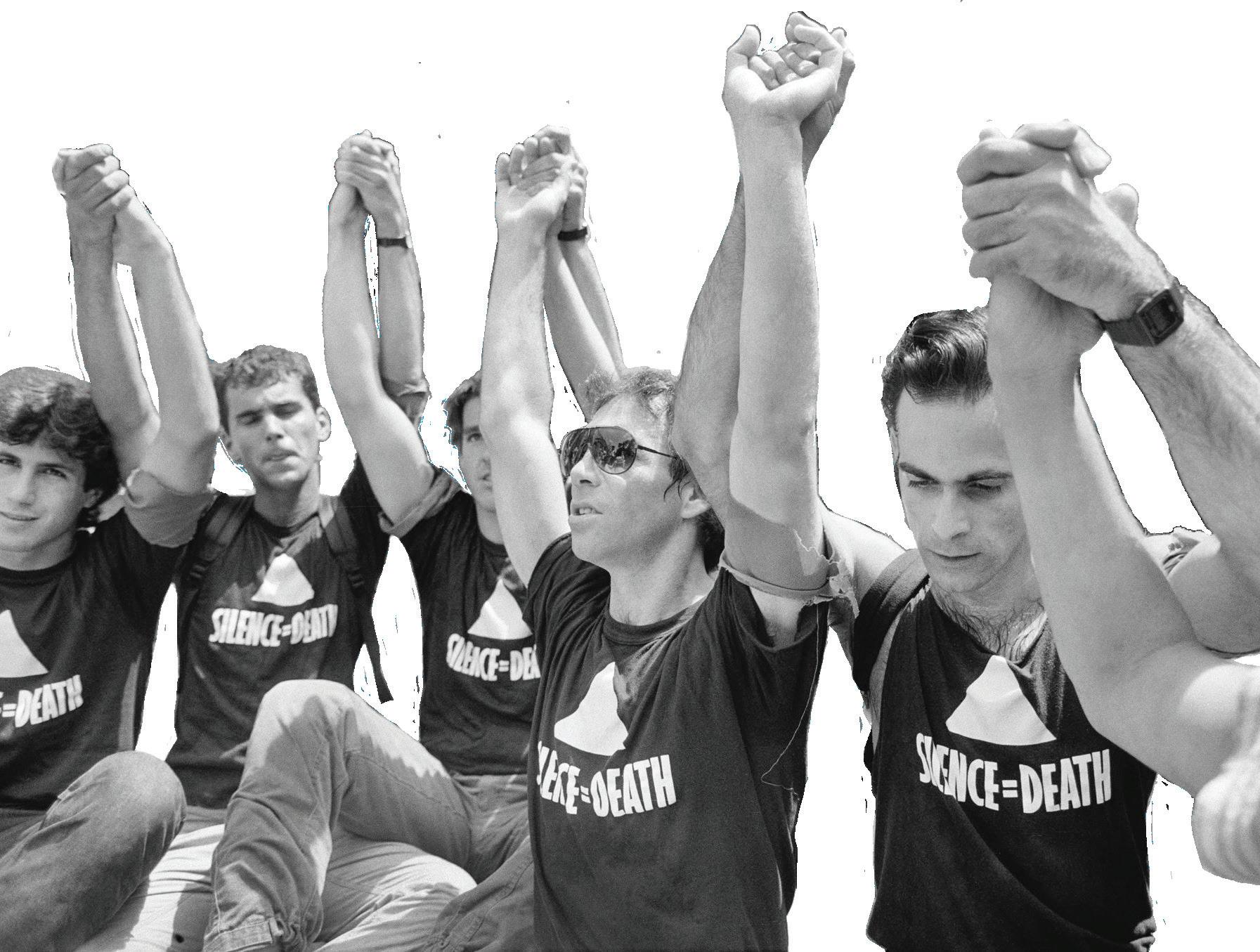 - junior Andy Simpson
- junior Andy Simpson
Features Evergreen the 9 Wednesday, December 14, 2022
Graphics by Khushi Chhaya and Emma Nguyen
Marsha P. Johnson
Sir Elton John
Sylvia Rivera
- senior Taylor Levy
ACT UP Protesters
Megan Rapinoe
Harvey Milk
“Big Fish,” Big Hit
Boisterous Fall Musical Brings Joy to Campus
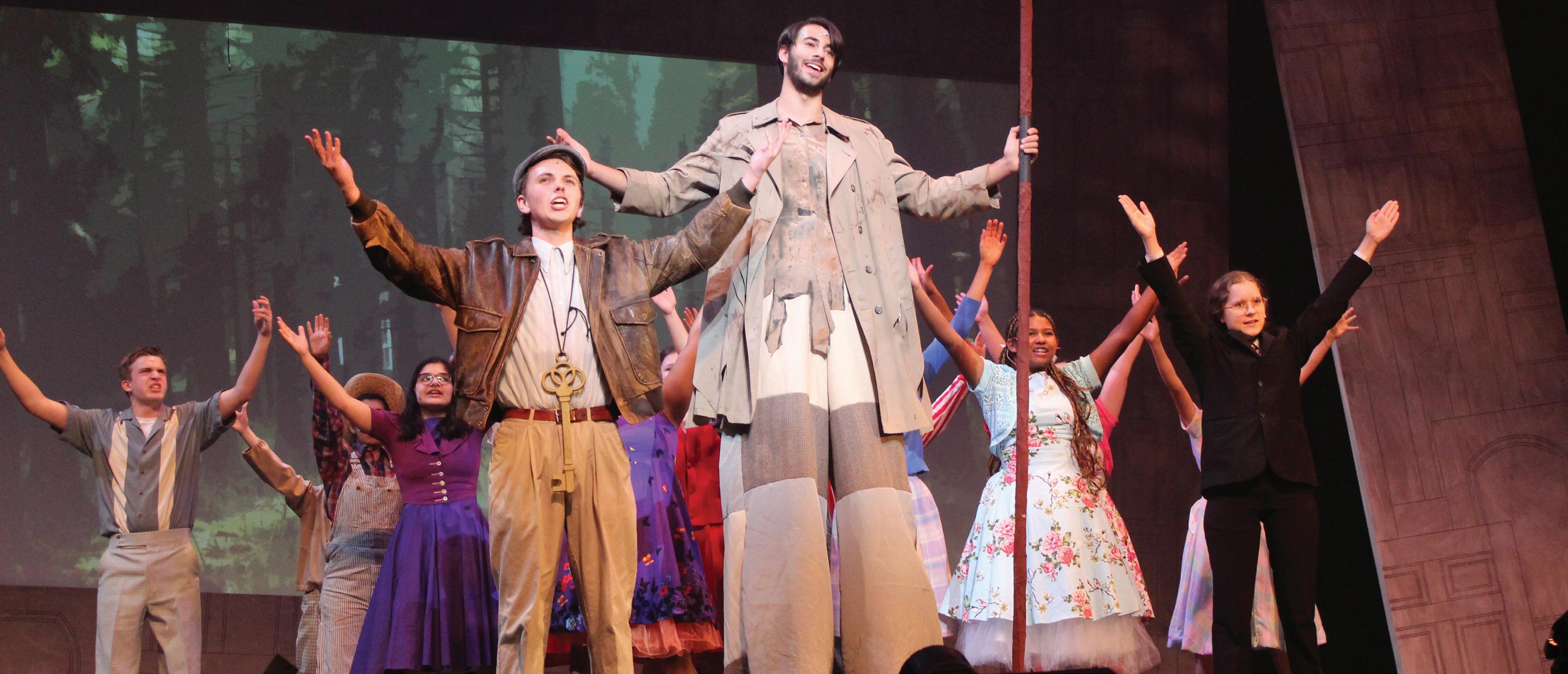 Ria Agarwal, Daniela Hallack
Ria Agarwal, Daniela Hallack
The 2022 fall musical production by Upper School students, “Big Fish,” played before appreciative Rose Hall audiences in three heavily attended performances on Nov. 17-18.

Upper School eater and Technical eater students were involved in every aspect of the production, both on and o the stage. Middle School Technical eater students also worked on the sets.
“Big Fish” follows the story of Will Bloom and his wife Josephine Bloom as they return to his hometown of Ashton, Alabama to reconnect with his family. Upon his return, Will Bloom learns that his father, Edward, has fallen ill. Will attempts to reconcile their relationship through reexamining the stories his father told him as a child.
Creating the Show
Work on the show began in September, with students auditioning for dance numbers, singing ensembles and acting roles.
“Auditions take about a week because we do it in several steps [and] we have singing auditions, we have dancing auditions and we have acting auditions,” said Upper School Drama and eater teacher Valerie Hauss-Smith.
“Big Fish” primarily focused on acting and dancing.
at di ered from the spring 2022 Upper School musical, “ e Little Mermaid”, which was largely centered around songs, Hauss-Smith said.
Once auditions nished and roles were cast in September, students began to block and run scenes with their ensembles. Blocking is the process of setting where characters are placed and how they move around the stage.
“We start running from scene one to scene eight. How does that look, what props do we need, what [set pieces] do we need to roll on,” Hauss-Smith said.
Additionally, the work of technical theater students enhanced the work of the actors and made the show come to life, senior Chancey Stefanos said.
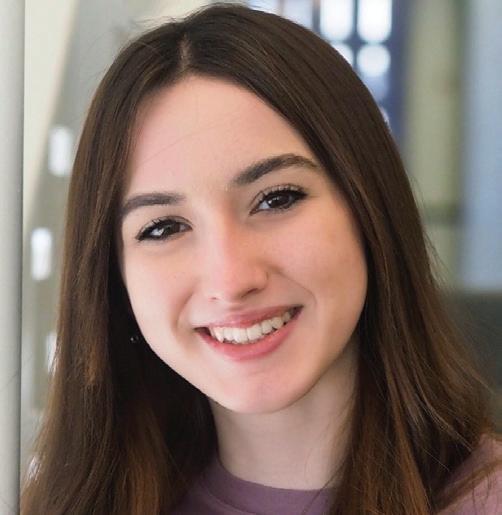
“I really do believe that while actors are the talent that we see on stage, tech [theater] is literally everything else,” Stefanos said. “You can get up there without a costume and just basic lighting and you can read and you can sing the song, but without tech you aren’t going to be transported into a di erent world.”
From sets to lights to sound, “Big Fish” incorporated a lot of di erent aspects of technical theater, which were integral to putting on an exciting show, Stefanos said.
In the days leading up to the show, Stefanos re ected on the work of technical theater students.
“I’m very impressed with how we have designed the set to be very exible to what we can do with it,” Stefanos said. “We have di erent set pieces that come in and out [and] di erent costumes for everything.”
Audience Reviews
A few students from the musical set up some preview events during Community Time for the whole Upper
School. e Upper School participated in a Quizizz trivia competition with facts about the musical and two actors sang one of their songs from the show.
“ e song that [senior Teddy Robertson] and [senior Erica Fulbright] sang during Community Time is really what convinced me to go watch the show,” junior Jeannette Yang said.
ere were 1,116 tickets sold across all three shows, with an even larger student audience than last year’s production that showcased a well-known Disney lm with popular songs. While “Big Fish” was also released as a lm in 2003, it was much less familiar to the student body, allowing the audience a chance to be surprised by its story.
“I have never seen the movie ‘Big Fish’ before, so I went into the show with an open mind and no expectations,” junior Dhilan Patel said.
With an open mind, audience members were able to enjoy the outcome of the construction and nal product of the musical.
“I thought it was really good and you could de nitely really tell how much hard work and preparation went into it as good as it was,” sophomore Jenna Travers said.
e lighting played a key part in the production and its e ects impressed many audience members.
“It was so cool when the lights would portray da odils, which were a big theme during the show,” sophomore Sophie Fiedelman said.
As with the lighting, the set work was a component that captivated audience members.
“My favorite scene was the carnival scene because there was so much going on, but everything worked together so well,” junior Dhilan Patel said. “ ere were plenty of funny moments from the background characters while the focus remained on the main characters.”
Team Building
When the production was concluded in November, there was still about a month le in the semester for the students involved. In January 2023, the class will switch gears and spend the semester working on the spring play, “She Kills Monsters.”
A er the show, the cast and crew engaged in many events, including a debrie ng post mortem, a potluck
party and team building exercises. ey also begin to prepare for drama competitions that some performers participate in.
“ e debrie ng is very important, because it allows us all to re ect on what went well, and what we can change for the better in the future,” Hauss-Smith said. “We talk about things like ‘How was the publicity? How did we end up getting all the props that we needed? How early should we be rehearsing with props?’”
One of the team building exercises in the past has been a group gingerbread decorating competition, HaussSmith said.
e class also talked about plans for upcoming events such as the spring play and the 2023 ISAS Fine Arts Festival, a performing and visual arts showcase for schools associated with the Independent Schools Association of the Southwest.
Post-Show Re ections
One challenge while producing the show was creating a sense of community among a large cast and crew, HaussSmith said. is proved especially di cult because of the group’s varying theater experience and age gaps.
“How do you create a community in which everyone feels just as valued and important when you have almost 60 people?” Hauss-Smith said. “Someone who is only doing makeup or helping with costumes needs to feel just as important as someone who is singing 10 di erent solo songs.”
To overcome this di culty, Hauss-Smith turned to juniors and seniors who have been participating in productions for several years to help guide younger and newer students.

“We relied heavily on seniors who had done this before,” said Hauss-Smith. “[Seniors] were tasked to welcome everybody in and show them the ropes.”
roughout the rehearsals as well as the show itself, Hauss-Smith was joyfully surprised when she saw how close the “Big Fish” cast had become.
She says her favorite scenes were the ones which had the whole cast included in some way. One special moment was the song “Be the Hero,” because it had everyone on stage and whoever was le o stage was throwing sh props onto the stage and singing.
“[ e big group scenes] were my favorite because they were the moments where people were truly shining,” Hauss-Smith said. “ e spotlights were on to make them stand out, and the fog and haze was coming on. I thought those moments were just incredible.”
Stefanos agrees.
“[I loved] getting to see those moments in a small scene with the fog and di erent lights,” she said. “I have watched these scenes be rehearsed for so long and being able to see how it all comes together and is really going to look to an audience
is very rewarding.”
e reason she loves being in the musical is because of the energy the audience brings, Stefanos said.
“People actually love to come see the musical, so hearing those reactions from the audience while you’re running the show is so much fun,” Stefanos said. “Hearing everyone laugh and clap a er every scene brings a totally di erent energy and
musical as a whole.”
up
10 Arts
member
experience which really amps
the
WORKING AS AN ENSEMBLE: The characters in “Big Fish” unite over their newfound love of Karl the Giant by singing and dancing in an ensemble musical number. This is one of several songs featuring a large group.
SAVE OUR TOWN: In one scene of “Big Fish,” cast members protest the construction of a dam that will cause the destruction of their hometown, Ashton, Alabama. The technical theater crew created signs for the protest.
Valerie Hauss-Smith
Chancey Stefanos
Photo by Daniela Hallack
Photo by Daniela Hallack
Evergreen the
Memory Makers
Yearbook Sta Chronicles Campus Life, Year by Year

Every year, a group of Upper School students works tirelessly taking photos, creating graphics and cra ing page designs. eir nal product: a nearly 400-page, student-designed book that preserves a year’s worth of campus milestones and memories.
At the end of every school year, students rush to grab their yearbooks, ready to look through pages for their names or sign those of their friends and peers. But what students don’t see as they ip through the intricately designed pages of e Cavalcade is the group of 30 students who dedicated the past year to creating this student archive.
“ e entire process is kind of crazy,” said Cavalcade Editor-in-Chief Sydney Pitts. “ design, gather content for, and they all have to look like a cohesive book. All people see is the product, though.”
The Process
At the beginning of the year the sta brainstorming phase, which includes determining the
continuously improve her skills as a section editor and learn how to cooperate with others to expand upon her personal creativity.
Seeing the unwavering dedication of her senior section editor leaders, Lian Hahn and Luke Brodsky, to their cra has inspired Weinstein to continue working hard for the Cavalcade, and maybe one day even lead younger students like Pitts.
Senior Bridget Hill, also an editor-in-chief, agrees with Pitts. When joining the Cavalcade sta as a freshman, Hill says watching senior editors and having hands-on
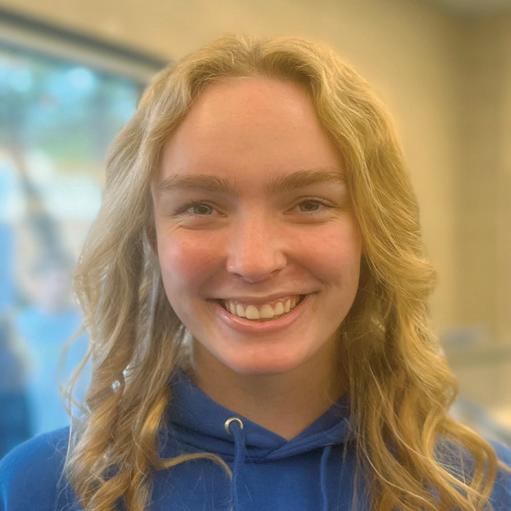
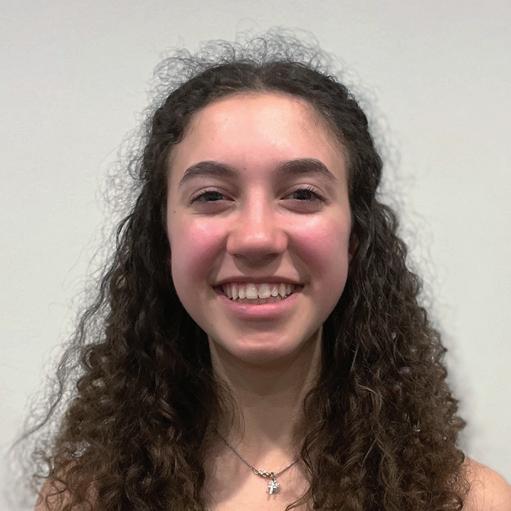
approach, said Cavalcade Faculty Advisor and Upper School Visual Arts teacher Lesley Rucker.
For the past few weeks, we have been working on making senior pages and sending them out to the publisher so we can get the ball rolling. We don’t like having to rush seniors by asking for content but at the same time it is crucial for us to make that deadline and having a senior page is a nice way of kicking o the yearbook.”
“I try to leave the process up to the students,” Rucker said. “I am essentially a facilitator, but the book
For Rucker, a student-led dynamic allows students to have their own creative space and increases the quality of the Cavalcade. At the same time, however, having so many creative students can pose some challenges when icting viewpoints clash.
Nevertheless, Rucker says that the Cavalcade gains far more than it loses by operating with a student-led working environment.
“I think it’s super important to the process,” Rucker said. “I think it’s always been that way to an extent. But part of it is helping students learn how to work with InDesign and Photoshop and how to create cohesive and striking page layouts. It’s so much easier to learn all these skills if you are doing it
Hill says that through this interconnected creative process she has learned so much from collaborating and looking at the works of her peers to improve her own creative designs.
“I think there is a lot you can learn from others on ,” Hill said. “I’ve been on the for a while now, but every day is still a new learning process
Aside from designing pages, another crucial aspect of the yearbook is the content. Finding content that attracts readers and ects the lives of students on campus is key to bringing the experiences of people within the Greenhill community to life, said Hill.
GraphicbyKhushiChhayaandDanielaHallack
“It’s really important that we are reaching out to di erent people on campus who are doing and making sure to keep in contact with them,” Hill said. “Part of our job is being active on campus ect what people are
Hill views the Cavalcade as one of the only historical archives of campus such, she believes creating the yearbook


Rucker agrees with Hill, noting that the Cavalcade documents Greenhill’s history and shows what campus life
“People are always saying that COVID has made people from di erent grades more distant,” Pitts said. “But I hope having newer kids on the sta working together with our seniors will help create new bonds and friendships along with improving the quality of the yearbook.”
Pitts says that the process has given students the opportunity to grow as artists, creators and student leaders.
“I think almost half of our sta is full of seniors who have been here since they were freshmen,” said Pitts. “ is means our sta has a really unique dynamic where we all know each other and can bounce o design ideas from each other.”
For Weinstein, this collaboration has challenged her to
“For the past few weeks, we have been working on making senior pages and sending them out to the publisher so we can get the ball rolling,” Pitts said. “We don’t like having to rush seniors by asking for content but at the same time it is crucial for us to make that deadline and having a senior page is a nice way of kicking o the yearbook.”
Student Leadership
Because the entire process is student-run, it can be chaotic at times, especially as publication deadlines
e books are always there,” Rucker said. “I’ve still got some of the earliest ones. It’s crazy. And that’s something that’s there forever. So you take pride in that, but it’s also a tremendous pressure to make sure that you’re doing whatever you can.”
With 130 pages already o to the publisher, a long journey is still ahead for the Cavalcade sta before students get to see the nal product in May.
“It’s a lot of work,” Pitts said. “But at the same time, what we do is so unique on campus, so at the end of the day, it’s all worth it in my world.”
11
Valerie Xu
Sydney Pitts
Bridget Hill
Wednesday, December 14, 2022
Arts
Centerpiece
SACRIFICING THE TOLL THAT SLEEP DEPRIVATION
impacting their performance on that day and in the long term.
hen the last class of the day ends, sophomore Aditi Vikram’s time at school is still far from over. Due er-school debate practice, she stays on campus for two more hours and arrives home at 6:30 p.m.
Upon arriving home, a long night of homework and extracurricular activities lie ahead. She starts by practicing clarinet for one to two hours, before attending a clarinet lesson and teaching clarinet lessons remotely to students in Canada. By the nishes eating dinner, completing homework and tutoring someone in India, it is already 2:30
Vikram is one of many students who has devalued sleep – not because she does not need it, but because sacri cing sleep feels like a necessity.
Importance of Sleep
is lifestyle of sacri cing sleep for days on end can be detrimental to student health, said Director of Service Learning and Community Engagement Jessica Chu. “ ere’s so many things that are happening while you’re sleeping that are helping you recharge,” Chu said. “If you don’t sleep enough, you cannot do simple tasks because your brain doesn’t know how to function normally. You need rest to be a person.”
Sleeping is important for daily function, not only so students can be present during school and when interacting with other people, but for the basic tasks that have to be completed during the day.
Vikram believes she can function e ciently if she gets seven hours of sleep – an amount she rarely gets. In any event, teenagers should get eight to 10 hours of sleep per night, according to the National Sleep Foundation.
“When we sleep, our body recovers, so we can’t engage in a ght-or- ight stress response if our body can’t recover and prepare itself to do so,” Upper School Counselor Kathy Roemer said. “When you’re scared, nervous, worried and anxious, our heart rate increases, our muscles get tense and our bodies need to do that. If we don’t get enough sleep, we can’t do that.”
Not being able to have a normal biological response to emotions leads to a feeling of tiredness throughout the day, said Roemer.
A lack of sleep saps motivation and energy, and that results in a drastic decrease in academic and athletic performance, according to a study conducted by the Cleveland Clinic.
Freshman Brian Chao says he consistently gets 10 hours of sleep a night, and it has improved his performance in classes.
“I de nitely notice a di erence,” Chao said. “Even getting ve to 10 less minutes of sleep makes me less intense and less e cient during the day.”
Sleep is also critical for student-athletes. Having less energy means not being able to sprint as fast or li as heavy of a weight,
“I try to get more sleep before game day,” said freshman Jin-Jing Huang. “Basketball requires a lot of endurance and focus. If I don’t get enough sleep, I’ll just get tired by the second quarter.”
ere are other activities also a ected by a lack of sleep. Vikram says in order to focus at debate tournaments and perform at her best, she needs enough sleep.
“Sleep is de nitely important, because if you’re not aware of what’s going on, if you’re not fully awake, you’re not going to hear what the other arguments are and you aren’t going to know what to say,” Vikram said. “If you start zoning o in the middle of the debate, that’s really going to a ect your success.”
Roemer agrees, noting that a lack of sleep and concentration makes the most mundane tasks seem di cult.
“If you don’t get enough sleep you struggle with focus, concentration and cognitive abilities,” Roemer said. “For teenagers, their brain grows when they sleep, so even the facts and information gathered all day long, it solidi es in our brain more successfully than if we aren’t sleeping.” is is key when it comes to tests or quizzes that students have to take. Studying until the last minute isn’t always the most cial course of action, because the information only goes in a student’s shortterm memory, said Roemer.
Sleeping allows that information to be processed and enter long-
“A lot of people like to study before tests, but it’s important for your brain to go into you can process the information that you are studying,” Chao said.
What’s most important, according to Roemer, is the consistency of sleep people get. Playing “catch-up” on the weekends doesn’t actually help make up for the lost sleep, and can in fact decrease people’s moods.
“You really can’t technically catch up on sleep, and sometimes when you sleep 12-14 hours, it can make you feel depressed, because you’ve slept too much,” Roemer said. “Or you feel guilty. If you balance it out and sleep consistently, that’s much healthier.”
Juggling Priorities
ere are a variety of factors that contribute to students’ lack of sleep. For most students, homework takes up a majority of their time outside of school.

“A lot of the time, you get completion grades on homework or it directly plays into what’s happening in class, so I have to stay up later to nish all my work or forfeit more time in the morning by waking up earlier,” junior Zoë Dzialowski said.






Huang echoes this sentiment.
“I have so much homework to do, which will de nitely take two hours,” said Huang.
As December break approaches, Huang says that she faces an even greater homework load, causing her to have less time to sleep than usual.
“
e week before break is super stressful, because it seems like all the teachers are scheduling tests at the same time,” Huang said.
“If I have many major assignments in the same week, I just become more sleep-deprived.”

However, homework is not the only contributor to sleep deprivation. Many student-athletes have sports practices or games that don’t end until the evening, causing them to push back other obligations.
“ e days that I have soccer practice and no other a er school stu , I get home at like 6:45,” Dzialowski said. “On days that I have soccer practice as well as eld hockey, I probably get home at around 8:45.”
During debate tournaments, Vikram experiences a similar problem as Dzialowski. A er arriving home late from debate practice, she struggles to nd time to complete homework without sacri cing sleep in the meantime.
However, the greatest challenge comes on the weekends. While some students can play catch-up and sleep more on weekends, Vikram is usually competing at a debate tournament. ese tournaments can run from Friday to Sunday.
“For debate tournaments on a Friday, we nish really late at night, like 9-10 p.m.,” Vikram said.
“On Saturday, we’d have to get 8 a.m. and stay there until however long. Between rounds, I feel like taking naps, because I’m so tired.”
Another cause of sleep deprivation is due to the distraction of social media. Both teachers and students alike recognize that it can feel like an obligation these days.
“Nowadays, there are so many distractions that it’s easy to go down the rabbit hole of YouTube, TikTok or Instagram,” Chu said. “I know some students who aren’t the best at time management and have to cram at the last minute.”
Huang says social media sometimes distracts her from completing her assignments.
“I have trouble staying o of Instagram at night. I usually start scrolling to take a break, then I get caught up in all the posts and stories,” Huang said. “I know it’s not the best use of my time, but it just feels normal to be keeping up with the next new thing.”
While social media may pose a distraction, along with all the obligations students have, they also need a break from work and time to spend with their friends. However, sometimes that comes at a tradeo to the little sleep students already receive, said Vikram.
“I rarely hang out with my friends because I usually sleep until 1 p.m. on the weekends,” Vikram said.
Roemer says it’s
Evergreen the 12
Sophia Li, Pooja Sanghvi
SACRIFICING SLEEP DEPRIVATION TAKES ON STUDENTS
important for students to have time to spend with their friends, not just for their mental health, but also because it is biologically important.
“I think there is still value in online friendships, and you can emotionally connect with people, but the presence of other people creates hormonal changes in our bodies,” Roemer said. “ e relationship and intimacy is di erent, and biologically, we need inperson friendships.”
On top of homework, extracurriculars, a er-school practices and the pressure to use social media, many students also face an implicit social pressure to excel at the expense of sleep.
I have trouble staying o Instagram at night. I usually start scrolling to take a break, then I get caught up in all the posts and stories. I know it’s not the best use of my time, but it just feels normal to be keeping up with the next


“I feel this pressure to constantly improve in basketball and academics,” Huang said. “I know some people who are just super athletic or super smart, so I feel like I need to work more in order to get where they are.”
Chu has also noticed students comparing the amount of sleep they get, o entimes in a way that glamorizes a lack of sleep.


“Some kids play what I call ‘misery poker,’ where they like to one-up each other on how little sleep they get,” Chu said. “It’d be like, ‘oh I slept six hours,’ and someone else says, ‘oh, I slept ve hours.’”
However, not every student is overwhelmed with a variety of obligations. Chao’s schedule allows him to get 10 hours of sleep per night.
“I wouldn’t say the course load here is too much,” Chao said. “It’s de nitely manageable for me and not too much of a challenge.”

Looking Forward
While sleep deprivation is a struggle among many Greenhill students, the more important conversation to be had is how to promote productive planning and sleeping habits.
To improve the quality of sleep

going forward, Roemer reminds students to eliminate any nighttime distractions from the room.
“I know this sounds cliched, but focus on having no phones in your bedroom, getting o your computer and reserving the bed for sleep,” she said.
Although there is o en a perception that quantity alone can lead to the most productive outcomes, Chu recommends that students be more selective with the quality of their studying.
There’s so many things that are happening while you’re sleeping that are helping you recharge.
If you don’t sleep enough, you cannot do simple tasks because your brain doesn’t know how to function normally. You need rest to
“I grew up in a stereotypical East Asian household and my mom and dad used to say I need to drill and kill,” Chu said. “But the idea behind that isn’t helpful. I try to tell kids you have to work smart, so you are being as e cient with your time as possible. Something I hope to tell my students is that sleeping more will actually get you a better grade because you’re more focused.”
Some students have also recognized the importance of balancing their schedules toward what works best for them. Vikram has taken two free periods this semester and will be
more conscious about reducing her future workload.
“I usually take a nap during both of my free periods, or I just do homework because I don’t want to ll more things into my schedule,” she said. “I just need to stop committing to things every time people ask me to volunteer. I also need to be more e cient on homework assignments for math, that there’s extra problems that are optional, but I still do them for practice.”
To prioritize sleep, Chao restricts his breaks to maximize productivity.
“One thing I did learn is from the start of the year I used to take too long of a break and too many of them,” he said. “Maybe just get one section of homework done, and then I recommend taking a ve- to 10-minute break and then getting more homework done. is will really shorten the amount of time you need to spend on homework.”
Ultimately, Chu says she hopes that students will utilize the support system available to them.
“When you have ve tests in two days, please talk to your teachers or talk to your advisor or talk to a trusted adult,” Chu said. “ is is where [learning specialists Grace Kiang and Honelynn Parker] are great resources. ere’s so many awesome people on this campus that are helpful in that. I know there are a lot of people here that that’s kind of their specialty.”
Roemer says that students are always welcome to stop by and talk to her about healthier sleeping habits moving forward.
“Know yourself and what you need, and make it a priority,” said Roemer. “Stop and think about if what you are doing is really working for you. If it isn’t, let people help you and embrace their advice.”
green Wednesday, December 14, 2022 13 Graphics by Emma Nguyen
Special Report
Lower School Equity and Inclusion Initiative Underway
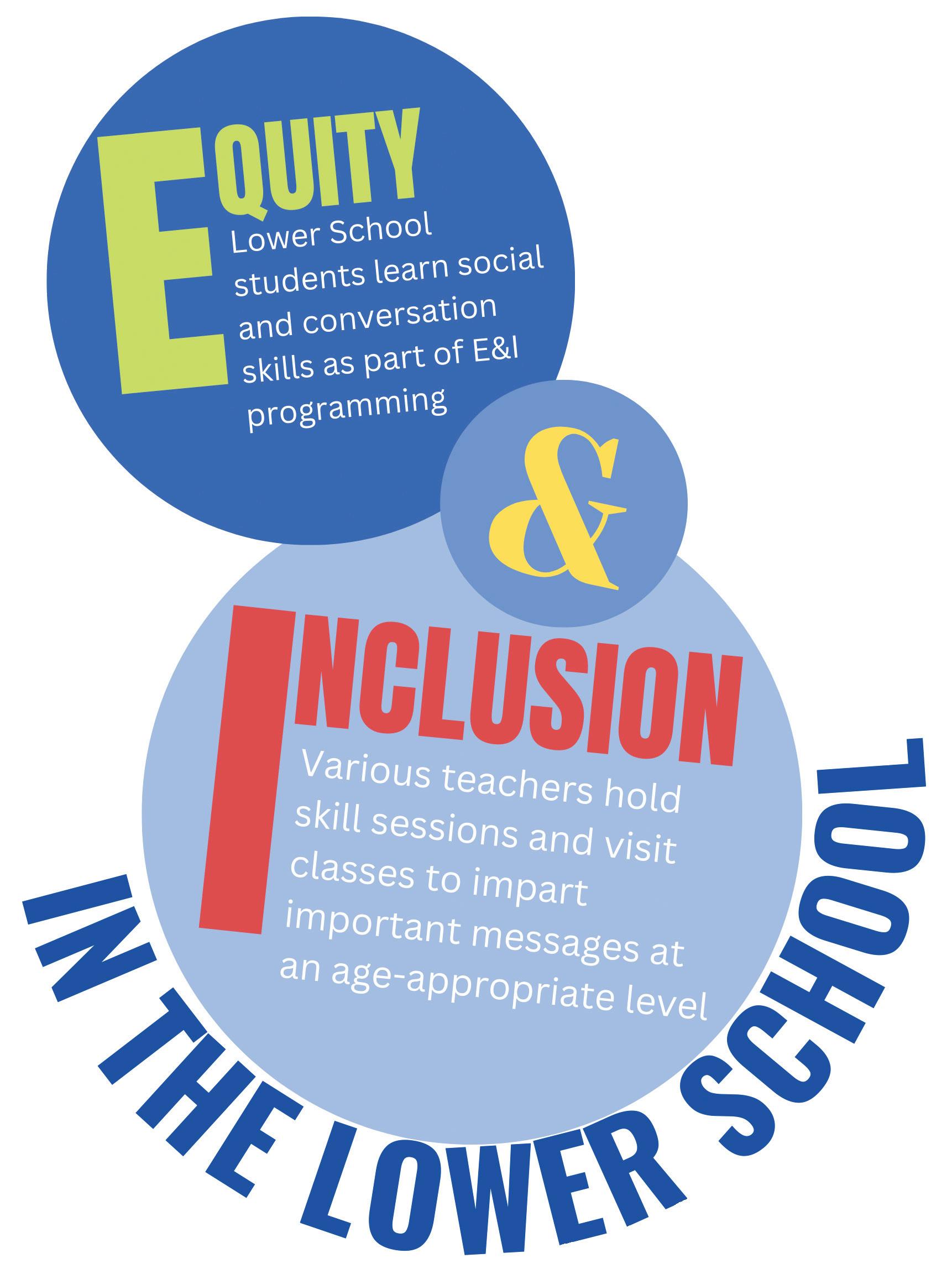 Sydney Chien
Sydney Chien
Aschedule adjustment last year allowed the Lower School to introduce an auxiliary program that covers technology usage, Social Emotional Learning and study skills. Now, an additional tweak in the schedule has given rise to the introduction of an equity and inclusion component in the auxiliary program.
“[The auxiliary program] is adding a sort of toolkit of skills for students in Lower School,” said Associate Director of Equity and Inclusion Monsie Muñoz. “[The Equity and Inclusion staff] is trying to teach students how to manage being in a community.”
These equity and inclusion-centered classes will begin in the spring of 2023. The hope is for these classes to fill a gap within the Lower School equity and inclusion curriculum, which has primarily focused on broader topics like inclusion within the context of Greenhill’s core values, said Head of Lower School Michael Simpson.
“It wouldn’t be like we could point to something and say, ‘well, that’s just E and I,’ you know what I mean, because for us, it fell more under the core values,” Simpson said.
The lessons seek to reinforce Greenhill’s core values by exposing children to concepts and discussions related to promoting equity and identity.
“At some point we have to be working toward starting to think about what Ms. Muñoz is talking about, specifically talking about gender with Lower School kids or race or any other identifier,” Simpson said
In the middle of the 2021-2022 school year, Simpson reached out to the Equity and Inclusion office, asking if someone would be willing to guide those more specific conversations with the rest of the Lower School student body.
Having previously taught as a second-grade fellow, Muñoz has been trained in guiding Lower School students to navigate through challenging topics regarding identity. So she volunteered to be an instructor for the new Equity and Inclusion curriculum in spring 2023.
“Our aim is to serve students from pre-K through 12 and, personally, a lot of my time has been spent in programming in the Upper School, and so I thought it would be great to be able to connect with Lower School students,” said Muñoz.
Over the summer, Muñoz developed lesson plans and created a survey that allowed Lower School teachers to provide input as to which curriculum topics should be covered. Across the board, the topics of gender identity, diverse family structures and inclusion were most popularly suggested.
The curriculum that Muñoz created based on these suggestions will initially be introduced to third and fourth graders but could possibly include even younger grade levels in the future.
“It’s really fun to talk with, you know, young blossoming [third and fourth graders] about some of the issues because they can start to relate it to their lives and then the lives of others,” said Simpson.
Critics
The subject of equity and inclusion work in schools has become a hot-button issue for some critics who label the efforts as teaching “white guilt.” These critics equate equity and inclusion lessons in schools with teaching Critical Race
Theory.
Simpson says he’s aware that some parents around the country have concerns surrounding this subject. He contends that an increased understanding of diverse cultures and perspectives will allow students to view identity from a more inclusive and analytical lens – something that Simpson says only reaffirms the core values of the school.
[The auxiliary program] is adding a sort of toolkit of skills for students in Lower School. [Equity and Inclusion staff] is trying to teach students how to manage being in a community.”
“I’m confident that if we get push back, I can sit down with the family and listen to their concerns and say ‘this folds into our school values and our school mission in this way. I want you to understand that and that’s why we’re doing it,’” Simpson said.
and it makes us a better community.”
Muñoz says that Greenhill’s commitment to equity and inclusion is a reflection of Greenhill’s commitment to its students.
“The opposite perspective for me is when we deny someone the chance to connect with their past, with their stories, with who they are and where they come from, we are stifling a lot of growth and potential in that person,” said Muñoz. “Consequently, we’re limiting ourselves as a community in our growth and in our aim to be a place that sees someone fully.”
Goals
Another aspect of the decision to formally add equity and inclusion to the Lower School curriculum is to ensure that there is a vertical connection between various grade levels.
picture of our graduate: What are all the things we can do to really lay the foundation in Lower School?” said Simpson. “What I presented to Ms. Muñoz and the office has an opportunity to enhance what happens later by building a stronger foundation in [diversity, equity and inclusion] at a younger age.”
I’m confident that if we get push back, I can sit down with the family and listen to their concerns and say ‘this folds into our school values and our school mission in this way. I want you to understand that and that’s why we’re doing it.’”
If all goes well this spring, there is a possibility they will be able to incorporate even more grade levels in the equity and inclusion curriculum. Muñoz says that
says that she has actually seen an opposite effect among students who have, for the most part, positively benefited from the inclusive mindset that an equity and inclusion education seeks to promote.
to this work is not from a deficit perspective, it’s from a celebration of who you are and a celebration of the diversity and differences in lived experience in our
community,” said Muñoz. “It’s actually a value-add to know who you are, to share that with others, because that means that you can bring so much more to the table,
14
Evergreen the
Upper School Musicians to Play at Carnegie Hall
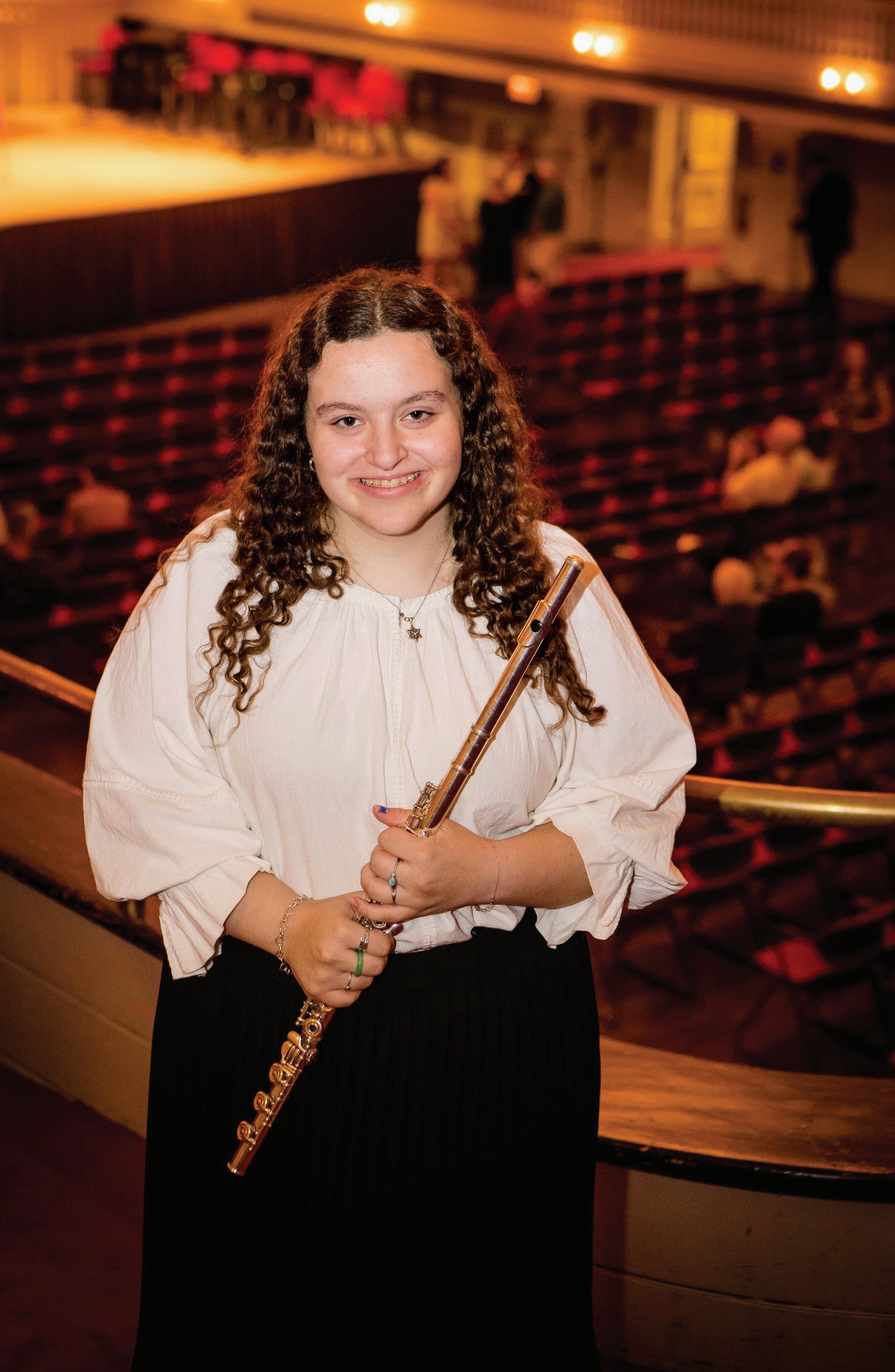 Varun Mukund
Varun Mukund
Senior Talia Dauer, utist, and sophomore Aditi Vikram, clarinetist, were recently selected to perform at Carnegie Hall in New York City on Feb. 4.

Dauer and Vikram applied to a selective organization called Honors Performance Series. is group displays the talents of young musicians in venues such as Carnegie Hall, the Sydney Opera House and the Royal Festival Hall at Southbank Centre in London.
“ is year, there were 10,000 applicants who submitted an audition, and approximately 500 were chosen,” Vikram said.
Dauer and Vikram began their applications earlier in
for the program in one year. Dauer was accepted into the Honors Symphonic Orchestra, consisting of string and band instruments, while Vikram was accepted into the Honors
Symphonic Band, consisting solely of band instruments. ey will have to reaudition for seating placement upon their arrival in New York on Feb. 1. ve-day program, Dauer and Vikram will be able to watch two Broadway productions, visit some of New York City’s most famous landmarks, perform under the guidance of renowned conductors and collaborate with other skillful and advanced musicians from around the world.
Love for Music
Both Dauer and Vikram say their passion for music was ignited at an early age, which has led them to achieve their accomplishments today.
perform at Carnegie Hall, so being accepted into this program was literally a dream come true.”
“I started playing piano when I was in kindergarten and that really sparked my love for music,” Vikram said. “So when I decided to play the clarinet, it was this passion that kept me interested and motivated to continue through high school.”
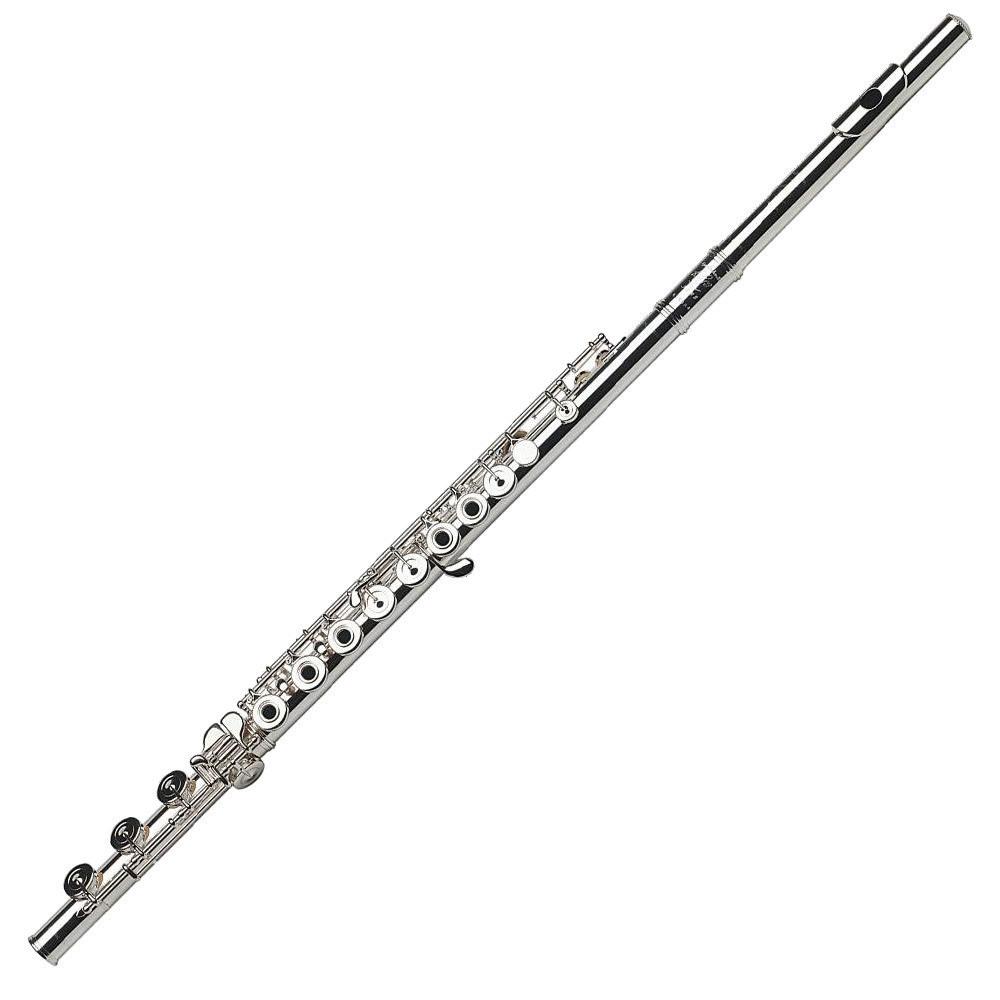
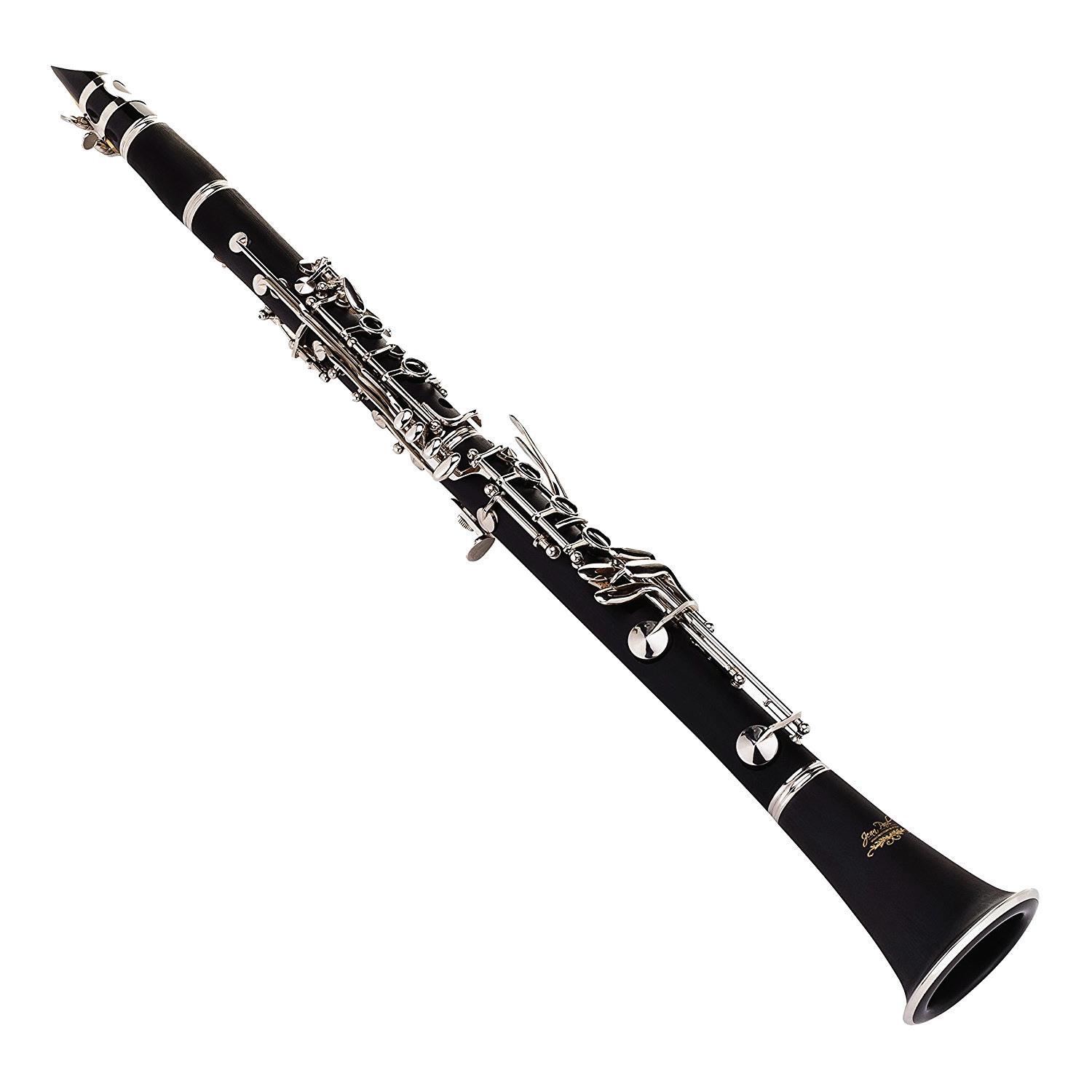
Dauer was brought up in a musicenvironment that inspired her to play the piano and eventually the
“My whole family is very music oriented,” said Dauer. “My dad loves listening to jazz, my mom played the cello, and my sister sings. When I saw that modeled in I naturally was inclined to did, I fell in love with it.”
Vikram and an avenue to performance.
“[Music] me feel have to English in school making music.”
Dauer says music allows her to forget her stress and worries from other aspects of her life because of the joy she nds in listening to music and playing her instrument. She believes the experiences she has had during her music career have had a positive impact on her life.
“I also met a lot of my good friends through music, even in elementary and middle school, which makes the whole experience a lot more fun,” Dauer said.
Playing an instrument starting at such an early age was bene cial for Vikram, as it allowed her to advance quickly and prepare for important events.
“I think that starting at a younger age was helpful because I was able to learn how to read music earlier which allowed me to learn other skills and grow as a musician,” Vikram said. “I think that gaining this experience bene ts me for competitions such as these.”
Listening to and making music inspires and motivates Dauer to contribute to the ensemble.

“When listening to music, I
talented people coming to create this one beautiful, harmonious sound,” Dauer said.
Student Leaders
Dauer and Vikram hope to use their love t the Greenhill Band. According to Middle School and Upper School Band Director Brian Donnell, both of them are go-getter students. ey both are hard workers and know how to practice and prepare correctly,” Donnell said. “ ey have great attitudes about playing an instrument. ey know how to set goals and work steadily to achieve those goals. Both are
When listening to music, I definetly feel inspired just by seeing all of these different talented people coming together to create this one beautiful, harmonious, sound.”
As a senior in the band, Dauer hopes to set a positive example for other band members.
e seniors take on the leadership roles in the band because we usually have the most experience,” said Dauer. “I try to be an example and a role model for the rest of the band to follow.”
Similarly, Vikram uses her own experience to mentor younger students in the Greenhill community.
“I have a free period during the h-grade Band class so I o en go and help them and play for them and be an example for them,” Vikram said.
Donnell is pleased with Dauer and Vikram’s achievements and contributions to the Greenhill Band.
“I’m proud of them for everything they’ve achieved, and they are leaders in our ensemble,” Donnell said. “ ey make our program better.”
Arts
15 Wednesday, December 14, 2022
CARNEGIE AWAITS: Sophomore Aditi Vikram, left, and senior Talia Dauer prepare for their performance at Carnegie Hall with the Honors Performance Series. Both were selected from a competitive pool of applicants.
MAKING MUSIC: In addition to playing with Greenhill Band, senior Talia Dauer performs at various venues.
Photo by Evie Kwei
Photo by Evie Kwei
Brian Donnell
I don’t have to worry about math tests, science labs, English papers or whatever we are working on in school because I just have to focus on one thing - making music.”
Open Mics Showcase Student Talent
Aria Kutty
The Arts Board has been organizing a series of Open Mic Nights to give Upper School students the opportunity to showcase their talents. e rst show took place Oct. 25, and the second on Dec. 13.

“Not a lot of students are able to t choir or the musical or other performing arts in their schedule because they are involved in other activities,” said senior Chancey Stefanos, a leader of the Arts Board. “ is is a great way to give everyone an opportunity to perform.”
e main event for Upper School ne arts students to showcase their talent is the Independent Schools Association of the Southwest Arts Festival which will occur again this spring. Students have the opportunity to perform at a co ee house at the convention, similar to Open Mic nights. However, only students enrolled in certain arts electives are eligible to attend.
e Open Mic nights serve as an opportunity for students who are not able to go to ISAS to showcase their talent to the Upper School.
Due to the casual setting of the show, many students feel the Open Mics are a great way to step out of their comfort zone.
“I think it is nice because it is very laid back, so if anyone wants to step outside of their comfort zone and try [performing] in front of crowds this is a great way to do that,” sophomore Ellery Sherwood said. “ ere aren’t any stakes and everyone is really supportive.”
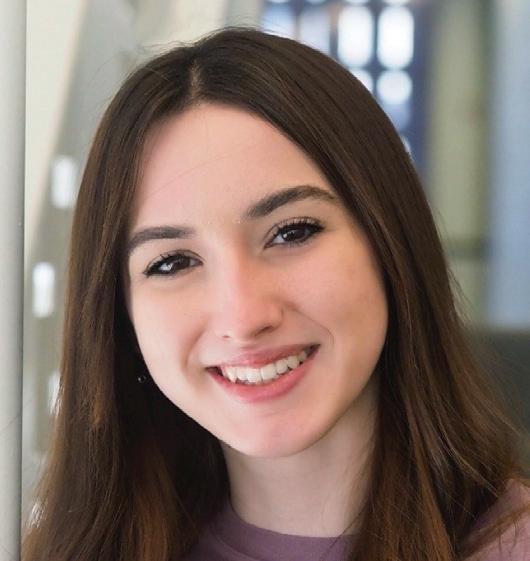

Not a lot of students are able to t choir or the musical or other performing arts in their schedule because they are involved in other activities. This is a great way to give everyone an opportunity to perform.”
Junior Michelle Phu was able to utilize this opportunity to try something new.
“For me it was honestly pretty scary because I haven’t sung a solo in so long,” Phu said. “I also sang with a band which was new, but everyone was so supportive, which was really cool.”
Setting Up the Show
To audition for the Open Mic night, students submit a two-minute video of their act to Stefanos. e audition is not meant to eliminate students, but rather to give Stefanos and the rest of the Arts Board leaders an opportunity to set up audio, backing tracks and speakers prior to the show.
“We prepare as much as possible to help the open mic run smoothly,” Stefanos said.

During the show, students can perform a wide range of performances, including a jazz quartet performance, slam poetry, a song or a monologue, among other things.
Sophomore Shreya Chhaya sang a duet with her sister, senior Khushi Chhaya, at an Open Mic last year. ey continued the tradition this year, singing “Both Sides Now” by Joni Mitchell.
“It is such a great way to give people who don’t normally get to do something like this the opportunity to perform in front of an informal audience,” Shreya Chhaya said. “ at is why I love doing these with my sister.”
e Arts Board plans the shows around
athletic events to ensure that the most students can attend.
However, many scheduling complications came up while planning the rst open mic.
“Planning it was hard because rst of all, [the fall musical] “Big Fish” was coming up,” said senior omas Bozalis, a leader of the Arts Board. “ at made it harder for us to use equipment because mics and stu were being used by the musical. Also, it was around Homecoming and Halloween, and then we had all that sickness. ere were a lot of things out of our control.”
Despite this, the Arts Board ended up nding a time to host this year’s rst Open Mic right before Halloween.
“We wanted to do a Halloween show because we thought it would be fun to decorate,” Stefanos said.
“Students could perform Halloween songs if they wanted, they didn’t have to, but that was fun.”
Shreya Chhaya
e second Open Mic took place on the last week of school and was co-hosted by the cast of the Greenhill Musical. is created a way for actors to perform before the start of next semester, as the musical had already passed.
“Support Your Friends”
e mantra “support your friends” has echoed throughout the halls this year in an e ort to build a stronger community through school spirit. However, some students feel that the mantra has been largely focused on sports. It has led to an increase in support for student-athletes, but not for many ne arts events, said Bozalis.
“A lot of people go to support the musical, but that’s really the only big thing,” Bozalis said. “Sometimes it feels as if that is the only big support that arts kids get.”
To garner student engagement, students within the Arts Board sent out multiple mass emails urging students to show up at the Open Mic.
A lot of people go to support the musical, but that’s really the only big thing. Sometimes it feels as if that is the only big support that arts kids get.”
“A lot of teachers came, and students came a er their practices,” Stefanos said. “Everyone had a really good time. It was very fun.”
In the future, the Arts Board hopes to bring attention to more events, including choir performances, Advanced Video Production lm screenings, band concerts and orchestra performances, said Bozalis.
“In the end, these shows form a little community and group of kids that can feel safe and supported which is so nice,” Phu said. “I love the environment that it brings.”
Arts
16
Evergreen the
Chancey Stefanos
SINGING HIS HEART OUT: Senior Teddy Robertson performs a song with guitar in October’s Open Mic event alongside other students showcasing their many talents.
Photo by Aria Kutty
“It is such a great way to give people who don’t normally get to do something like this the opportunity to perform in front of an informal audience. That is why I love doing these with my sister.”
Boys Basketball: A New-Look Team
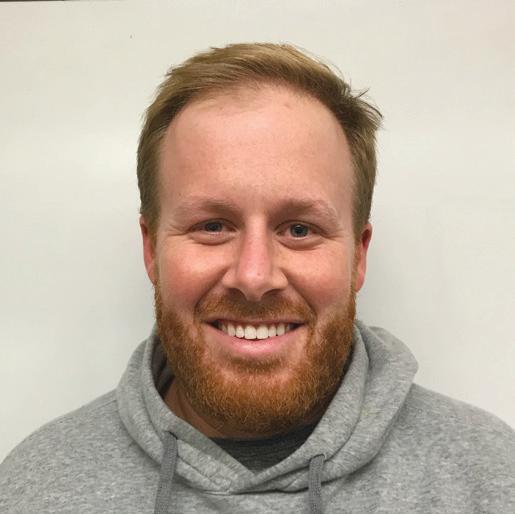
In a season lled with high expectations, last year’s talland- ashy varsity boys basketball team fell one point short of victory in the Southwest Preparatory Conference championship game. is year, a smaller-but-faster team is o to a winning start in the quest for an SPC title.


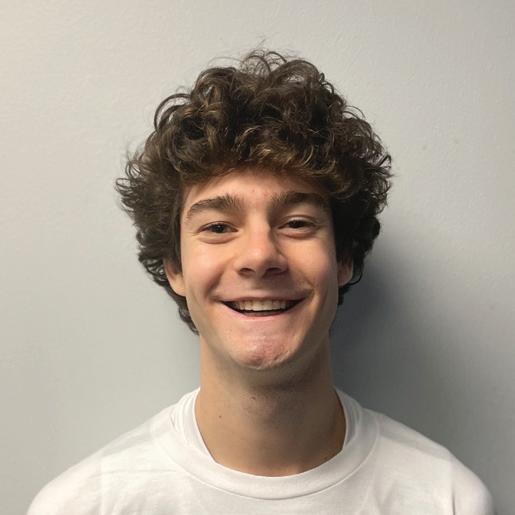
Last year’s team was built around height and star-power. e team consisted of three four-star players, including the 6-foot-10 Lee Dort ’22 and sweet-shooting point guard Noah Shelby ’22. e team went into SPC as the rst seeded team in the North Zone, nishing with a 7-0 record.
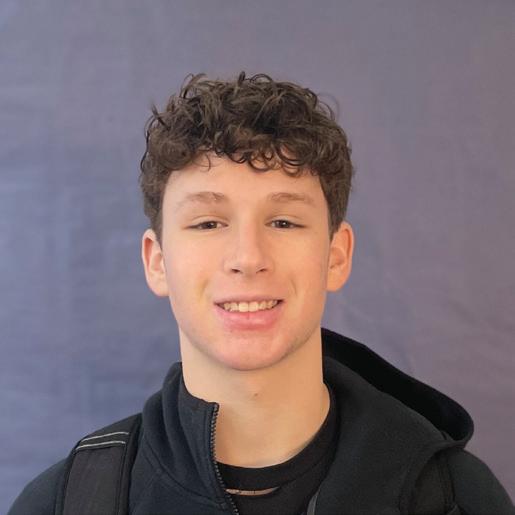
Apart from Dort and Shelby, last year’s team had four other seniors. ey were key to team leadership and boosting morale, according to senior Zac Slotnik. is year’s team consists of mainly underclassmen, with two seniors, one junior, six sophomores and two freshmen. e team only has three returning players: seniors Luke Brodsky and Slotnik, and sophomore Dillon Watt. All three were named captains of the team.
“ e three that are returning have been in the program for a while and they understand,” Head Varsity Boys Basketball Coach Joey Sims said. “ ey ll the captain [role] extremely well.”
Greatest Strength
Slotnik sees his role as a captain as providing leadership and support to teammates.
“Being there for others and being a leader is my role as a captain,” Slotnik said.
His primary goal is to make the transition to varsity easier for younger players.
“Regardless of skill, there is a jump between playing a [junior varsity] sport and a varsity sport whether it’s mentally or physically,” Slotnik said. “So, there will be some lapses, where people are building con dence and we’re aware of that, and we’re going to be able to push through that.”
e coaches have also changed the structure of practices to adjust to a younger and smaller team. ese changes include implementing a full-court press, which is a defensive tactic used to cover opponents throughout the whole court rather than just half. Slotnik says that the full-court press helps create more o ensive possessions and increase the pace of the game.
“Last year we were very dominant in the half-court o ense, and it was not fast at all,” Slotnik said. “ is year is going to be the complete opposite. It’s going to be fast, and it’s going to be pressing.”
Freshman starter Jaxson ompson believes that fullcourt presses have strengthened the team’s defense.
“I like the change because it ts our team and the personnel that we have on the court,” ompson said. “We have a lot of guards so it’s easy to guard full court.”
Coaches are also focusing more on stressing the fundamentals of the sport.
“Because last year’s team was so experienced, it was a lot more game planning and lm breakdown on the other team and strategy,” Assistant Varsity Boys Basketball Coach Parker Ainsworth said. “ is year is a lot more about us. It’s focused on what we’re doing and not as much on who we’re playing.”
Both Sims and Ainsworth hope to play into the team’s greatest strength: physical speed.
“For all the things we lack, we have a lot of kids that are very quick and shi y,” Ainsworth said. “Frankly, because they’re all around the same size, and all fairly talented, if person A is tired, person B is not a whole lot di erent.”
Although the team is still adjusting, it is only a matter of time before the team is where they want to be, said Brodsky.
Sims also has high expectations for the team competitively.
“I expect these guys to be very competitive and do everything they can to win every game that we play in SPC,” Sims said.
Mindset Shift
e shi s in team strategy have resulted in a shi in mentality with this year’s team, players and coaches said.
“[Last year], early on in the season we knew we wanted to compete for a championship, [but] it’s a little di erent this year,” Brodsky said.
Ainsworth says there has been less pressure on the team this year.
is year, the talk is ‘oh, they’re nowhere near last year’,” Ainsworth said. “So, we can take it game by game because the pressure is just to perform.”
ompson, a top scorer, says that his performance is a result of everyone’s hard work.
“We’ve been playing really good as a team,” ompson said. “So if it wasn’t for how the team is playing, I wouldn’t be able to score as many points as I do.”
Eight games into the season, the team was still undefeated. e team also placed rst in the Brookshire Tournament on Dec. 3 a er beating Village Tech Schools of Duncanville and Tyler’s Bishop omas K. Gorman Catholic School and All Saints Episcopal School.. Slotnik was named the Most Valuable Player of the
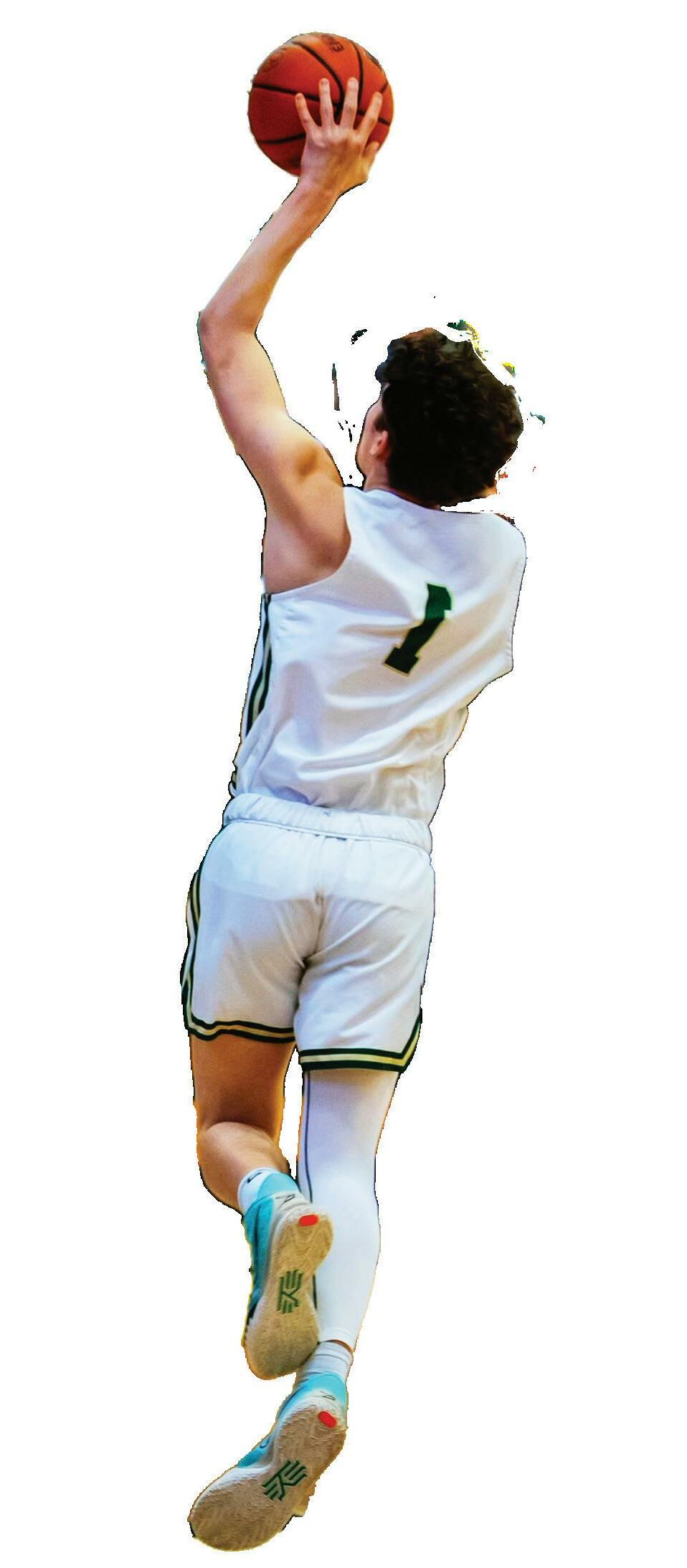
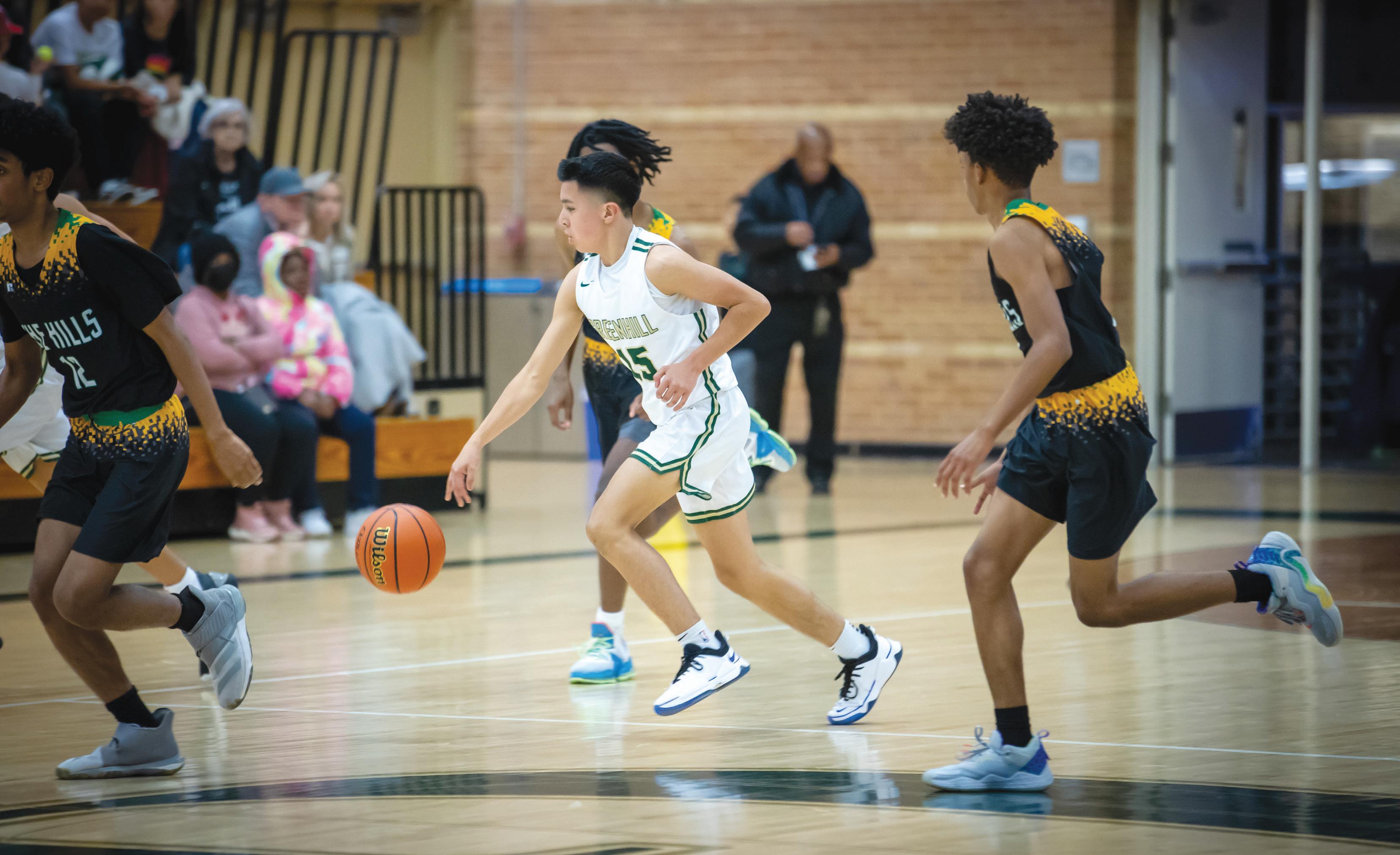
“It felt great to win the MVP of the tournament,” Slotnik said. “Someone needed to step up, and I was able to ll that role.”
ompson attributes much of the team’s success to changes that Sims has made during practices.
“Pushing the pace [helps us] get easy points on transition,” ompson said. “I feel like we’re one of the quickest and fastest teams so we’re able to capitalize o that.”
Fan Support
Due to high expectations for the team last year, bleachers were o en lled with eager fans to cheer them on. Players and coaches hope that this year’s games can continue to have the same student turnout.
“[Having fans] is really important because it motivates us to play better because all our friends are there,” ompson said. “It also brings a di erent kind of energy to the game and feels good having fans there cheering for your team.”
rough the start of the season, students have shown support much like last year.
“I will still attend the games because I think it’s still exciting to watch,” sophomore Amanda Park said. “[ e team] has people from all di erent grades, which I think is cool.”
Sophomore Liam Fagelman agrees.
“I will attend games because no matter how good or bad the team is, it is important to support your friends and the team,” Fagelman said.
17 Sports
“Our team is completely di erent, [so] our mentality is to go game by game, win by win and see where that takes us.”
Benjamin Weinstein contributed to this story.
Aman Jaleel, John Hurley
Zac Slotnik
Luke Brodsky
Jaxson Thompson
FAST BREAK: Varsity captain Luke Brodsky sprints down the court on a fast break after stealing the ball, looking to lead his team to some quick and easy points. Juan Barrientos trails behind him, ready to get the rebound.
Photo by Helen Jackson
Parker Ainsworth
Photo by Helen Jackson
THE SPLIT: Sophomore Juan Barrientos splits the double team on a fast break and hustles towards the basket. He keeps his head up in search for an open teammate to make an outlet pass, ghting to protect home court.
Photo by Helen Jackson
Behind the Scenes of Success
Managers Help Keep Sports Teams Running
Sadler-Knight and Susie Fagelman have similar responsibilities to omas-Dietrich.
With winter sports nearing the season midpoint, Upper School team managers are working hard to support athletes and coaches behind the scenes.
e role of team managers is to help ease the workload on the coaches and athletes.
eir responsibilities are varied: re lling water bottles, cleaning up equipment, collecting footage or noting key statistics.
“ ey’re responsible for setting up the elds and courts for every sport, getting ready for competitions, and anything else the coach needs,” said Head of Athletics and Physical Education Jarrett Shine. “I also want them to be responsible for collecting a lot of the media stu , like videos and action shots, so that when we do end-of-season banquets, we can put together the end-ofseason lm.”
They’re responsible for setting up the elds and courts for every sport, getting ready for competitions, and anything else the coach needs.”
To ful ll these responsibilities, team managers attend all games, as many a erschool practices as possible and High Performance Center workouts.
Senior Ellie Thomas-Dietrich manages the varsity boys basketball team along with senior Sophia Chao. Before practice, Head Varsity Boys Basketball Coach Joey
Sims gives her the practice schedule for the day.
During practice, omas-Dietrich runs the clock, re lls water bottles and performs any other task to help streamline practices.
“I just try to make practice easier and more organized for both the coaches and players,” omas-Dietrich said.
It’s a little more intensive. I have to be keeping stats in the book and paying attention, giving the players water and then cleaning up after.”
ese responsibilities become even more critical during games.
“It’s a little more intensive,” she said. “I have to be keeping stats in the book and paying attention, giving the players water and then cleaning up a er.”
Sophomore Dillon Watt, a starting member of the varsity boys basketball team, says that omas-Dietrich is always committed to her role.
I just try to make practice easier and more organized for both the coaches and players.”
“She’s very on point and dedicated,” Watt said. “She always runs the scoreboard well and is helping out.”
Varsity girls soccer managers Ze aniah
ey put away the equipment, ll water bottles, prepare any equipment necessary for practice, fetch any shot balls that go amiss and run through drills with the team.
“We’re at all the games, and almost all the practices,” Sadler-Knight said. “I rarely miss a day.”

At games, these managers set out the pre-game balls, ensure the balls are properly in ated, put the weights on the goals, ll out the scoring sheet and cheer on their team.
At times, these tasks can feel exhausting, Fagelman said.
“I’m not exaggerating, I probably have lled up over 100 [water bottles],” she said.
Junior varsity girls soccer starter Elizabeth Mann appreciates the manager’s e orts to make practice as e cient and focused for the athletes as possible.
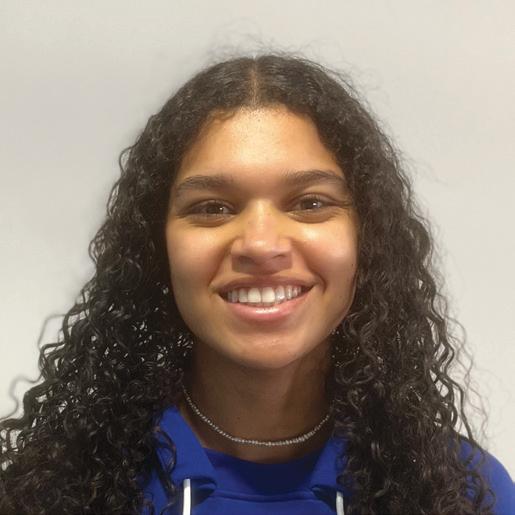
“ ey are great at helping shag the balls for us and do the little things to help practice run smoothly,” Mann said. “All of the little tasks add up, so it’s super helpful to have them and be able to maximize our time on the eld.”
Senior Peyton Jacobe is the team manager for varsity girls and boys swimming. Her main responsibilities entail helping at swim meets, lming and photographing swimmers competing, and doing anything that Head Varsity Swimming Coach Patti Monzingo needs.
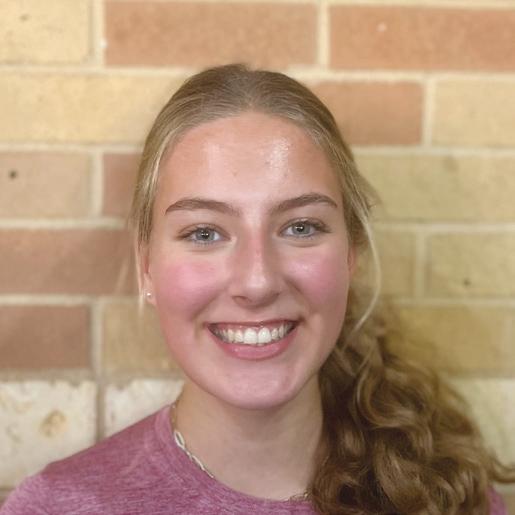
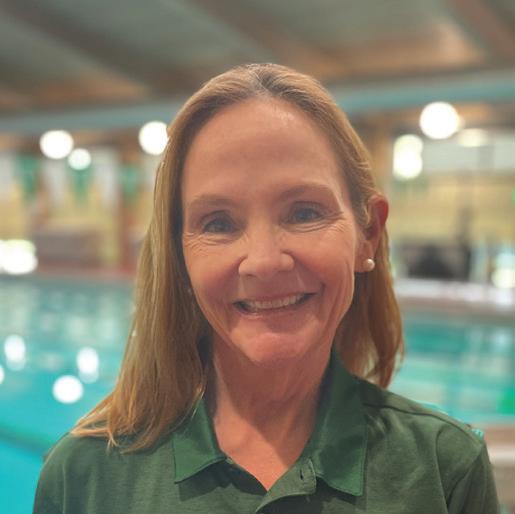
“Because the swim team has never had a manager before, I wasn’t aware that it was something I could do,” Jacobe said. “When Coach Monzingo asked me if I would like to manage, I was happy to have the opportunity to help the team.”
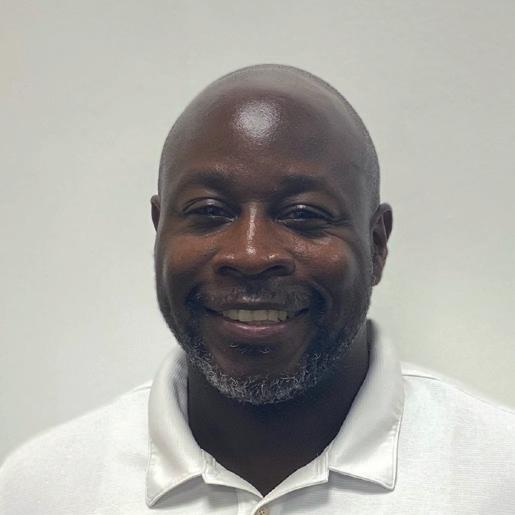
They are great at helping shag the balls for us and do the little things to help practice run smoothly. All of the little tasks add up, so it’s super helpful to have them and be able to maxmize our time on the eld.”
Another of Jacobe’s goals for the upcoming season is to boost team morale and support.
“I think being a manager is a great way to show dedication to the team while providing extra help, and I’m looking forward to the rest of the season as manager,” she said.
e experience of managing a team can be rewarding, students said. Since managers work closely with athletes and coaches, they can form meaningful friendships.
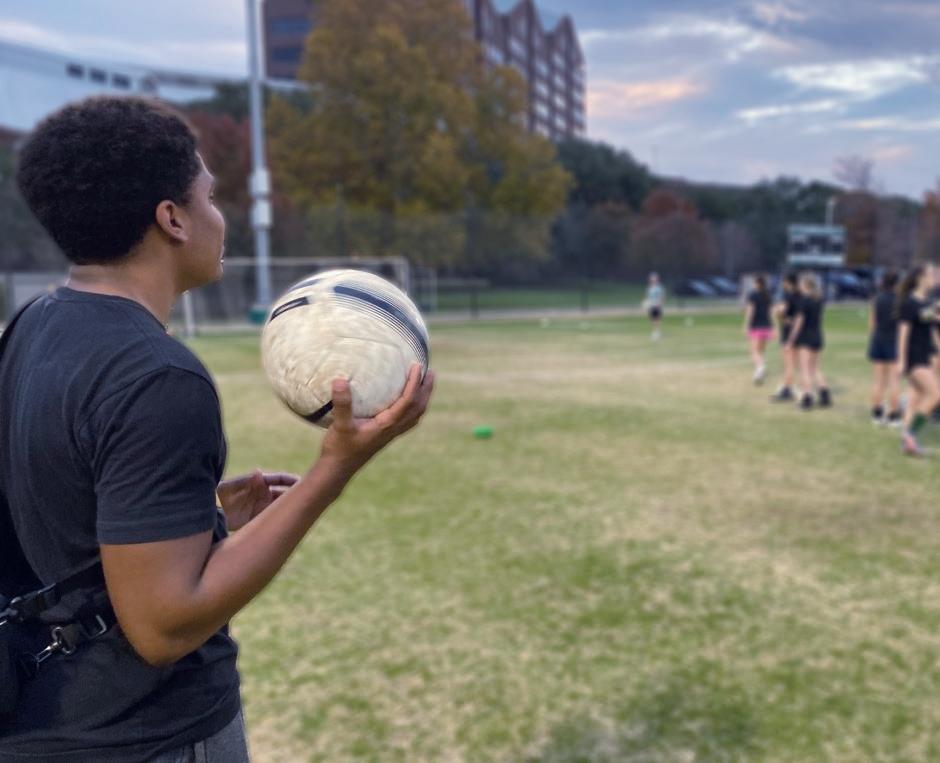
“Managing is just a great way to still be involved and be a part of the team without actually doing the sport,” Fagelman said.
Current managers say there are certain skills that are essential to success in the role.
“Organization is key when you’re a manager,” omas-Dietrich said.
Fagelman emphasizes the importance of a positive attitude during practices and games.
“Be really outgoing, cheer on your teammates, because they really appreciate it,” Fagelman said. “It motivates them to try harder and be super positive. Just try and help out as much as you can and know that you are there for a reason.”
18
Sports Evergreen the
Josie Arbuckle
Jarrett Shine
Ellie Thomas-Dietrich
Patti Monzingo
DEDICATION: Despite the cold weather, girls soccer manager Ze aniah Sadler-Knight stays at practice to assist the coaches and players in various ways.
Photo by Christan Park
Susie Fagelman
Evergreen the 19
Star Swimmer Shatters Team Records
Andrew Mann, Ravi Vasan
Walking into the Ginsburg Natatorium, there is a wall dotted with all the school’s swim records. ese are the fastest times any Greenhill student has swam in each event. Many swimmers dream of being on that wall, but it takes an elite level of dedication, determination and skill to get there.
While junior Josie Arbuckle did not realize during her childhood in California that she would nd herself striving to get on that record board, she was always in the water. Arbuckle was two months old when she rst dipped her toe into the water, and at age six, she joined her rst swim team.
During her rst two years at Greenhill, she has set two records and has been working in the o season to break more. In her sophomore season, she broke a 10-year record held by Claire Brandt ’10 in the 200-meter freestyle with a time of 1:51.11 seconds, a full 2.24 seconds faster than the previous mark.
Arbuckle also holds the record for the 200-meter individual medley, where a swimmer cycles through all four strokes – butter y, backstroke, breaststroke and freestyle – swimming 50 meters of each.

Head Varsity and Middle School Swim Coach Patti Monzingo marvels at Arbuckle’s drive for excellence.
“Josie already has two of the records on the board right now, and she came up to me the other day, and she said, ‘Hey coach, I’ve got club times that are faster than three of these swims on the board,’ and I said, ‘Alright, which ones are you gonna break rst?’” Monzingo said.
a er classes and two morning practices a week with the school team. She also goes to Monday a ernoon practices with the team, the goal being to li the team’s morale, Arbuckle said.
“She’s motivated to work hard because she knows she sets an example for the rest of the swimmers,” said her brother, sophomore J.J. Arbuckle. “ e fact that she is swimming at a really high level inspires the freshmen and the others.”
With such a demanding swimming workload, Josie Arbuckle said that burnout is very common in high-level swimming. She has friends who have quit the sport.
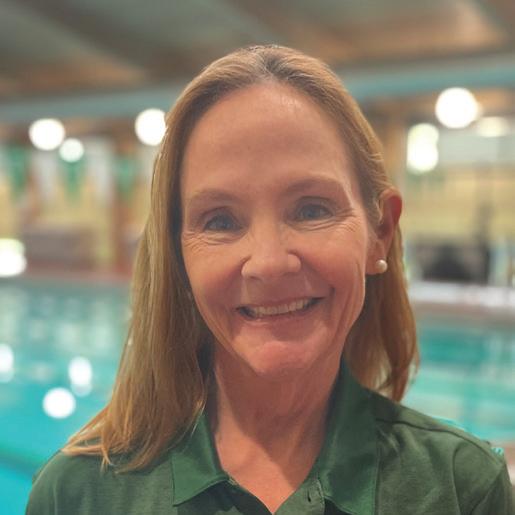
Josie already has two of the records on the board right now, and she came up to me the other day, and she said, ‘Hey coach, I’ve got club times that are faster than three of these swims on the board,’ and I said, ‘Alright, which ones are you gonna break first?”
“Getting burnout is really easy in a sport like this,” said Josie Arbuckle. “I’ve seen a lot of people do it, I have seen a lot of people lose their love for it, and it’s kind of scary. You have to genuinely be obsessed with it to pursue it at a high level.”
One way that she has dealt with the monotony of swimming is with the team camaraderie that exists in her club and school teams.
She describes her bonds with her Dallas Mustangs teammates as familial, which is unlike most competitive teams, she said. She also notes that keeping this light-hearted relationship with her friends and coach helps her manage that stress inherent in competitive swimming.
but those don’t count as school records. To get a coveted spot on the record board on the Ginsburg Natatorium, she has to swim a record-beating time in a

A team goal for this season is to beat all the existing relay records, Josie Arbuckle said. In their opening meet, the team missed breaking the 10-year record in the 200 by just over one
A broader team goal is for each member to dedicate
and I always feel so much better when I am done with a workout,” Arbuckle said.
During the summer, Arbuckle swims two practices per day, including weekends, with the Dallas Mustangs, an elite club team where she is a member of the national-competitors group. She also li s weights with her personal trainer on Mondays, Wednesdays and Fridays.
During the school season, Arbuckle’s workout load decreases a little, moving to one practice a day with her club team
positive outlet, and I always feel so much better when I am done with a workout.”
Now in her third year, Josie Arbuckle is attempting to embrace the recent change in team culture, with the intent of being more inclusive to all swimmers, regardless of their speed or experience. She hopes that this will help the team rebound from their ninth-place nish at the 2022 Southwest Preparatory Conference
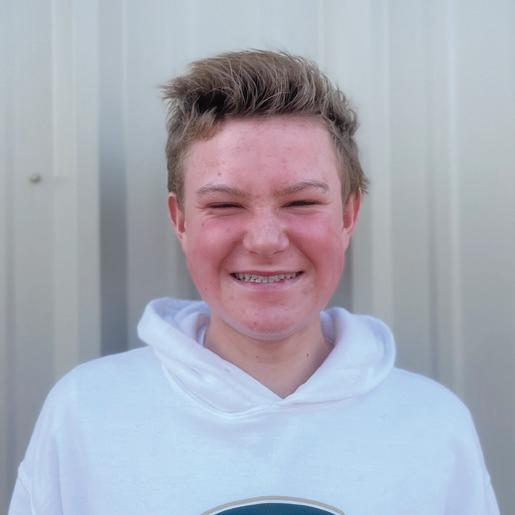

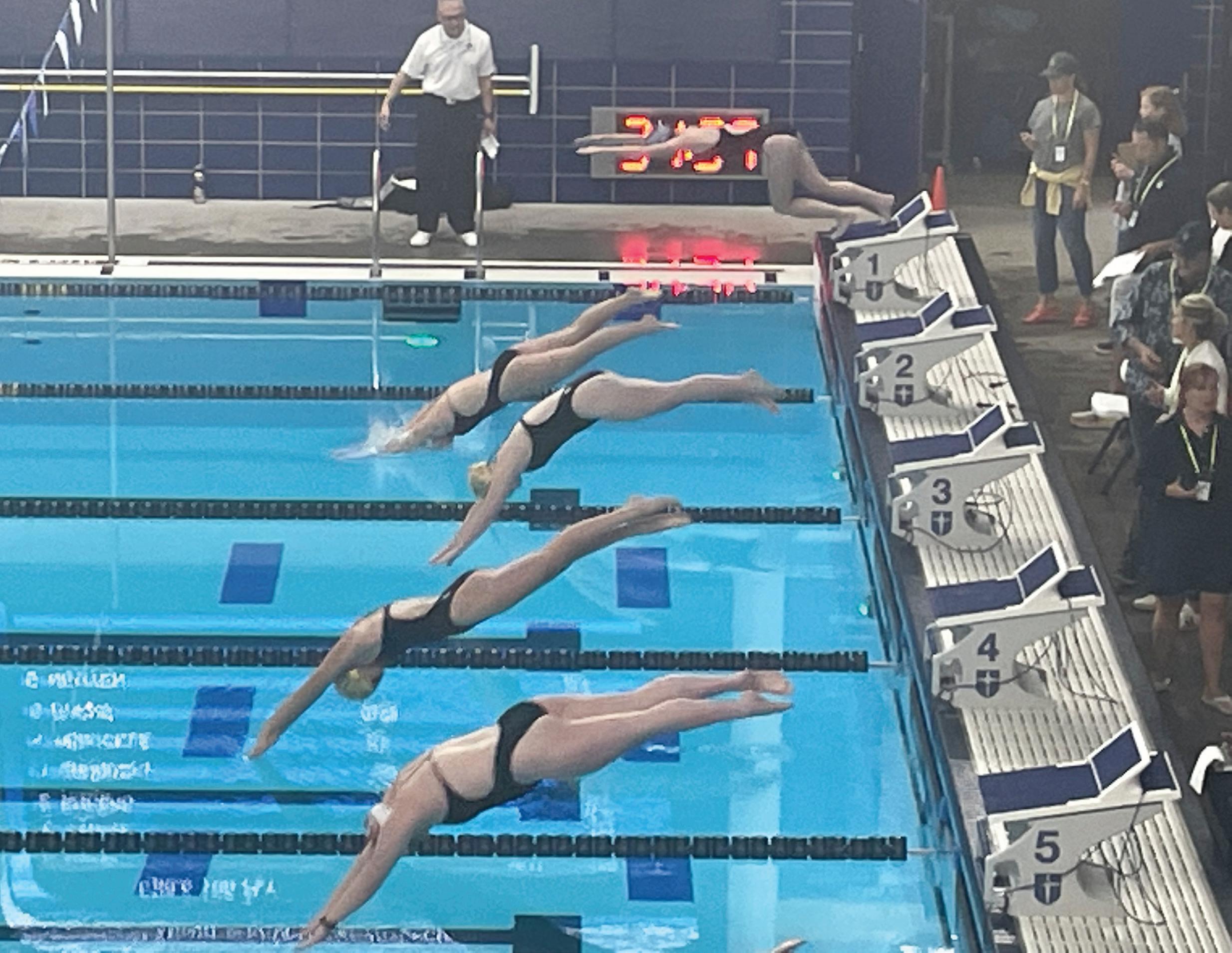
grade and experience levels.. While I’ve been on some teams that tend to separate because of this, I think this group of girls has done the opposite. We all intermingle with one another, and everyone really knows everyone.”
A year a er being named the Most Valuable Player on the girls team, Josie Arbuckle has stepped con dently into a leadership role. She is the only varsity captain of the girls team this season.
“As captain, I have a little more power, and I can work with underclassmen and work with other people to try to build a better community because historically when I was an underclassman, the team wasn’t as close as it is now,” she said.
Team First
In her junior season, Josie Arbuckle is attempting to break even more Greenhill records. While swimming for the Dallas Mustangs, she has put up school-record times in the 50-meter freestyle, 100-meter freestyle and 100-meter backstroke races,
is another attribute that impresses her
“She looks to see what she can do for the team, and it’s not just ‘me me me,’ it’s more ‘how can I help the team?’ and ‘what can I do to make the whole team better?’” Monzingo said. “She’s been a leader ever since she [was] a freshman. I have been extremely impressed by her.”
This year, I think our team culture is really great. The girl’s team is made up of a wide range of grade and experience levels.
While I’ve been on some teams that tend to separate because of this, I think this group of girls has done the opposite.”
Looking toward her future in swimming, Josie Arbuckle has started the college recruitment process. She has taken uno cial visits to the University of Notre Dame, the University of California Berkeley and Texas A&M University.
“I’m looking for a program that is very strong athletically and academically,” Josie Arbuckle said. “I hope to use my swimming as a springboard to get me there not only as an athlete but also as a student, which in the long run is more important.”
Wednesday, December 14, 2022
Sports
MAKING A SPLASH: Junior Josie Arbuckle dives from the blocks at the beginning of her race. Already holding several records, she’s pushing to break more this year.
Photo by Josie Arbuckle
Josie Arbuckle
J.J. Arbuckle
Patti Monzingo
Graphics by Emma Nguyen
Aliki Pappas Joins Athletic Training Sta
diploma later this month.
It was through a sports-related injury during her senior year of high school that Aliki Pappas found her passion for athletic training.
During her rst pre-season basketball game, Pappas tore her anterior cruciate ligament, her medial collateral ligament and both menisci simultaneously. e injury ended Pappas’ high school athletic career.
“I was devastated,” said Pappas. “I was upset pretty much my whole senior year.”
rough this injury and the months of rehabilitation it required, Pappas developed an appreciation for sports medicine. Although she had planned to study sports journalism in college, Pappas went on to major in athletic training at the University of Texas at Austin.
Within her rst few college classes, Pappas learned that athletic trainers must be empathetic, rather than sympathetic, with their athletes. Her professors taught her that she had to understand where the athletes were coming from, but not share in their sadness, as it would add sorrow to the athlete’s devastation, she said.
is lesson was the turning point for Pappas; she knew sports medicine was her passion.
“I de nitely know and can relate to athletes better because I know what it’s like to have something taken away from you in a split second because of one injury,” said Pappas.
Path to Greenhill
A Dallas native, Pappas attended e Covenant School for high school; she was a member of the school’s girls volleyball, basketball, tennis, and track teams. Pappas practiced shotput and discus throwing bi-weekly at Greenhill’s track and eld facilities.
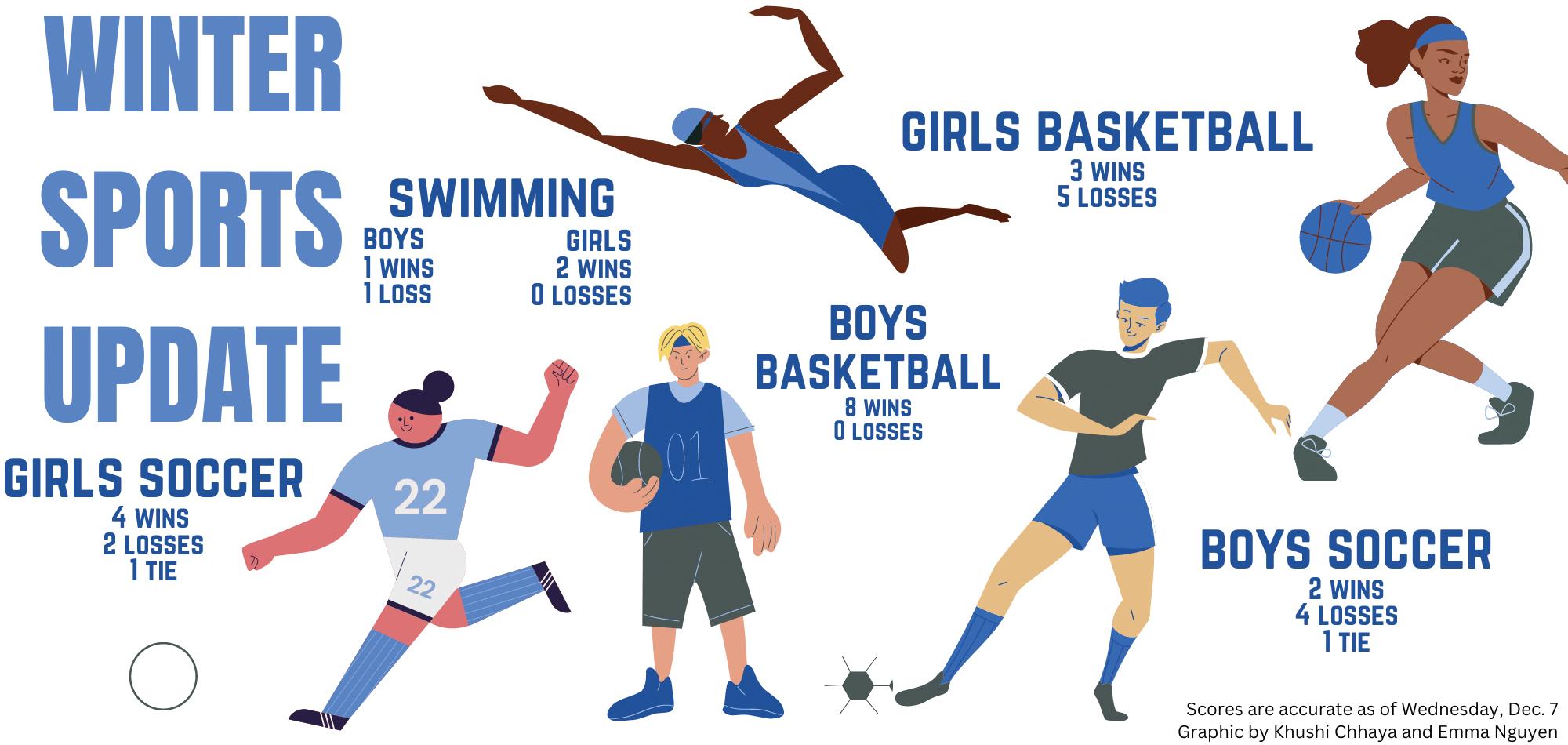
I definitely know and can relate to athletes better because I know what it’s like to have something taken away from you in a split second because of one injury.”
Pappas earned her Bachelor of Science degree from UT Austin in 2020. A er becoming a certi ed and licensed athletic trainer, she began working for Baylor Scott & White Institute for Rehabilitation in Dallas as a contract athletic trainer.
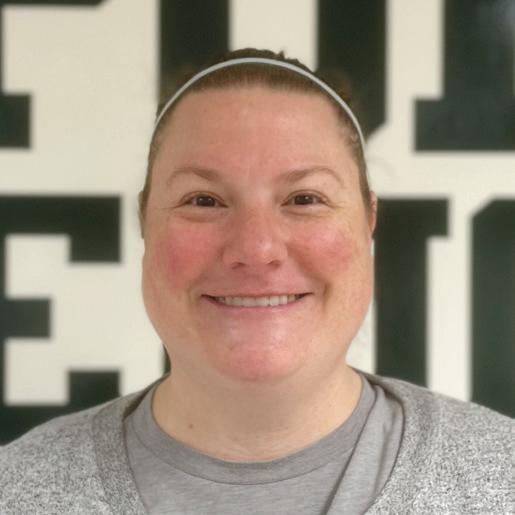
A few months into this position, Pappas decided to pursue a master’s degree at Ohio State University. From August 2021 until last May, she interned with Ohio State’s Strength and Conditioning Department, working with men’s ice hockey, men’s basketball and women’s cheer athletes while completing the coursework for her Master of Science in Kinesiology, Sport Management. Pappas will receive her
She is now working as the second full-time athletic trainer at Greenhill and occasionally helps out with Baylor Scott & White on weekends.
Pappas says she loves the environment at Greenhill.
“It was just kind of meant to be,” said Pappas.
She strives to be a support system for students in their academic studies and athletic activities.
“I love being an athletic trainer because you get to help [an athlete] through their whole recovery process and getting to see them perform again on the eld or court,” said Pappas.
Hands-On Approach
On campus, Pappas has been working alongside Athletic Trainer Kasey Zibton in the sports medicine room. ey bounce ideas o one another and share what they are reading about the latest advances in sports medicine, Pappas said.
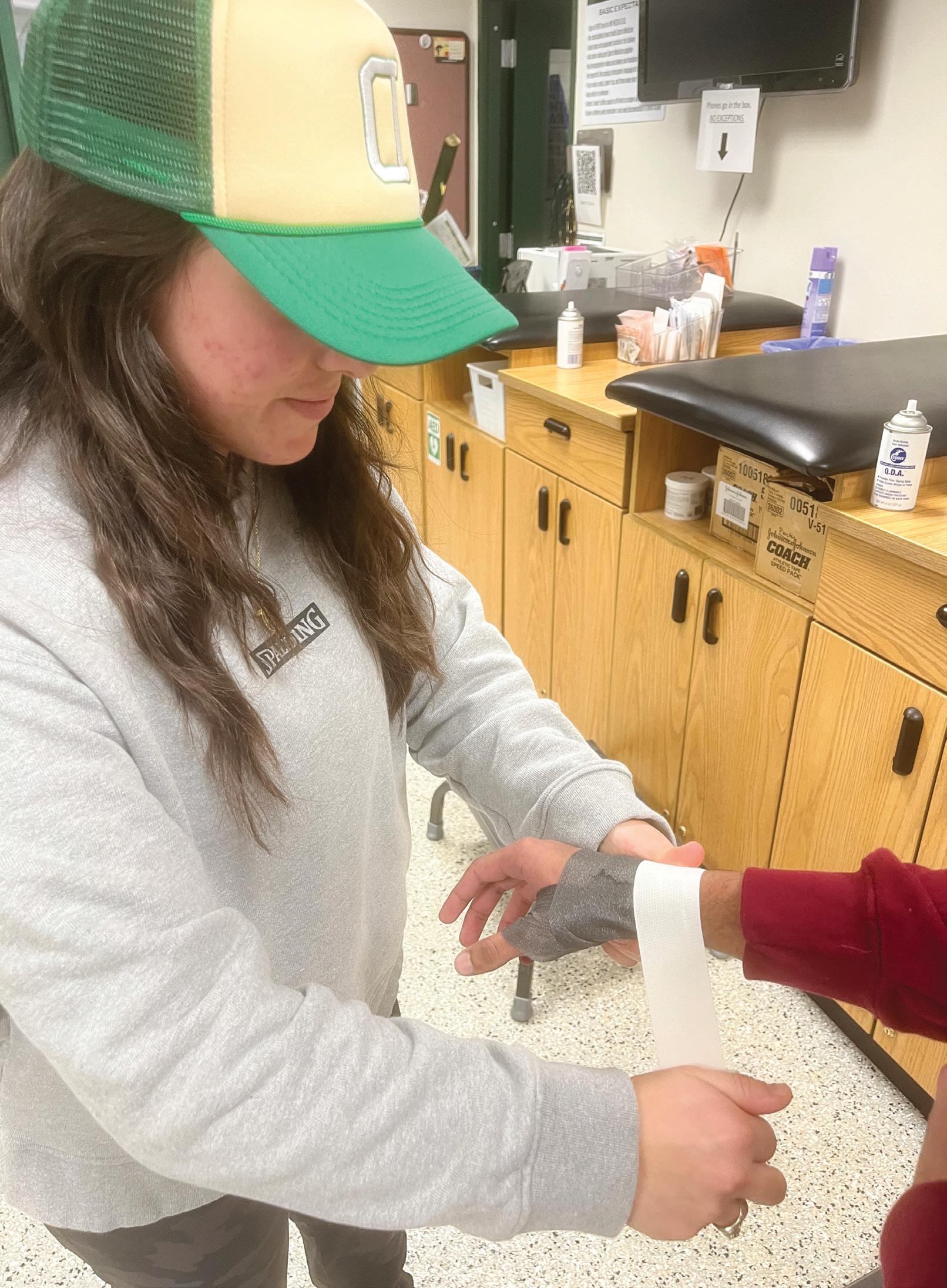
“[Pappas’] skills are wonderful and she brings a positive attitude to work daily,” Zibton said in an email interview.
Pappas says she enjoys getting to watch athletes compete.
“I just really like the days where I’m not just sitting in my o ce,” said Pappas. “I get to be out and with the kids and [enjoy] getting to watch them compete.”
Athletic trainers work with the athlete from the initial point of injury through their return to competition. e most rewarding part of her work is helping student-athletes progress through their recovery from an injury.
Pappas says she connects with students in and out of the sports world through her Greenhill interactions and her younger brother. In addition to relating to injured high school athletes through her own history of sports-related injuries, she enjoys keeping up with sports games and TikTok trends.
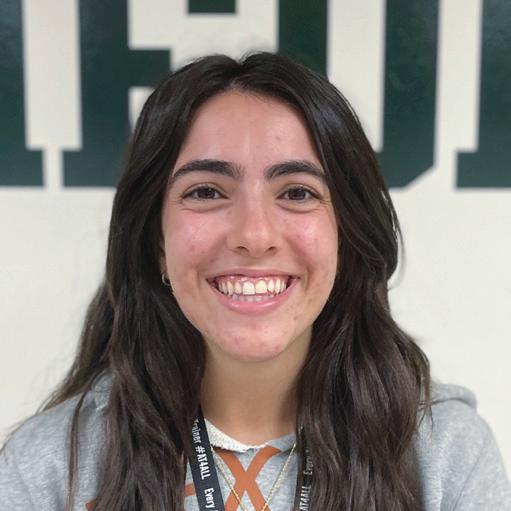
Since arriving on campus, Pappas has embraced Greenhill’s theme for the year: “creating connections.” Students and teachers alike frequently approach her with conversation or eat their lunch outside with her, she said.
Pappas has also spent many a ernoons in the athletic training room teaching students the basics of sports medicine and athletic training. She has sought opportunities to be a mentor for students in their athletic and their academic endeavors, and especially wants to encourage students who are interested in pursuing sports medicine, she said.
Pappas has mentored senior Ash Zhou over the course of the year, teaching them as they explore the world of
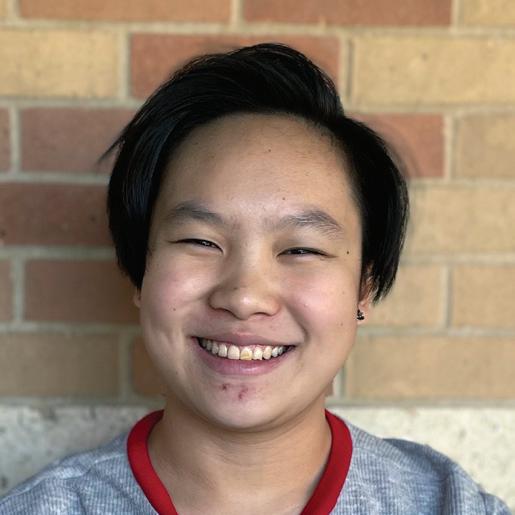
athletic training.
Zhou’s need to ful ll a freshman sports credit turned into a passion over time. Zhou has spent hours watching the trainers and helping athletes with their injuries.
Zhou has taken inspiration from Pappas’ “hands-on” approach to athletic training. Zhou notes that Pappas is close in age to some of the athletes she’s working with, and she has forged personal connections.
“Having [Pappas] there is a very friendly, approachable option for people who it might be their rst time [in the athletic training room,]” said Zhou.
When she is not taping ankles or evaluating an injury, Pappas says she spends time at her church. She enjoys volunteering and attending services and is deeply involved in her faith and community.
“[Church] is the biggest part of my life,” said Pappas. “It keeps me grounded.”
Looking ahead, Pappas says she is excited for Greenhill to be hosting the winter Southwest Preparatory Conference championships in February and getting to work with the school’s spring athletes.
Sports Evergreen the 20
Allie Schnitzer
Aliki Pappas
Ash Zhou
Kasey Zibton
Photo by Chloe Nguyen
REST UP: New trainer Aliki Pappas has bonded with student-athletes while taking care of their injuries.
I love being an athletic trainer because you get to help [an athlete] through their whole recovery process and getting to see them perform again on the field or court.”
On Nov. 20, President Joe Biden turned 80, making him the rst president to reach that age in o ce.
As a 17-year-old, I don’t have the right to vote, but it is disheartening to see the Democratic Party dominated by people who have been in politics for
equality. She has proven that she is not afraid to get her hands dirty in order to ght for what she believes in.
Frost is a U.S. representative-elect for Florida’s 10th Congressional District. He was elected in November at the age of 25, and I’m excited to see his e ect on the party as a whole. Big issues such as abortion rights, gun violence and voting rights are all things that he and I both care about.
Biden served two terms as vice president under President Barack Obama and is midway through his rst term as president. He has had his moment and it’s time for fresh faces like AOC and Maxwell Frost to help modernize the party.
Blalock
The Republican Party’s reputation is rapidly declining, and the political gures who have the platform to rebuild it warrant great alarm within and beyond the party.
Following the shortcomings of the anticipated “red wave” in the November midterms, Republicans like myself cannot help but lose con dence in the future of the party.
Although ostentatious right-wing campaigning is nothing new, the midterms provided concrete evidence that Republicans must evaluate and reform their party from the inside out.
voices of many moderate Republicans when I say this: We must distance ourselves from extremism, and the only way to do so is by leaving Donald Trump behind for good.
Congress as opposed to the 31% that would prefer Republican control.
Although Democrats appeal to young voters, they do not adequately represent these voters once elected.
When Biden was rst coming into politics in 1970, the most radical issues at the time were things like women’s rights, LGBTQ rights, the Watergate scandal and more. As a result, today’s pressing issues, such as the environmental crisis, are put on the backburner.
Staying on top of hot button issues today seems an impossible task for someone who grew up in a vastly di erent generation. e change we need is immediate. Yet, the change seems unlikely when placed in hands of someone like Biden.
Keeping Biden as the face of our party makes it look like Democrats are out of touch. ere are many Democratic politicians who would be better suited to take on the di cult and complex role that is the President of the United States. People like Alexandria Ocasio-Cortez and Maxwell Frost are both young Democratic Party members who thirst for change.
e 33-year-old Ocasio-Cortez has been a champion for social justice and
For a democracy to work properly, it’s important to make politics accessible and understandable to the general population. If people do not know what they are voting for, then they are wasting their vote. e message that Democrats will be sending out if they select Biden once again as their presidential candidate in 2024 is that old white men rule the party.
I understand that the concept of retirement is very di erent when it comes to politics, especially because when it comes to presidential candidates and nominees, the person must be at least 35 years of age; but it is also important to understand that people like Biden were raised in a di erent time.
With 2024 still two years away, I’m not ready to throw out names for the ideal Democratic nominee. What I can say for sure, is that I am looking for a more progressive candidate that prioritizes young voices.
Seeing myself underrepresented in my own party is a discouraging feeling. I want young people to take back their futures. A er all, our future is the one at stake, so our voices, thoughts and opinions should be on the frontline. A younger candidate might be just what the Democratic Party needs at this point.

Shying away from change, however insigni cant or radical it may be, will not get anyone anywhere. We need to start looking at candidates with our best interests at heart because they know what it feels like to be us.
Seats were lost that should’ve been won, and Democratic incumbents won nearly all their races.
An overwhelming number of candidates endorsed by former President Donald J. Trump did not come out on top, including U.S. Senate candidate Mehmet Oz. is was a pivotal race, especially given Pennsylvania’s strong identity as a swing state. One would expect a state this divided to go red when a Democratic President is in power, which makes Oz’s loss speak even more loudly throughout America.
Other races with Trump-endorsed candidates that ended up going blue included key House and statewide races in Michigan, Ohio and North Carolina.
It is undeniable that the Republican Party underperformed severely in this midterm election, and this would probably be considered the worst midterm outcome by a party out of power in over two decades.
While it’s obviously not black and white, I nd it easy to attribute the majority of blame for the decline of the Republican Party to Trump. He le a severe blemish on the party, and he rede ned Republican identity in an extremely aggressive and destructive way.
“Trumpism” is seemingly losing traction, and America has already grown weary of the ashy and trashy spin the former president in icted on American politics.
Although I can’t speak for far-right voters, I think that my voice can represent the

He represents hate and he represents an era of Republican politics that people like me do not want to be associated with. He has exacerbated misconceptions about what it means to be a conservative, and he failed to treat his political platform as a sacred space to make America a better place.
Several candidates seem up to the task of taking his place, and many of them appear to be tired of supporting Trump and respecting his approach to carrying out his political agenda. Notable examples of Trump critics within the party include Gov. Chris Sununu of New Hampshire, former South Carolina Gov. Nikki Haley and former Vice President Mike Pence.
Although these politicians have been somewhat shaky in their criticism of Trump, there is potential for the Republican Party to nd a new, more mature face to rally behind.
e party already has a di cult time appealing to younger voters. I think that the age of prominent gures like Trump creates a gap and a lack of representation for younger, moderate Americans like myself.
Potential candidates for the 2024 presidential race include several candidates under the age of 55, such as Sununu, Haley, Florida Gov. Ron DeSantis and Virginia Gov. Glenn Youngkin.
e point of all this is to say that the Republican Party needs saving. It needs to be saved from itself and the hands it has so swi ly fallen into, sooner rather than later.
A level of class must be brought back to the party, along with a more moderate and thoughtful public image.
Igrew up with summers in Shanghai, swatting mosquitoes at Nai Nai’s house while watching a cartoon or taking a trip to the Bund while devouring a cream popsicle.
Going back to China was more than just a vacation. It was a way of seeing my Nai Nai again and experiencing a place that had been my parents’ home for a period of their lives. Whenever I was in America, I always felt disconnected to Nai Nai and my Chinese roots; going back to Shanghai connected me with part of my identity.
at reality changed once 2020 struck. In light of COVID-19, China transformed itself, and President Xi Jinping enforced a series of harsh lockdowns and vigorously tracked each citizen through a marked color code.
With travel bans implemented by both the United States and China, it became apparent that I was not going back to Shanghai that summer. But what became less apparent was how long this turmoil would last.

rough social media posts and New York Times headlines, I saw the city that I loved morph into a ghost town. Shops closed, and people entered complete isolation in their apartments.
According to CNN, over 300 million
people from over 70 cities across the country have been placed under full or partial lockdown, including 15 provincial capitals and Tianjin which compromise a signi cant portion of the nation’s economy.
Nearly 460,000 businesses have shut down as a result and essential care has been delayed nationwide. is doesn’t even begin to cover the psychological trauma that many across the country have been a ected by as a result of the turmoil of continuous government-imposed lockdowns.
Frankly, Xi’s Zero COVID Policy is not about public health. It is about controlling ordinary people’s lives and performing an act of Chinese dominance.
As someone born and raised in the West, I was shocked by the Chinese people’s initial response to the lockdowns. Despite the nation’s nightmarish landscape, I witnessed a growing surge of national pride.
For many young people in China, they felt that harsh crackdowns would be a victory for the East in terms of COVID management. It would show the West that Xi is not someone to be bridled with.
My Nai Nai would say that this is probably the most patriotic generation of China since the Cultural Revolution, and on the surface, she’s not wrong.
Over the years, a previous admiration for western values of democracy and liberalism had turned into a erce animosity
that was sparked in part by the rhetoric of President Donald Trump’s trade war with China.
But as the ames of pride cooled, new emotions seized the people: anger and pentup frustration. e same young people which had previously been labeled as China’s most nationalist generation had endured enough.
In one of the most public displays of opposition towards the Chinese Communist Party’s leadership, a group of largely young people has recently instilled fear in the world’s most established authoritarian government.
e French Concession in Shanghai had been transformed into a vigil for the 10 victims of an apartment re – a tragedy that protesters say was a result of strict COVID-19 restrictions that prevented the victims from eeing.
Amid anger and frustration, protestors held up a blank A4 sheet of paper. Blank because the Chinese people are voiceless, but never silent.
It’s easy to characterize the Chinese people as blind followers of Xi. But such a mentality is both inaccurate and further perpetuates the false image that Xi’s administration hopes to portray – that everyone in China is united under his leadership.
Contrary to what is portrayed, there does not exist a monolithic Chinese voice. If anything, the recent protests nationwide have shown that even in a society as strictly censored as China, there is a growing sense of opposition, especially among young people. is regime has consistently prioritized the personal acquisition of power over the welfare of the Chinese people.
Beneath China’s glistening story of success and mass economic progress is another story of young people living in a country that seeks to silence their voices – a country still plagued with social economic
Payton
21 Views
Helina Tedros
Valerie Xu
On a typical day, we Upper School students go from class to class, never really leaving the comfort of our routines. e farthest path some of us may travel is from the Upper School buildings to the Science Village, perhaps passing a line of preschoolers on the way.
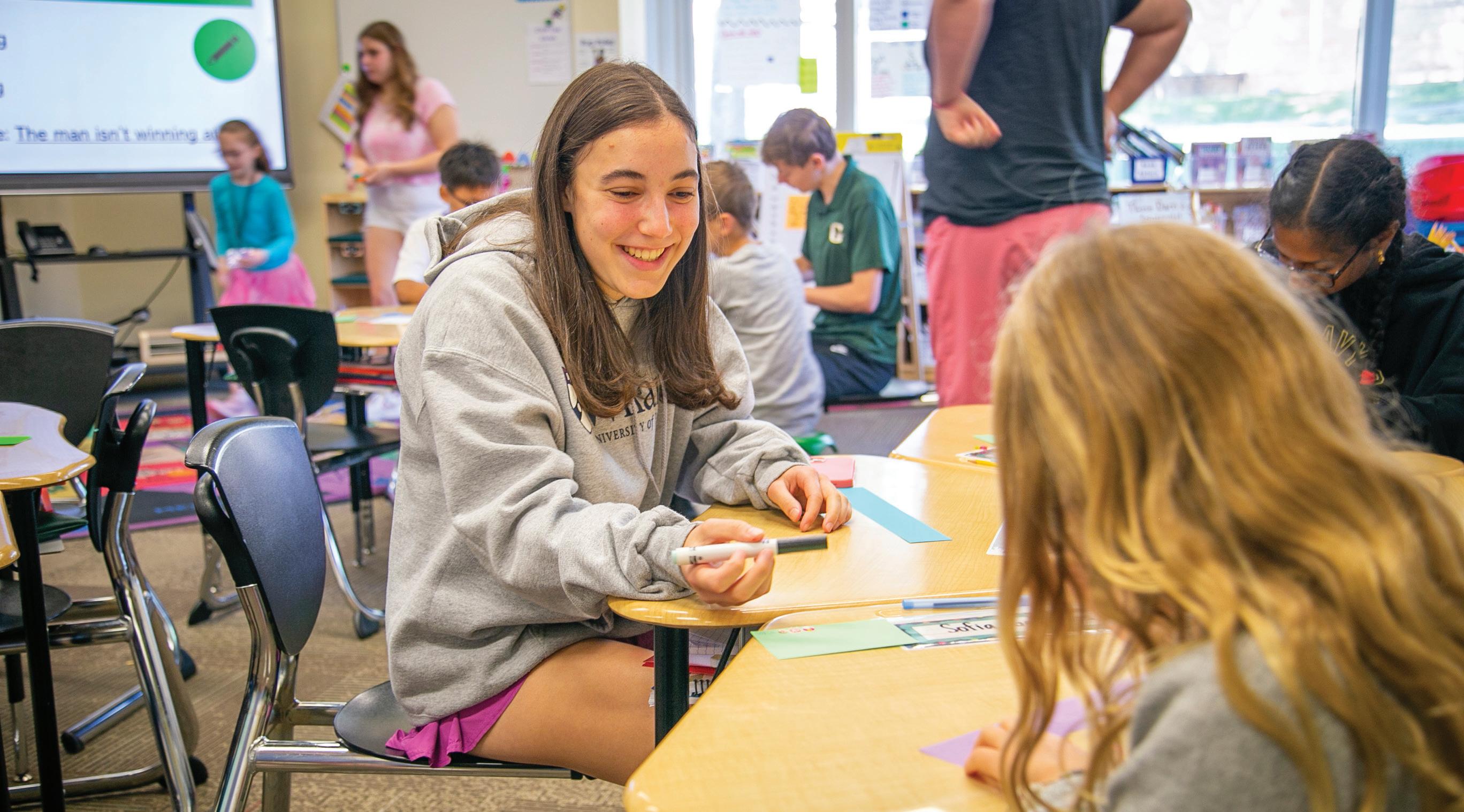
ere’s one welcome disruption to our schedule: Heart of the Hill, where students and faculty from across divisions gather in small groups to share meaningful interactions.
We attend HOH meetings roughly once a month for a half-hour or so, resulting in only a few hours of quality time with other divisions over the course of the school year.
Greenhill’s community is a special one. We recognize and value the diversity in ages and backgrounds that we see on campus. However, many of these students never get the chance to meet. At times, each division feels isolated from the others.
In the Upper School, student interaction is very common. For example, grades 9-12 attend sports practices and participate in ne arts together.
Connections are everywhere within divisions. Being in the same buildings inherently lends itself to more frequent interactions. In order to cultivate relationships between students of di erent divisions, additional steps need to be taken.
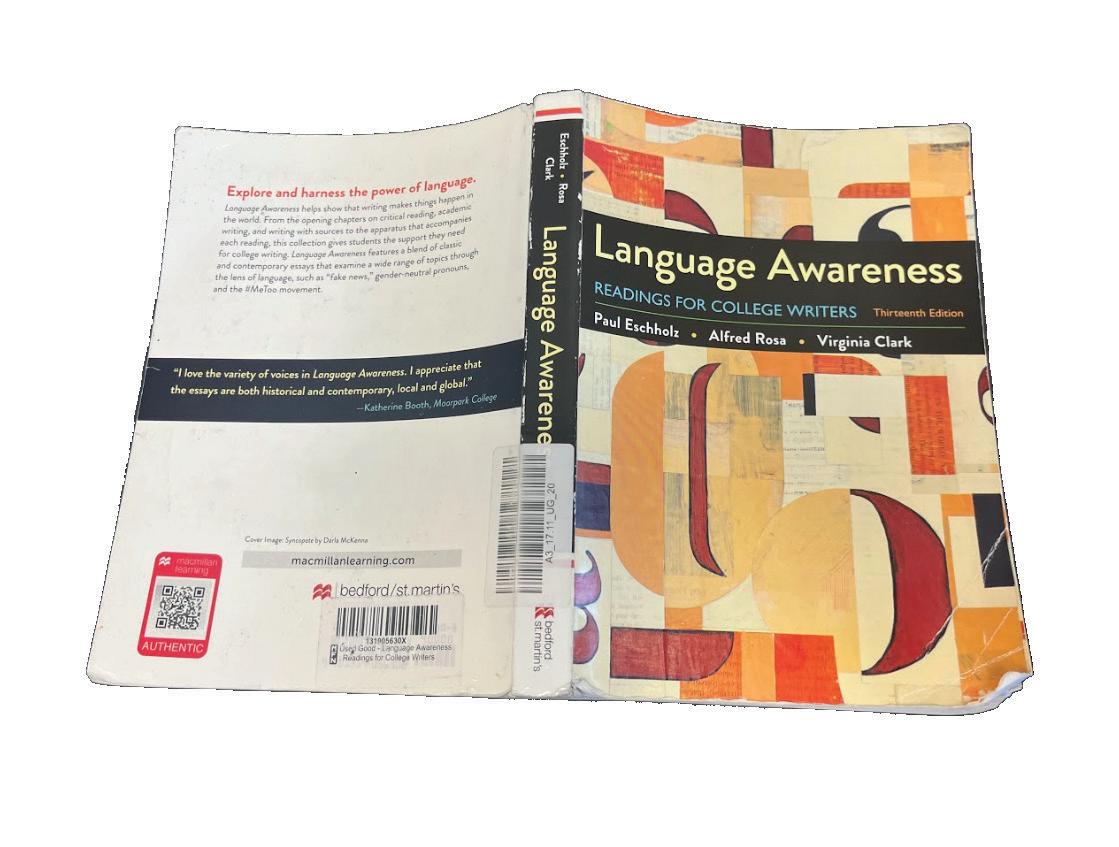
Reintroducing the tradition of HOH since pandemic restrictions have eased has been a welcome return. Organized programming scheduled into our days makes it easy to nd time to bridge the gaps that divide students
from di erent grades.
We applaud the recent e orts of the Greenhill Cultural Arts Committee to engage our entire school in the arts. Particularly, we enjoyed hearing singer/songwriter Remy Reilly perform on the Foote Quad for all divisions on Oct. 19 while spending time with younger students.
e Evergreen believes that some of these schoolwide activities, such as ice cream socials and music on the quad, could be made more frequent to bridge the disconnect between divisions, fostering organic conversation and interaction.
Genuine connections help Greenhill live up to its name – a place where people can
come together, embracing their di erences in the process. Having relationships with older students also provides Lower and Middle School students role models to look up to.
But forming these connections requires time, space and thoughtful planning.
Greenhill’s mission statement supports inclusivity across divisions: “In a diverse and inclusive community, Greenhill prepares and inspires students to lead authentic, purposeful lives.” And the 2022-2023 schoolwide theme is “Creating Connections.” Let’s set aside su cient time so we can create and sustain those connections with younger students across divisions.
Our Editorial Policy
e Evergreen is an independent, student-run newspaper serving the community of Greenhill School. It is printed six times during the school year. Print circulation is 900 copies. Past issues are archived at issuu.com/ghevergreen.
e Evergreen sta upholds a code of ethics that values honesty, integrity, accuracy and responsibility. Our mission is to help the local community interpret campus, local,
national and international events through articles and editorials written and edited by students.
e Evergreen welcomes letters and emails from readers. We reserve the right to edit submissions for accuracy, grammar and length. e Evergreen will not publish material that we judge to be libelous, obscene, invades privacy or constitutes hate speech. Anonymous letters will not be published.
e sta editorial represents the opinion of e Evergreen sta , not necessarily that of Greenhill School.
The Evergreen welcomes advertisements, but we reserve the right to refuse an ad. Business inquiries should be directed to Kaden Alibhai: alibhaik24@greenhill.org Corrections and Clari cations We pledge to correct our errors. To request a correction or clari cation, please email Khushi Chhaya: chhayak23@greenhill.org
Interdivisional Connections Evergreen Sta the Managing Editors - Content Sophia Li Emma Rikalo Pooja Sanghvi Valerie Xu Managing Editor - Design Emily Hu Creative Director Helina Tedros Associate Editor Ria Agarwal Arts Editors Daniela Hallack and Varun Mukund Features Editors Sydney Chien and Riya Kommineni Sports Editors Aman Jaleel and Chloe Nguyen Views Editors Gabi Appel and Aria Kutty News Editors Evie Kwei and Christan Park Editors-in-Chief Khushi Chhaya and Ivy Stitt Executive Editors Ava Iwasko and Emma Nguyen Evergreen Print Cross Platform Chief Sta Photographer Chloe Nguyen Sta Photographers Cole Feldman Evie Kwei Christan Park Milyon Esayas Nora Ahearn Jacquelyn Dishman Social Media Editors Ethan Vicknair Cole Feldman Advisor Gregg Jones Assistant Advisor Amy Bresie Have a response? Opinion? Original Idea? Email the Editors-in-Chief chhayak23@greenhill.org stitti23@greenhill.org Business Manager Kaden Alibhai Views Evergreen the 22
to Be Succesful: Nature and Uses of Language
Advertisements
Editorial: More
How
HEART OF THE HILL: HOH groups allow students from di erent divisions to build relationships with one another through monthly meetings and various activities. Photo courtesy of Greenhill Communications
Gabi Appel
& Rants Raves
A RAVE to the musical. It turned out better than a Broadway show! e tireless e ort the cast and crew put forward really paid o in an incredible production. e audience laughed, cried, and enjoyed every moment of the songs and stories!
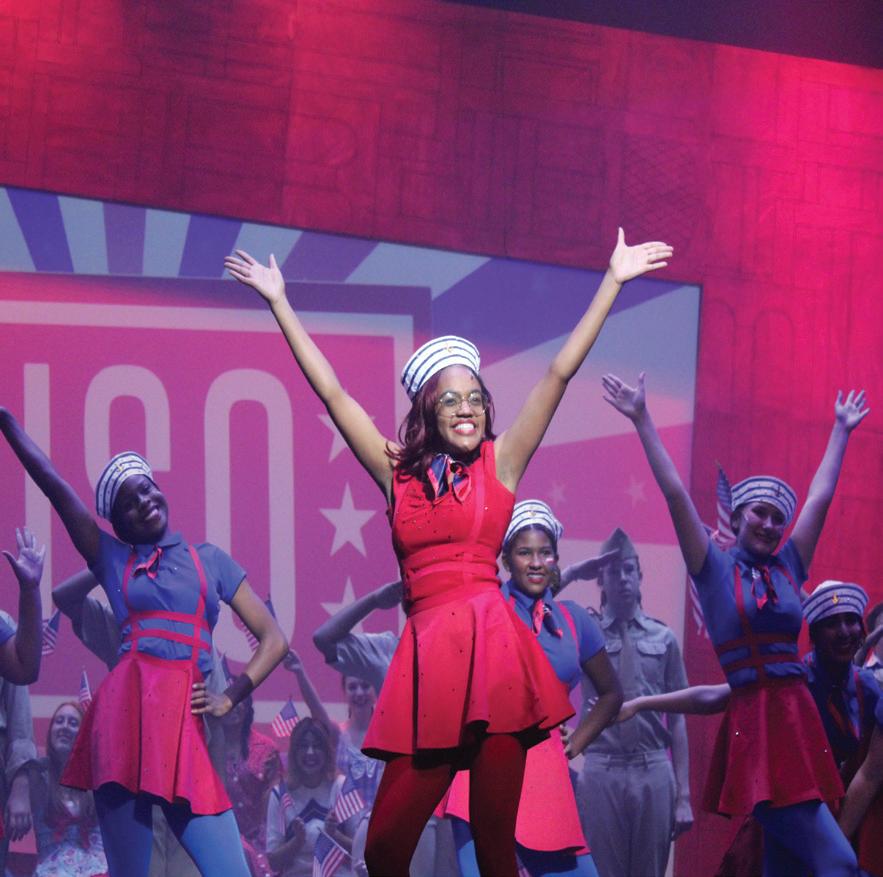
A RANT to the amount of work we get right before December break. ese three weeks are some of the most stressful and tiring weeks of the school year. We have a nice anksgiving break to relax and prepare for the 40 projects, 27 tests and a million assignments we can expect in those next couple of weeks. It’s been a race to the nish line!
A RAVE to seasonal traditions like the holiday sing-along and cookie decorating. ese events bring so much joy to Greenhill to nish o the few hectic weeks before December break. Every year we love having these fun opportunities to let loose and enjoy the season.


A RANT to the mile-and-ahalf test. Yes, we get it, it’s an e ective way to check your tness level. Still, it’s rough. Period. Nothing hurts more than the extra two laps at the end of the mile. It’s especially annoying when we have to run it in the morning before school.

A RAVENT to the STEM + Innovation Center’s construction process. While the progress made in the past few weeks has been exciting, it’s hard to believe that the building will be completed on its projected date of completion. It’s been super cool to see the wooden frames go up – it’s really starting to feel like a building!
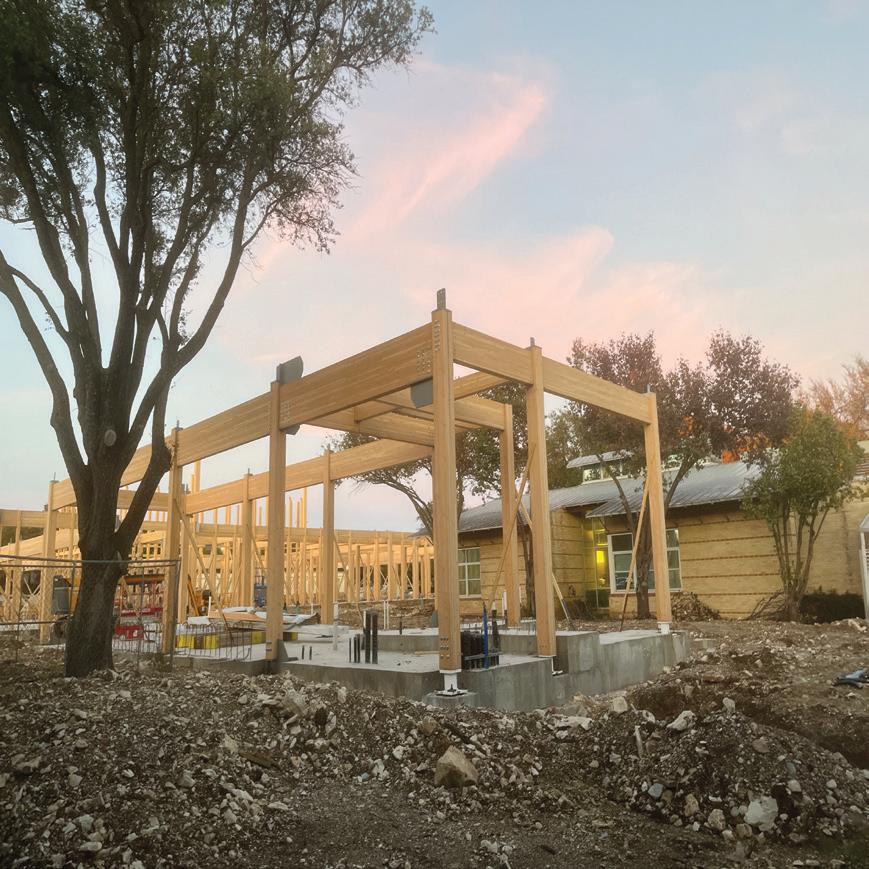
A RAVENT to the World Cup. We love how Mr. Oros organized watch parties for the games during Hornet Block! It was so much fun cheering on our team with our friends. However, in the last three years we have forgotten how stressful the World Cup is!

A RAVE to hot chocolate at e Buzz that brightens what can sometimes be a gloomy season. It’s both a nice, sweet treat and keeps you warm when the weather takes a sharp turn as it has these last few weeks. If you ever need a sweet pick-me-up, e Buzz has your back.
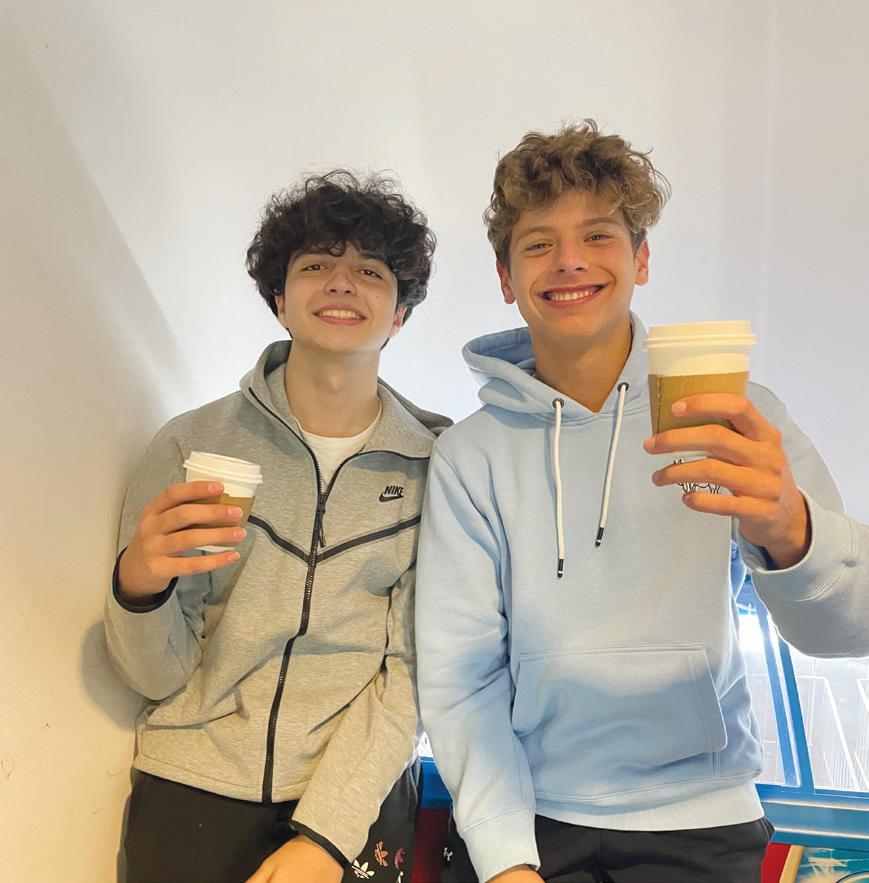
A RANT to the lack of a science resource like the Math Lab. We love the Math Lab and could use one for science too! With physics, chemistry, and biology tests, lab write ups, and lots of new material, a place to easily get help would be much appreciated. If any of you science whizzes would like to start a tutoring program, we would support you!
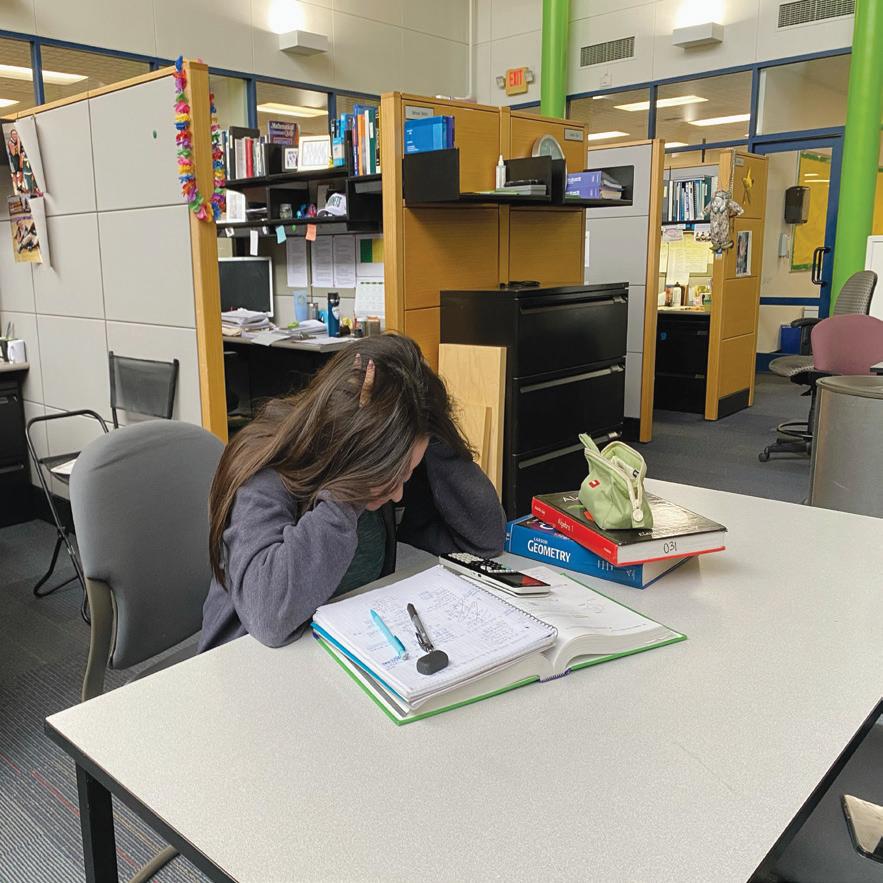

A RAVENT to the wintry weather. While we love drinking hot chocolate and bundling up in layers, the buildings seem SO cramped! It feels like anywhere you go, there are a million people sheltering from the cold, and the recent rain hasn’t helped.
Guest Essay: e Shocking Relevance of Singapore’s Criminal Justice System in Texas
Dibyadeep Saha
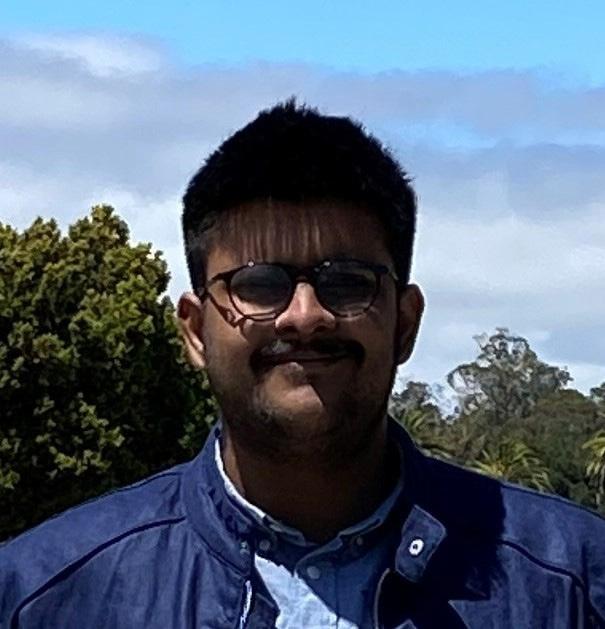
Across the span of less than half a century, Singapore has stunned the world with its rapid ascent from a backwards shing village to the global nancial and economic hub it is today.
But there has been a dark side to this progression from the ird World to the First: a awed criminal justice system that has o en done more harm than good, despite the country’s low crime rate.
Many of these exact issues plague the state of Texas. is isn’t a new problem, though; an infamous example of Singapore’s “tough on crime” legal system would be the 1994 case of American teenager Michael P. Fay, an 18-yearold Singapore American School student who was sentenced to four months in jail, a S$3,500 ne and six strokes of the cane for vandalizing cars and stealing road signs.
e harsh verdict garnered so much media attention that then-President Bill Clinton appealed to the Singaporean government for clemency.
Singaporean authorities ultimately reduced the sentence from six cane strokes to four, and Saturday Night Live memorialized the incident with a cold-open skit of Fay’s caning on Episode 18 of Season 19.
But the issue is no laughing matter, due to the precedent set by Singaporean criminal law for petty crimes. Section 379 of the country’s Penal Code makes simple the an o ense punishable with up to three years of imprisonment and/or nes.
Similar problems are shared by the Texas judicial system too. For example, nonviolent crimes (such as larceny or bribery) can land people in prison for decades in this state, whereas many other states hand out little more than a slap on the wrist. is is especially problematic for people of color, given that African Americans are incarcerated at a rate seven
times greater than for white Americans in Texas, according to the Justice Policy Institute.
Although many – not least the founding father of modern Singapore, Lee Kuan Yew – have argued that such severe penalties act as a deterrent against increased criminal activity, the nightmarish reality paints a di erent picture.
By having any misdemeanor appear on one’s permanent criminal record, the current system hampers an individual’s chances of employment and economic mobility. With Singapore and the Dallas-Fort Worth metroplex being the home of 5.45 million and 7.76 million people, respectively, this becomes all the more an obstacle because of the massively competitive job markets.
Perhaps the most signi cant aw of all, though, lies in Singapore’s repeated use of capital punishment – a chilling practice it shares with the state of Texas. In Singapore’s case, 400 people were executed from 1991-2004 for either murder or drug tra cking. On the other hand, 578 people have been executed for murder charges in Texas since 1982.
In both places, the lack of mercy shown to the mentally ill or intellectually disabled exacerbates an already unfortunate situation. is systemic fault was recently brought to light again with the case of Nagaenthran K. Dharmalingam, a Malaysian man with an IQ of 69 who was found guilty of tra cking 43 grams of heroin into Singapore in 2009 and executed last April.
e fact that an intellectually challenged individual coerced into tra cking drugs had his life ended despite the punishment violating international human rights law points to the drastic need for an update to the antiquated system that exists today. And since Texas faces a near-identical issue regarding the treatment of mentally ill individuals convicted of murder, we, too, must demand the revamping of a criminal justice system that is direly stuck in the past.
Fortunately, there is hope on the horizon – both
for Singapore and for Texas. In November 2012, capital punishment regulations were modi ed in Singapore such that judges could grant life imprisonment with the possibility of parole a er 20 years in murder cases, as opposed to always defaulting to the death penalty. And with continued social activism in recent years, there have been talks among government o cials about applying similar measures for drug tra cking cases too.
As for Texas, the state legislature is currently considering a “second chance” bill (HB 3392) that would allow those who have served 15-20 years in prison to be eligible for an adjusted sentence, thereby giving many inmates the chance to start over in life.
All that being said, there is still plenty that can be done to ameliorate the current situation, from abolishing the death penalty to preventing lesser crimes from being listed on one’s permanent record. And if neither Texas nor Singapore pays heed to the ideas suggested by activists the world over, that is a failure of democratic principles.
Views Evergreen the 23 Wednesday, December 14, 2022
of Dibyadeep Saha
Photo courtesy
Navigating the College Process
Khushi Chhaya, Ava Iwasko, Emma Nguyen
With January quickly approaching, so are the next round of college application deadlines for many students.
roughout the summer and fall, seniors have been researching their college lists, writing essays, applying for scholarships and meeting with their college counselors, in addition to keeping up with rst semester schoolwork.
College applications typically come in two waves. Early applications are due in November and regular applications are due in January. However, some colleges may have rolling admissions where applications are constantly being reviewed as they are received, or other deadlines under various names.

Each college also comes with a speci c set of requirements, making the application process unique for every senior.
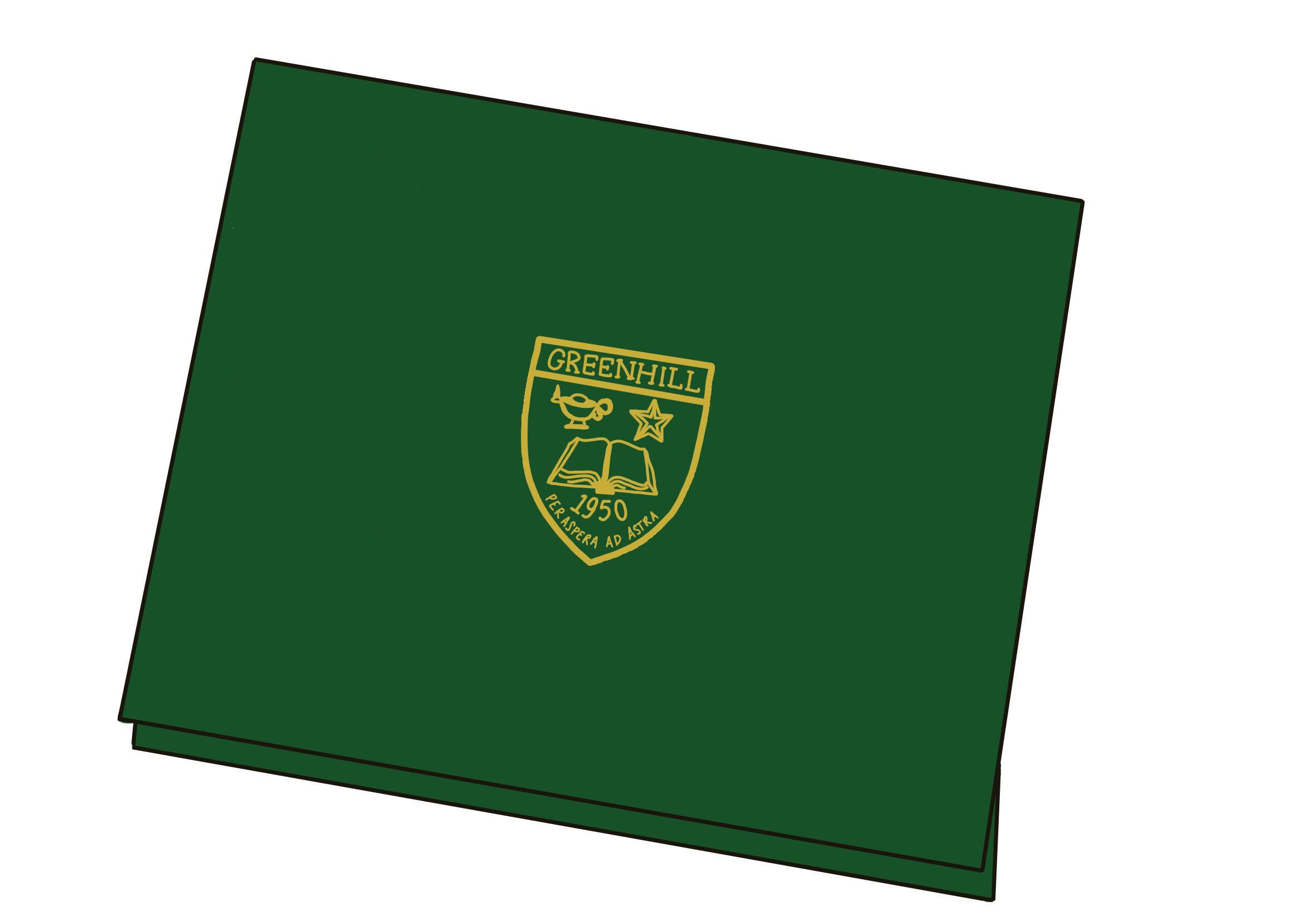
Some have several college-speci c essays while others may have none. Di colleges may request that test scores be sent in a speci c way or have di erent protocols for scheduling interviews. Each senior is responsible for knowing what their colleges expect of them, adding a level of independence to the process as well.
At this point in the year, every senior is at a di erent place in their college journey. Some have verbally committed to certain schools to play sports. Some have applied and received Early Decision or Early Action decisions from colleges that they applied to earlier in the fall. Some may not have submitted any applications yet and are waiting for their January deadlines to arrive.
e Evergreen asked seniors to share their thoughts on the college application process and advice for younger students yet to experience the college quest.
It’s been a long, stressful process, but starting in the summer makes so much of a difference. Getting my first major essay done really early set me up for a good, productive semester.”
I’m just making sure if I need to do anything for a college that I set aside time for that separately from homework. As far as dealing with stress with getting in, I’m just trying not to think about it because whatever happens, happens. I can’t speed up time to know if I get in or not.”
- senior Ellie Thomas-Dietrich
Right now, I’ve had a lot of stress taken off of me after the Nov. 1 deadline because most of mine were due then. Now I’m just in the waiting time of this process.”
- senior Emily Quinn
The advice that the college counseling team will give you, and the most important advice I have, it not to compare yourself to your peers. It is easy to get caught up in what everyone else is doing and start comparing schools and how far they have completed their essays in comparison to you, but that will only slow you down.”
 - senior Viraja Metta
- senior Viraja Metta
“Write your essay over the summer and fill out the main Common App stuff because it’s just filling out your family stuff and basic information that you should have. If you get all of that done, September is going to be very easy for you because you’ll just have more time to write supplementals.”

- senior Ellie Thomas-Dietrich
Make sure you like every college on your list. It really relieves the stress of worrying about whether you’re going to get into your first choice if you love all of the schools you’re applying to.”
- senior Ella-Rose Levy
It’s important to use your breaks effectively. I had most of my work that I had to do in the fall, so I used a lot of time in the summer to get a head start on things, and that was very helpful. I’m very grateful I did that because that relieved a lot of the stress in the fall. But obviously things come up and it all piles up, especially [because I’m] taking hard classes this year. It’s a lot to balance, but you’ve got to just push through.”
- senior Ella-Rose Levy
The college application process has been stressful; however, it goes by quickly before you even have a chance to realize it. It is amazing that the application process is almost ending, and I know the work we have all put in will be worth it.”
- senior Viraja Metta
the Evergreen 24 Backpage Wednesday, December 14, 2022






























 Khushi Chhaya, Ava Iwasko, Emma Nguyen, Ivy Stitt
Khushi Chhaya, Ava Iwasko, Emma Nguyen, Ivy Stitt



 - junior Andy Simpson
- junior Andy Simpson
 Ria Agarwal, Daniela Hallack
Ria Agarwal, Daniela Hallack
















 Sydney Chien
Sydney Chien
 Varun Mukund
Varun Mukund

















































 - senior Viraja Metta
- senior Viraja Metta
